
Ringlet on a white marjoram; butterflies are one of the most conspicuous diners in your hotel restaurant.
THE TOP 500 GARDEN PLANTS FOR WILDLIFE
This topic absolutely fascinates me, and I’ve been immersed in it for over 15 years now. Like many gardeners, I love growing plants and I think they’re endlessly fascinating, but I want to fill my garden with those that I know are going to do great things for wildlife as well as look wonderful.
But I have a confession – there is no such thing as the ‘top however many plants for wildlife’. A plant that is favoured by one species is often pretty useless for another and vice versa. It means that making the case as to why one plant is better than another in general wildlife terms is quite difficult.
There is another problem. The RHS lists some 70,000 or so different types of garden plant in cultivation in Britain. To research the wildlife value of each of those would take decades. In fact, the number of scientific studies that have been done so far is tiny, and when it does happen it tends to focus on those most visible and popular wildlife groups such as butterflies or – in recent years – bees.
Even those studies that have been done, great though they are, would need to be replicated in other parts of the country and on other soils and conditions to be sure that the results are reliable.
It means that almost no research has been done, for example, into the value of garden plants for moths (whether adults or caterpillars). We also don’t know the relative value of native trees versus related non-native species grown in gardens. And we’re not even sure which garden plants produce the best or most nutritious seeds for birds. As the Wildlife Gardening Forum has so eloquently set out, there is more that we don’t know about garden wildlife than we do.
But I’d like to think that I haven’t lured you here under false pretences. What I’ve tried to do is select those plants that will offer you visible, exciting results. Inevitably, the list often veers towards plants that are enjoyed by those groups of species we are naturally drawn to and can readily observe, such as birds, butterflies and bees, but I’ve also included plants for moths, beetles, weevils, hoverflies... Some ‘less appealing’ creatures might take issue with my plant choices, but I’ll just suffer their indignation.

Ringlet on a white marjoram; butterflies are one of the most conspicuous diners in your hotel restaurant.
I have also concentrated on those plants that most people actually want to grow, ones that look great and behave nicely as well as having appeal for certain creatures. But I did finally capitulate and include some garden ‘weeds’ that, while aesthetically leaving something to be desired, are guaranteed winners for plenty of wildlife. If you can find somewhere suitable to let them grow, then great, even if they might make some gardeners wince.
Almost every plant listed is one for which I’ve had personal experience, based on my visits to dozens of gardens across the country. I’m also greatly indebted to Marc Carlton, creator of The Pollinator Garden website and fellow Trustee of the Wildlife Gardening Forum, who has commented on all of my recommendations. But there are definitely more plants out there doing more great things for wildlife that neither Marc nor I have yet discovered. If you have suggestions, I’d love to hear from you.
I have listed plants alphabetically by their vernacular names if they are in common usage, even though their scientific name might also be widely used. For those who love Latin and Greek, don’t worry, every name is listed in the index.
I’ve also indicated where plants come from to help those who would like to plant flowers local to them. You will see some species listed as archaeophytes – these are plants that aren’t strictly native but which arrived in the British Isles before AD1500, and many probably arrived with early settlers thousands of years before that. Turn to here for more explanation of why ‘native’ is often but not always good, and why ‘non-native’ can sometimes be just as good – I adore my non-native, wildlife-friendly plants!
Star rating
* You’ll see that some of my choices are starred. These are plants that have some key wildlife species associated with them or that appeal to a wide range of creatures, such that no garden should be without them (if there is room of course!).
Quantity as well as quality
When choosing which plants to grow for wildlife, it is just as important that you consider how many you are going to grow, and how you assemble them into ‘habitats’. Just as one house doesn’t make a town, so one tree doesn’t make a wood and one daisy doesn’t make a meadow. Many types of wildlife don’t just search for a particular type of plant – they will only move in if you’ve got a glut of them.
It means that planting in drifts is definitely ‘in’ as far as wildlife is concerned, whereas ‘dot’ plants – just one of each – won’t usually cut the mustard. Even for bees or butterflies feeding on nectar, they are going to be much happier if they can step from flower to flower rather than having to search for every sip: if you want to be a five-star hotel, provide a banquet, not ‘nibbles’.
Singles vs doubles
You may have heard the ‘rule’ that single flowers (those with a single ring of petals) are good for wildlife but ‘doubles’ (those with double rings or more of overlapping petals) are not. There’s quite a bit of truth in this, but there’s a bit of nuance, too. You see, I could name you lots of ‘double’ flowers, such as various dahlias and Michaelmas Daisies with double rings of petals, that you could grow and are likely to be full of pollinating insects.

‘Double’ flowers like this dahlia might look nice, but if you were a bee you’d be wondering where the food is. The answer? There isn’t any!
So here’s the problem. Flowers tend to have a structure based on circles: in general, in the middle is a ring of female parts, surrounded by rings of male parts (where the pollen is made), then a ring of petals, then a ring of sepals on the outside. A ‘double’ flower is one where breeders have selected plants where one or more rings of sexual organs are replaced by petals. If you think that each petal is replacing a structure that would have produced food, then you can see why the more rings of petals mean the worse the flower is for wildlife.
Hybrids – beauty or beast?
You may have heard it said that hybrid plants are no good for wildlife. This ‘fact’ is definitely mired in detail. Again, I could name you all sorts of hybrids that have very clear value for wildlife. For example, one of the features of some hybrids is that they are sterile (they don’t set seed), meaning that the plant endlessly flowers because it hasn’t had the signal to stop and produce seeds. But you might then spot a problem: while such plants are good for pollinators, the seed-eaters go hungry. In summary, hybrids are a mixed blessing, but the best can still have plenty of wildlife value; it is more the plants that have been highly modified by selective breeding which tend to have lost their wildlife value.
The law and wild plants
The basic situation is that it is illegal in the UK to intentionally uproot any wild plant without the permission of the landowner. You are not breaking the law by collecting their seed, although you should only take a few and leave plenty. However, there are a few species that are so rare it is also illegal to pick the flowers or take the seed. If you want to Google them, the Joint Nature Conservation Committee lists them online as ‘Schedule 8 plants’.
Large trees
If you’ve got the space to grow a large tree (or several), they bring such a wealth of habitats and such a volume of food and living spaces that they are a must. Just be careful to consider the space they (and their roots and shade) will ultimately occupy – most of these trees in this section are for large or very large gardens only.
* Alder Alnus glutinosa
Native throughout the British Isles, a medium-sized, upright tree to 28m that likes wet ground. The leaves are eaten by caterpillars of many garden moths including the May Highflyer. Alder is also important for the Parent Bug, which is unusual in that it cares for its young. Alder flowers are wind-pollinated and the resulting ‘cones’ contain vital winter seeds taken by finches, especially Siskins, Lesser Redpolls and Goldfinches. Unfortunately, some Alders succumb to a deadly water-borne disease, Phytophthora. Avoid the invasive Italian Alder A. cordata.

Ash Fraxinus excelsior
Since the first edition of this book, the terrible ash dieback disease (Chalara) has swept across parts of Britain, meaning that you won’t be able to buy Ash trees, probably until a proven disease-resistant strain is available. However, you may well still have existing Ash trees in your gardens. Healthy, this deciduous tree can reach 30m with a rather open structure; it is native throughout the British Isles and found on most soils. The caterpillars of a few moths such as Ash Pug, Lilac Beauty, Dusky Thorn and Tawny Pinion eat the foliage. The fruits – hanging bunches of ‘keys’ – are taken by Bullfinches and Greenfinches. Ash is late to come into leaf, allowing a long spring-flowering season on the ground below, and it can be coppiced to keep it to a manageable size.

Beech Fagus sylvatica
An imposing and spreading deciduous tree to 40m, best known for its beautiful autumn colours, native to south-east England but widely planted elsewhere. The seeds (beechmast) are highly desirable to many mammals and birds, especially Great Spotted Woodpeckers, Great and Coal Tits, Nuthatches, Jays, Blackbirds, Siskins, Chaffinches, Bramblings and Woodpigeons. Beech trees only start to produce seed at about 40 years old, and the size of the crop varies year on year. Some insects are associated with the tree, including the caterpillars of September Thorn and Barred Sallow moths. However, the dense summer foliage of a mature tree means that little can grow beneath it. They can be pollarded but not coppiced. (Also see Hedges.)

* Birches Betula
Many different species are grown in gardens for their attractive white bark. Silver Birch B. pendula (above) and Downy Birch B. pubescens are both native across most of the British Isles, with Silver preferring better-drained soils and Downy able to cope in the wet. They grow tall, but are slender and airy, and can be coppiced if necessary. The soft timber is perfect for Great Spotted Woodpeckers to excavate holes. The foliage is eaten by many moth caterpillars including the Poplar and Lime Hawkmoths, Scorched Wing and Canary-shouldered Thorn. Other munchers include beetles, bugs and Birch Shieldbug and Birch Sawfly larvae, and then the seeds are eaten by many birds including Lesser Redpolls, Goldfinches and Siskins. The light shade they cast means that plants can be grown beneath their canopy, and you may even be lucky enough to have some of their associated fungi appear, the most famous being the Fly Agaric. Many other birches are available for sale, with Himalayan Birch B. utilis var. jacquemontii with its gleaming white trunk and Paperbark Birch B. papyrifera being especially popular. However, quite how they measure up in wildlife terms to our natives isn’t well known.

Cypresses Cupressus and their hybrids
These evergreen conifers have scale-like leaves and small cones, and are grown widely for hedging and screening. In fact, they can be so tall, fast-growing, moisture-hungry and shade-casting as to cause many an unneighbourly dispute. But I feel I must include them, in part because they are so widely available – ubiquitous, even – and also because they provide good cover for birds, including as a favourite nesting site for Greenfinches. The foliage harbours a few small insects, teased out by Goldcrests, while the caterpillars of the Cypress Pug, Cypress Carpet and Blair’s Shoulder-knot moths feed on the leaves. Big trees may be used by roosting Greenfinches and Blackbirds or by a noisy mass of Starlings. However, I wouldn’t advocate the infamous Leyland Cypress x Cupressocyparis leylandii which lives up to its brutish reputation, grows faster than you’ll be able to keep on top of, and then blows over by the time it gets to about 30 years old. There’s a problem, too, with the equally common Lawson’s Cypress Chamaecyparis lawsoniana which is now on Schedule 9 of the plant species to be avoided. So seek out something such as one of the slow-growing cultivars of Monterey Cypress Cupressus macrocarpa, such as the encouragingly named ‘Goldcrest’. In other words, don’t dismiss cypresses as useless for wildlife (they’re usually much better than no cover), but choose them carefully and grow them responsibly.

Elms Ulmus
I debated hard whether to include the elms, given the tragedy of Dutch Elm disease. An introduced fungus (originally from Asia, not Holland!); it swept across the British Isles during the late 1960s and 1970s, infecting an estimated 30 million trees that were once such a glorious and prevalent species across large parts of Britain. In English Elms Ulmus minor, the roots survive, sending up lots of young saplings from suckers before they, too, are knocked back by the disease; the Wych Elm Ulmus glabra also often survives as young trees, enough to set seed. While the wind-pollinated flowers and winged seeds offer little value to wildlife, Elm leaves are the only food of the White-letter Hairstreak butterfly as well as many species of moth. Moves are afoot to develop disease-resistant strains of Elm, and it is now possible to buy saplings to try.

Handkerchief Tree Davidia involucrata
Here’s a novel option to try that will be a talking point in spring. From China, it is a spreading deciduous tree that grows to 15m or more, and is hardy across much of the British Isles. In spring, its nectar-less flowers have two large and curious drooping white bracts, making the tree look as if draped with handkerchiefs, also giving it its alternative name, the Dove Tree. I include it partly because the tree’s structure makes for good perches, but mainly because the brown, plum-sized fruits (above) stay rock hard into the winter and are often still in place ready for when Fieldfares come to visit in hard weather.

Maple, Norway Acer platanoides
Although not native to the British Isles, the Norway Maple is widely planted, very hardy, and originates across a large swathe of Europe including parts of France. It grows quickly, and can reach 30m tall. The acid-yellow flowers emerge in early spring before the leaves and fill the tree with zingy early colour; they are excellent for early pollinating insects. A number of small insects are also associated with the leaves and bark, but the winged seeds don’t offer much wildlife value, so see it as an interesting alternative to Sycamore.

Hornbeam Carpinus betulus
Tall deciduous tree, to 25m, native to south-east England but planted widely throughout much of the British Isles. The wind-pollinated flowers are of little wildlife value, but the clusters of seeds with their papery bracts (on mature trees only) are taken by birds such as Chaffinches, Bramblings, Great Spotted Woodpeckers and Nuthatches, although you’ll have to cross your fingers hard if you hope to be visited by the real Hornbeam aficionado, the Hawfinch. The corrugated leaves turn yellow in autumn but are only eaten by a few moth caterpillars. It will, however, grow in most soils, and it coppices well. (Also see Hedges.)

Larch (European) Larix decidua
I have retained this in the list, but the critical thing to understand is that it is now at risk of the Phytophthora ramorum pathogen, which you may have heard by the name of ‘Sudden Oak Death’. Larch had been introduced to Britain by 1629 and is now widespread; it is a fast-growing, deciduous conifer to 40m, native to the Alps, with a straight trunk and graceful, drooping branches. The wind-pollinated flowers have little value for wildlife, but the seeds within the small cones are favoured by Lesser Redpolls, Siskins, Goldfinches, Bramblings and Chaffinches, while the foliage is eaten by the Larch Pug moth. The needles turn golden in autumn, and the fresh spring growth is an energising fresh green. If you are thinking of growing it, check on forestry.gov.uk for the latest disease advice, and certainly don’t plant Japanese Larch L. kaempferi, which has been shown to host fewer insects than the European species.

Limes Tilia
The Small-leaved T. cordata and Broadleaved T. platyphyllos Limes are natives of England and Wales, and their hybrid, the Common Lime T. x europaea, is rare in the wild but widely planted. All are big, domed trees, up to 46m high in the case of Common. The July flowers smell glorious and are pollinated by insects. The leaves are eaten by several moth caterpillars, including the thorn family and Lime Hawkmoth, and also by masses of aphids, producing lots of honeydew that is then drunk by various creatures. The fruit is a hard nut occasionally taken by a few birds such as Greenfinches. The trees can be pruned repeatedly and hard.

* Oaks Quercus
The oaks have an impressive reputation for wildlife, and quite rightly so. Growing up to 38m, these mighty trees offer countless homes for wildlife and mountains of palatable leaves and acorns. They are slow to grow, but see them as an investment for future generations. The two common species are Pedunculate Oak Q. robur and Sessile Oak Q. petraea (above), both native across almost all the British Isles, with the Sessile preferring acidic soils. Acorn lovers include Jays, Woodpigeons, mice, Badgers and the Acorn Weevil, while caterpillars of dozens of moth species feed on the foliage including the Oak Hook-tip, Oak Lutestring, Oak-tree Pug and Merveille du Jour. Plagues of Winter Moth and Green Oak Tortrix moth caterpillars offer rich pickings for tits, Treecreepers and Nuthatches. The acres of deeply-fissured bark offer homes to all sorts of bark beetles, weevils and spiders, while gall-forming midges, mites and wasps disfigure leaves and acorns, and Great Spotted Woodpeckers drill nesting holes. Avoid Turkey Oak Q. cerris from southern Europe and Asia, whose catkins support a species of gall-forming wasp which then goes on to affect the acorns of our native oaks. Avoid, too, the evergreen Holm Oak Q. ilex, which is proving to be invasive.

Poplars Populus
Two species of poplar are native to the British Isles: the widespread and rather wispy Aspen P. tremula, found on many soils and growing to 20m, whose small leaves tremble in the slightest breeze, and the mighty but rare Black Poplar P. nigra, native to much of lowland England, Wales and parts of Ireland, growing to 38m, usually near water. However, the Lombardy Poplar P. n. ‘Italica’ (above), a slender Asian variant of the Black, plus various hybrids, are more widely grown. Lots of moth caterpillars use the trees including the Red Underwing, Herald, Poplar Hawkmoth, Puss Moth, Poplar Kitten, Poplar Grey and Chocolate-tip, plus leaf beetles and gall wasps, while finches eat the seeds. Don’t grow near buildings because of their invasive roots.

* Scots Pine Pinus sylvestris
A tall tree to 40m, native to small areas of the Scottish Highlands, but planted almost everywhere and self-seeds in abundance on sandy soils. If you live near the native pine forests of Scotland, you can collect and plant local seed, knowing you may be helping rare local wildlife including moth caterpillars, weevils, beetles and the Pine Cone Bug, and of course Red Squirrels. Elsewhere in the country, a garden Scots Pine is still likely to be visited by Goldcrests and Coal Tits, plus Pine Beauty and Pine Carpet moths, while the seeds are eaten by Goldfinches, Great Spotted Woodpeckers and Siskins. There are plenty of other species of pine, but the beautiful Scots is worth sticking with in a large garden.

Spruces Picea
This is perhaps one of the most desirable groups of conifers to have in the garden, with one to suit every situation and size. One of their biggest benefits is that birds seem to like the dense sprays of firm needles for nesting, and Goldcrests and Coal Tits do make a beeline for them. The Norway Spruce P. abies (once sold widely as Christmas trees, although replaced these days by types of fir) is for large gardens only, as it can grow to a whopping 50m. Much more suitable for smaller gardens is the Blue Spruce P. pungens, (above) with its glaucous foliage, growing to less than half the height.

Sycamore Acer pseudoplatanus
A very familiar deciduous tree, to 30m, native to south and central Europe but possibly – contentiously – also to the British Isles. It is much maligned but deserves a break! It may not accommodate as many insects as the oaks, and the helicopter seeds aren’t flavour of the month for wildlife, but it has its worth. Mature trees support thousands of aphids, which are food for birds and provide honeydew for butterflies. In addition, the leaves are eaten by several moth species, such as the well-named Sycamore moth, and its bark is one of the best for lichens. As for birds, Collared Doves and Chaffinches nest in the branches, passage warblers such as Chiffchaffs and Willow Warblers favour it for feeding, and tits glean plenty of food from it too. It grows well in seaside locations and has several cultivars with attractive leaves, and, yes, it self-seeds furiously but I happily give it space in my garden.

* Yew Taxus baccata
A spreading evergreen tree to 25m, and faster growing than you might imagine, Yews ultimately develop mammoth trunks and have dense foliage that casts a black-as-night shade in which little can grow. It grows well on chalk and is native to most of the British Isles although it is rare in the north and only scattered in Ireland. Several birds such as Greenfinches and Mistle Thrushes avidly eat the red berry-like fruits (drupes) on the female plants, despite Yew being toxic to most creatures. It can offer a great nesting site for birds. Yews can be endlessly shaped and trimmed, unlike most conifers, making them even more suitable for gardens. The ‘Irish Yew’ T. b. ‘Fastigiata’ is useful in smaller gardens as it grows as a column. (Also see Hedges.)
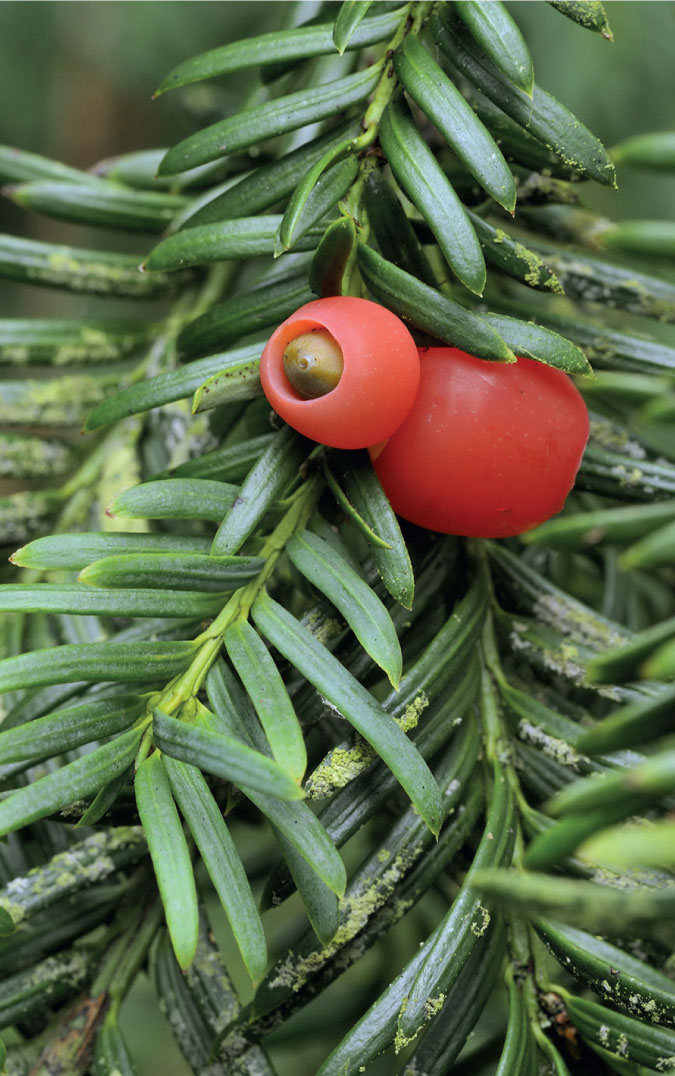
Small to medium trees
One of the questions I get asked most is ‘Which trees can I plant in my small garden?’ Here, then, is a selection of those whose ultimate height won’t look out of place or cause problems for you or your neighbours, but will do wonders for wildlife.
* Apple, Crab Malus
Right up there near the top of my list of brilliant wildlife plants, the native Crab Apple M. sylvestris is a small tree to 9m, native to much of the British Isles. There are many other crab apple species around the world, and they and their hybrids seem to have much the same benefits for wildlife. The white or pink spring blossom is enjoyed by bees and Bullfinches, the foliage is eaten by many moth larvae, while the small sour fruits in autumn are taken by all the larger thrushes. Indeed, many crab apples will hang onto their fruit long enough for the Redwings and Fieldfares to get a look-in. With attractive autumn foliage too, these trees are all-round garden-worthy winners. I recommend ‘Evereste’, ‘Golden Hornet’, ‘Red Glow’ and ‘Sentinel’ but you might also like to try Hupeh Crab M. hupehensis, Japanese Crab M. floribunda, Sargent’s Crab M. sargentii or Siberian Crab M. baccata, all of which I’ve seen doing a similar good job for wildlife.

* Apple, Eating Malus pumila
Thought to derive from just one species native to Asia and parts of Europe, there are many apple varieties to choose from, including famous names such as Granny Smith and Cox’s Orange Pippin. All offer rich nectar for bees in spring, the foliage supports many common moth caterpillars such as the Chinese Character and Eyed Hawkmoth, and the bark is great for lichens. It’s up to you whether you eat all the fruit, or you leave them for thrushes, Blackcaps, Starlings and Badgers, or you share them! There are also lots of ways of growing apples, from giving them space to develop into a medium-sized tree to growing them in a pot. An espalier or cordon trained against a wall or fence probably offers the best nesting opportunities for birds. Any apple tree you buy is likely to be grafted onto a rootstock that will help determine the ultimate size of the tree: MM106 is a semi-vigorous rootstock producing fairly big fruit trees, M26 is slightly smaller, and M9 is a dwarfing rootstock for smaller gardens.

* Buckthorns
If you live in the right areas, these are two small trees that should be high on any wildlife gardener’s wish list. Alder Buckthorn Frangula alnus (above) and Purging Buckthorn Rhamnus cathartica are deciduous trees, native to southern parts of the British Isles. They are essential for Brimstone butterflies, which only lay their eggs on these two plants. Both also have berries taken by birds such as thrushes and Blackcaps. Purging Buckthorn is found on chalk and rarely grows above 10m, with tiny flowers followed by a few black berries (the ‘purging’ part of the name is what happens if you eat them!). The scarcer Alder Buckthorn is a small shrubby tree, usually to only about 5m, growing mainly in acidic woodlands. It has simple leaves, and clusters of tiny green flowers that absolutely abound with bumblebees. A mature tree can hum loudly! The flowers are followed by a final bonus – a scattering of small red berries.

* Cherries and Plums Prunus
A huge family of deciduous trees and shrubs, some of which are very useful for wildlife. Many have wonderful nectar-rich blossom in early spring (if the buds haven’t been taken by Blue Tits, Bullfinches and House Sparrows), foliage that some moth caterpillars eat including The Lappet and Clouded Silver, and succulent fruits in mid to late summer much favoured by many birds including thrushes.
One of the most abundant species in the countryside is Blackthorn P. spinosa, native throughout and thriving on most soils, forming dense spiny thickets. Although the fruits (sloes) aren’t much favoured by wildlife, the mass of early April blossom is visited by bumblebees and some butterflies (see here). Many birds find safe nesting places at the heart of a bush, and the foliage is well eaten by many common moth caterpillars.
Bird Cherry P. padus is native to the northern half of the British Isles in moist woodland and along streams, and grows to 14m. It has white flowers in later spring and then small black cherries. Wild Cherry (or Gean) P. avium (above) usually grows to 12m, so is for medium or large gardens, and is native throughout most of the British Isles and likes rich, heavy soil. It has big leaves, white flowers in April and cherries by midsummer, and it can really pack in the bees in spring. Or why not go for a Plum P. domestica, including subspecies insititia (Bullaces and Damsons) and subspecies italica (Greengages), which grow to 10m and have been cultivated in the British Isles for probably a thousand years. For a small garden, try Sour (Morello) Cherry P. cerasus, from south-eastern Europe but grown here for several hundred years. In contrast, the widely available Japanese and Chinese flowering cherry cultivars rarely form cherries, and many have double flowers and much reduced nectar.
Lightly prune the cherry family after flowering rather than in winter to avoid the disease called silverleaf. And be prepared that most are prone to suckering, sending out roots that then sprout. A Blackthorn hedge, for example, can suddenly turn into a Blackthorn thicket, so you need to get out the loppers once in a while.

Dogwoods Cornus
The Common Dogwood C. sanguinea is native to England, Wales and parts of Ireland and is a small deciduous shrubby tree to 10m with small but heavily scented white flowers in June followed by a few small black berries taken by some birds, especially thrushes. The foliage is eaten by some moth caterpillars such as Mottled Pug and Yellow-barred Brindle, and turns attractive red colours in autumn, while the stems can really glow warm in winter, especially the cultivar ‘Midwinter Fire’. The Cornelian Cherry C. mas (below) is a widely grown, drought-resistant small tree from southern Europe. The yellow flowers appear in late winter, and it occasionally forms red elongated berries. Personally, I’m a fan of the Strawberry Dogwood C. kousa (above) from Japan and China, with bold flowers in spring, each formed of four creamy bracts, followed by strawberry-like fruit that my Blackbirds love.
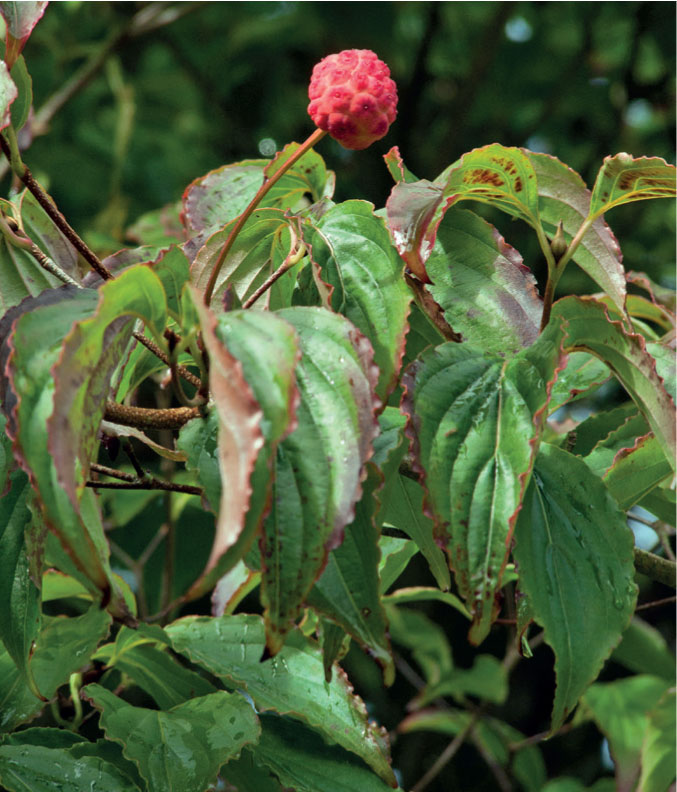

Elder Sambucus nigra
Everyone knows this fast-growing, rather unruly small tree, which grows to 10m and is native across almost all of the British Isles. The leaves smell pretty rank, it’s not the most elegant of shapes, the big plate-sized fragrant clusters of flowers in June can seem empty of insect life and few moths eat the leaves. So is there a saving grace? Yes! The huge harvest of black berries in September is adored by Blackbirds, Starlings, Woodpigeons, Blackcaps and Spotted Flycatchers. The various cultivars with purple (below) or cut leaves are pleasing on the eye and flower and fruit quite well. An alternative to try is the European Red Elder S. racemosa, which has really attractive cut foliage and then clusters of red berries.
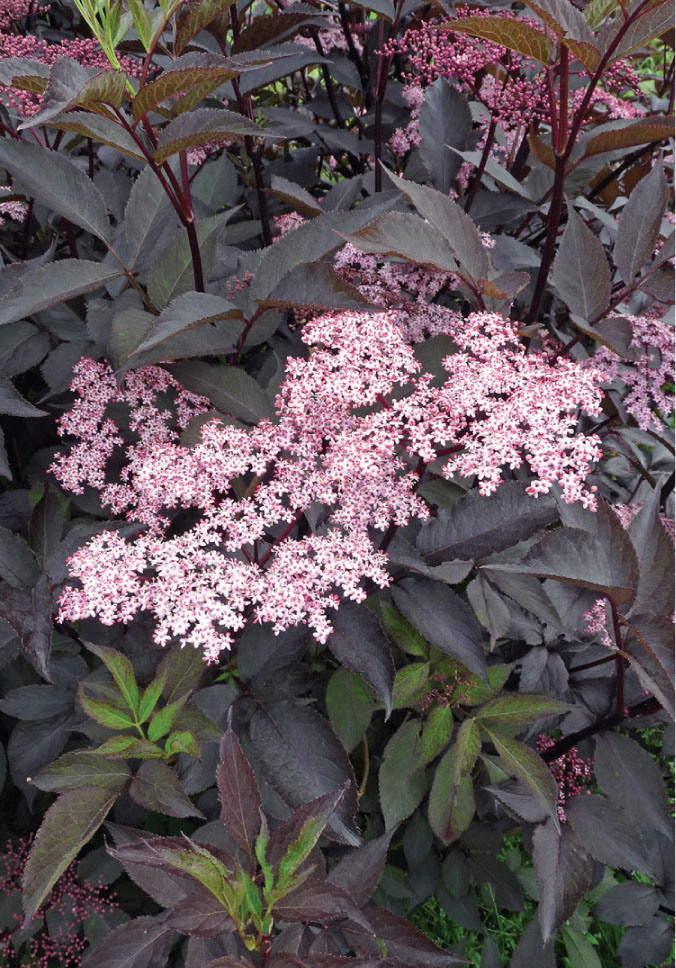
Escallonia, White Escallonia bifida
I include this because sometimes it is nice to grow something unusual, and few gardens have this one. Evergreen and growing to 8m tall, it is native to South America, and in autumn it can be smothered in fragrant white blossom that is a magnet for Red Admiral and white butterflies, and for bumblebees and Honeybees. It needs a very sheltered spot to do well.

* Hawthorns Crataegus
Brilliant trees for wildlife, the Common Hawthorn C. monogyna (above) is native throughout the British Isles, the Midland Hawthorn C. laevigata more restricted to south, east and central England, preferring clay soils. Both are very similar small deciduous trees to 15m at most, creating a mass of thorny branches and twigs perfect for many nesting birds such as thrushes and Dunnocks. The froth of white ‘May’ flowers appears just after the fresh green leaves have unfurled and is much loved by bees and other pollinating insects, plus some spring butterflies. The foliage is eaten by many moth caterpillars and bugs, including the Hawthorn Shield Bug, and the prolific red berries are a staple winter food for the thrush family – and Waxwings, if you’re lucky. There are some red- and pink-flowered cultivars of Midland available, but most have double flowers and are not as suitable. However, one excellent cultivar with dark red and white single flowers, attractive to bumblebees, is ‘Crimson Cloud’. This forms a manageable slow-growing small tree, is not spiny, and produces red berries in autumn. There are American types of hawthorns readily available, but with the British species being so good, why look elsewhere? (Also see Hedges.)

* Hazels Corylus
European Hazel C. avellana is a small deciduous tree to 15m, native across almost all of the British Isles on all sorts of soils. It is often found in hedges or as an understorey in woodlands, where the leaves are eaten by moth caterpillars such as the Large and Little Emeralds and the July Highflyer. The wind-pollinated catkins elongate in early spring and become conspicuous; they can be a bit hit and miss, but occasionally they can be alive with pollen-collecting bees. By autumn, the hazelnuts are eaten by Red and Grey Squirrels, Dormice, Wood Mice, Great Tits, Great Spotted Woodpeckers, Nuthatches and the Nut Weevil. If you cut a Hazel to its base every 7–15 years (known as coppicing), it throws up multiple new stems, and you can use the cut stems as poles around the garden. Also widely planted and probably as useful for wildlife is the purple-leaved Purple Hazel C. maxima ‘Purpurea’.

* Holly Ilex aquifolium
A familiar shrub and small-to-medium sized tree, evergreen and painfully prickly, Holly is native to almost all of the British Isles as part of the understorey in woodland, although it can actually grow to a 20m monster if left unchecked. Perhaps its most well-known inhabitant is the Holly Blue butterfly, whose spring caterpillars eat the flowers and developing berries. Thrushes, too, are fond of Holly berries, but note that male and female flowers are on different plants so you will need a male nearby if you want berries on your female plant. Holly responds well to pruning, provides great dense cover (my Goldfinch flock roosts safe within my largest Holly) and there are plenty of variegated cultivars to choose from if you want a bit of variety.

Magnolias Magnolia
I’m sure that some people will be surprised to see these on the list, being such ornamental and showy trees, mainly from east Asia. Don’t plant one expecting lots of pollinators because the large white, pink or yellow blooms are rather primitive and pollinated by beetles. Instead, I have found that the large, deciduous magnolias are great for birds – tits and finches especially. In fact, as I write this, I am being distracted by a Firecrest and two Long-tailed Tits busy in mine! The spreading structure clearly makes fine perches, and I suspect there are small insects that use the bark and flower buds, and tits then also eat the fruits. It shows that you shouldn’t always discount the exotic!

Maple, Field Acer campestre
Common small tree of hedgerows, to 9m tall, native across much of England and Wales, especially on moister soils. I’ve not found the flowers to be especially attractive to pollinators, but moth caterpillars that feed on the attractive lobed leaves include Maple Prominent, Barred Sallow and Sycamore. The winged fruit aren’t popular with birds, but this is a tree still worth growing. Several cultivars have been bred for both enhanced foliage colour and for different growing habits, but even the ‘bog standard’ species turns a glorious yellow in autumn.

Pears Pyrus
Lovely, slightly raggedy fruit trees with white blossom that emerges in April (before the apples) and is enjoyed by many types of bee. Wild Pear P. pyraster is a rare native of southern and central Europe and possibly of southern Britain with small, rock-hard fruit, dense twigs and spiny young shoots, but you are far more likely to find types of Cultivated Pear P. communis, which are grafted onto a dwarf quince rootstock. They probably started as a hybrid but have been grown for more than 1,000 years. Pear foliage is eaten by some moth caterpillars, and birds such as thrushes will peck at ripe or windfall fruit. Plant it in a sunny position with a good well-drained soil, and always have two trees if you want them to cross-fertilise to bear fruit.

* Rowans Sorbus
The native Rowan or Mountain Ash S. aucuparia is a pleasant, airy, deciduous tree with great autumn colour, native throughout the British Isles, liking lighter acid soils and hating shade. It grows to 15m, with plates of white flowers in spring that aren’t especially favoured by pollinating insects, but the big clusters of red berries in autumn are simply gorged upon by Blackbirds, Mistle and Song Thrushes and Starlings. Even young trees will produce berries. It is the Waxwing’s favourite berry, but few are left by the time they get here in winter. There are various cultivars, including the large-fruited ‘Rossica major’ and the upright ‘Sheerwater Seedling’, suitable for smaller gardens.
There are lots of other rowan species, mainly from Asia, including ones with berries in white, pink or yellow. While there is good evidence that birds prefer red berries, what this means is that those with alternative colours are often left uneaten well into winter, offering a surprise bonus when flocks of Redwings, Fieldfares or even Waxwings come calling in cold snaps. It means that I’m a huge fan of the bright pink-berried Vilmorin’s Rowan Sorbus vilmorinii, the yellow-berried Sorbus ‘Joseph Rock’ (with stunning red autumn foliage), the white-berried Sorbus cashmiriana and the baby-pink-berried Sorbus hupehensis. In fact, they are often better trees for smaller gardens.
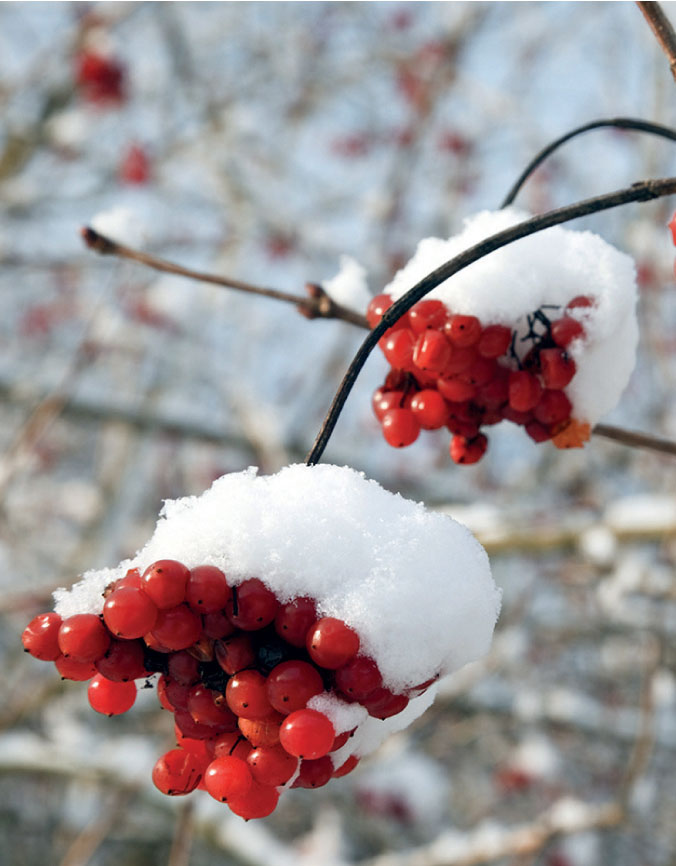
Snowy Mespil (Juneberry) Amelanchier lamarckii
A useful small, slender-branched, multi-stemmed tree for smaller gardens, native to Canada and growing to 10m at most. It is beautiful in spring when covered in delicate white flowers, although these don’t appear to be especially well used by pollinators. The recommendation is more for the subsequent crop of small dark berries by the end of June, which are swiftly polished off by Blackbirds and Song Thrushes. With a splash of good autumn colour, too, this is a tree with good ‘kerb appeal’.

Spindle Euonymus europaeus
This widespread but thinly spread small deciduous tree of hedges and the woodland edge is native to most of England, Wales and Ireland. The flowers are inconspicuous but are nevertheless rich in nectar, visited mainly by flies but also by some bees. The autumn fruits are delightful although poisonous, a pink lobed berry that splits to reveal bright orange seeds. A few birds such as Robins will eat them, plus a micro-moth called the Spindle Knot-horn. The leaves are eaten by the Scorched Carpet and Spindle Ermine moths, and they turn bright red in autumn, especially so in the widely available cultivar ‘Red Cascade’.
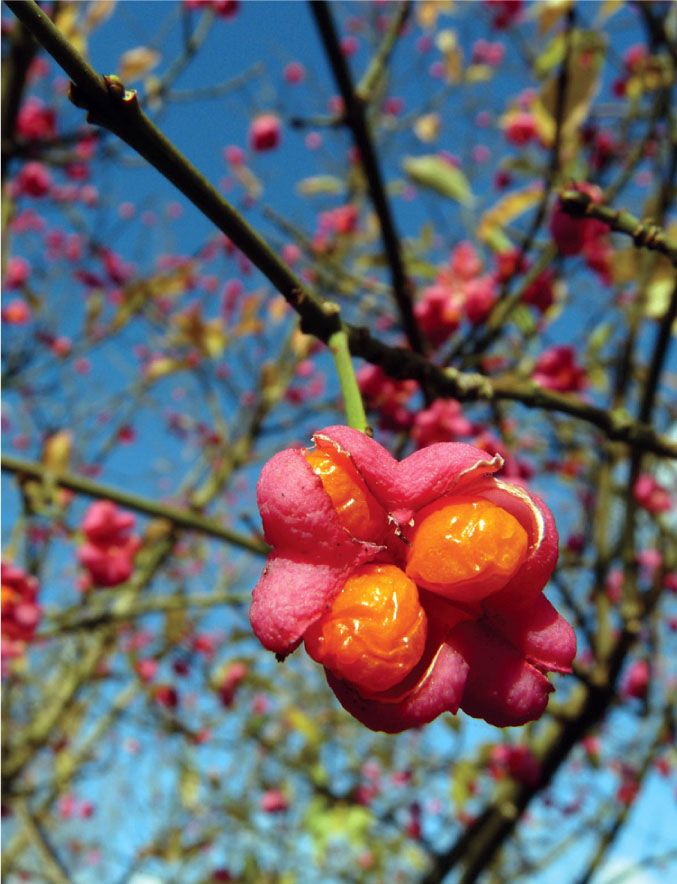
Strawberry Tree Arbutus unedo
This evergreen tree, slow-growing to 8m with small, serrated leaves, is native to the Mediterranean and south-western Ireland. It bears creamy bell-flowers in autumn, pollinated by bees, at the same time that the previous year’s fruit ripen. These look a little like strawberries and are taken by Blackbirds and Blackcaps. The tree does offer some nesting and roosting opportunities for birds too. It needs full sun on a fertile and well-drained soil with some shelter in exposed places.

Whitebeam, Common Sorbus aria
Probably a British native only in southern England but widely grown elsewhere, this deciduous tree grows to about 15m and is easy to spot in spring when the young leaves are held upright showing off their silvery, felt-like undersides. It then produces bouquets of white flowers followed in autumn by sprays of rather chunky red berries. It is a neat tree, and very attractive in a garden, and those berries will be much enjoyed by your Blackbirds and Woodpigeons and, if you’re lucky, Mistle Thrushes too.
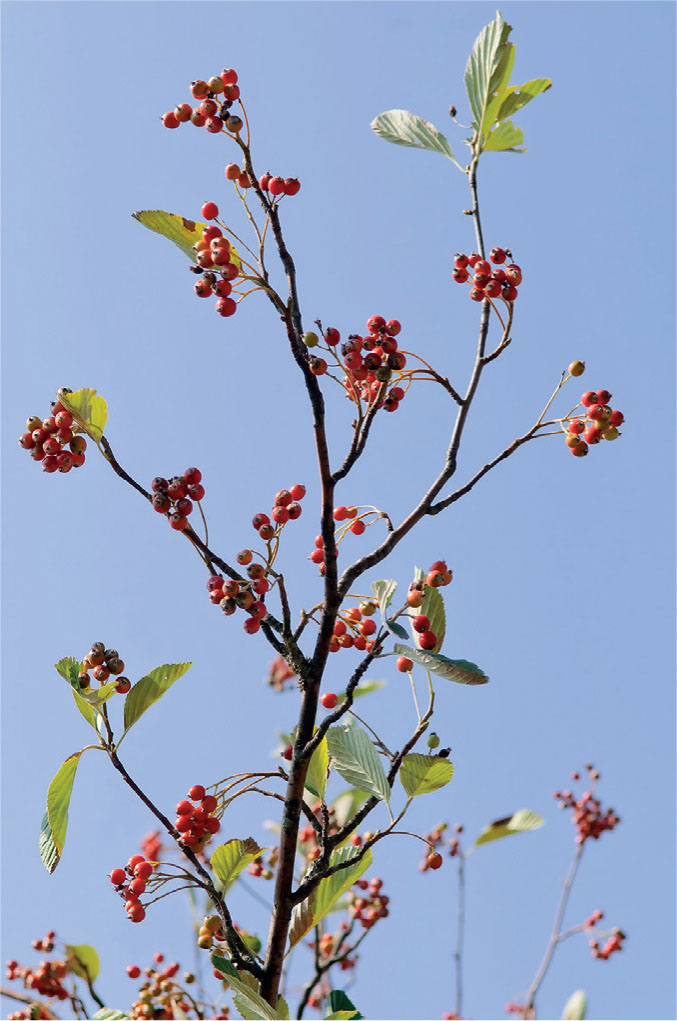
* Willows Salix
With 400 species of willows, several of which are native to the British Isles, and loads more cultivars, there’s likely to be at least one suitable for your garden. Many have separate male and female trees. Goat Willow (Sallow) Salix caprea (below) is probably the most important species for wildlife. It is a brilliant medium-sized tree, native to most of the British Isles, growing to 20m at most. The male flowers are furry and golden (‘pussies’); females have silvery-green spiky flowers. They provide early food for insects including bumblebees and some butterflies (see here) and many of the quaker moths, and the foliage is eaten by many moth caterpillars including the Eyed Hawkmoth, Puss Moth, Sallow Kitten and The Sallow. Willows also host all sorts of aphids, gall mites and other insects, and the seeds are taken by finches. For small gardens, ‘Kilmarnock Willow’ is a ‘weeping’ cultivar of Goat Willow that only grows to 2m, and be careful not to plant large willows too near buildings because of their vigorous roots.
Other species of willow offer similar benefits for wildlife. Grey Willow S. cinerea is almost as widespread as Goat but likes wetter places and is bushier, to only 15m. White Willow S. alba is a European native long planted in the British Isles on riverbanks and lake edges. Here it is often pollarded, forming good nesting sites for Mallards and insect-rich corridors for small birds, but it can become a very big tree. (See Shrubs for smaller-growing species.)


Shrubs
For wildlife, shrubs are often as good as trees in the garden setting. They are normally on a scale that means they don’t cast long shadows, letting the all-important sunlight reach into the corners of the garden, yet at the same time they support such a mass of foliage and stems that they offer shelter, safety and food in abundance. There is also a greater variety to try, with many offering massed nectar-rich flowers and copious amounts of berries. For hedging plants, see also here.
Abelias Abelia
Although there are several species of Abelia, the evergreen hybrid of two Chinese species, A. x grandiflora (above), is probably the most widely grown. It is a rather lax shrub to 1.8m, with glossy green leaves topped with little sprays of pinkish, tubular, fragrant flowers in late summer through to autumn, visited by some bees. If you can find it, however, I rate the deciduous A. chinensis more highly, with much better pulling power for butterflies. Give Abelias a sheltered spot in sunshine.

Ageratina, Privet-leaved Ageratina
ligustrinum (syn. Eupatorium ligustrinum) This twiggy evergreen bush from Central America grows to 2.5m. The flat heads of small white flowers, produced late in the season, are good for pollinators, including bees plus some butterflies such as Small Tortoiseshells and Red Admirals. Give it a sheltered, sunny spot, but beware that it is frost sensitive so you’ll need to keep it in a pot in colder parts and bring it into a cold greenhouse in the winter or take cuttings.
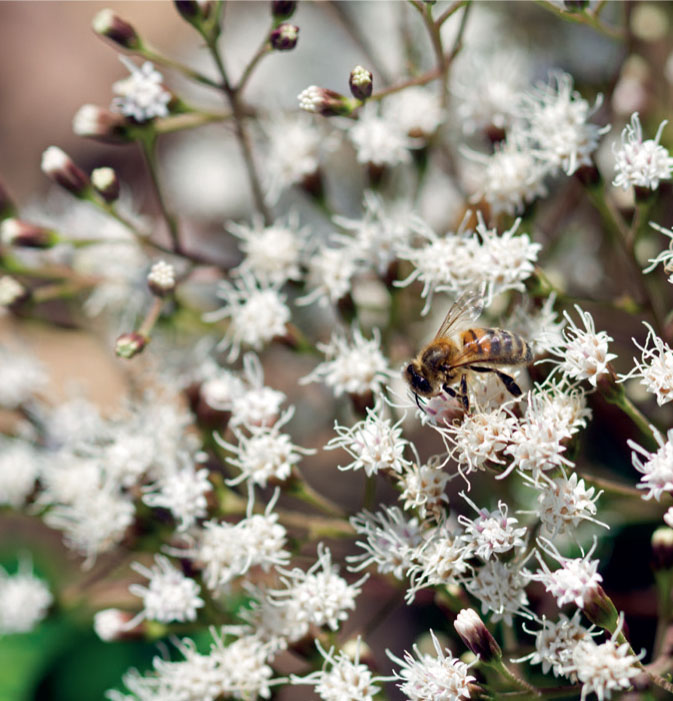
Barberries Berberis
A large family of shrubs, most garden varieties having small, shiny leaves with spiky margins, dangling clusters of little, yellow, stalked flowers favoured by bumblebees, and then dark bluish berries taken by birds such as thrushes and Blackcaps. Barberry B. vulgaris is possibly native to England and Wales but at the very least has been grown here for hundreds of years; its berries are red. Much easier to buy are the evergreen Thunberg’s Barberry B. thunbergii from Japan, Darwin’s Barberry B. darwinii (above) from South America, Mrs Wilson’s Barberry B. wilsoniae from China and Hedge Barberry B. x stenophylla, a South American cross. You may also find B. julianae with ferocious thorns and ‘mini-rose’ yellow flowers. Grow any of these and you’ll have a chance of hosting a population of the Scarce Tissue moth, whose caterpillars feed almost solely on barberries.

Brooms Cytisus and Spartium
Airy, stiff-stemmed, evergreen shrubs with tiny clover-like leaves, mainly native to Europe, and covered in sunshine-yellow pea flowers in early summer. Common Broom C. scoparius grows to 2m and is native throughout much of the British Isles on poor, often sandy, slightly acid soils in sunny positions, and is good for bumblebees, but a bit prone to snail damage. The Grass Emerald and The Streak moth caterpillars feed on it. Garden centres tend to sell cultivars of the hybrid Cytisus x praecox, a mix of two western Mediterranean species, some of which still seem to be enjoyed by bumblebees. Spanish Broom Spartium junceum (above) is also worth a try, visited by some bumblebees. Keep brooms in good condition by nipping off spent flowers and pruning back some old stems straight after flowering.

* Buddleja x weyeriana
You may have noticed one plant that is prominent by its absence from the list – the uber-common Butterfly Bush B. davidii from China, so familiar from gardens and railway embankments and even poking out of brickwork everywhere. Yes, it’s a magnet for many butterfly species, but its capacity to spread invasively is a major concern. That’s why I’m suggesting that you make that extra effort to find B. x weyeriana, a sterile hybrid of B. davidii. It may not be as well known as its famous parent but it deserves to be so, with panicles of yellow flowers that start blooming late and go on and on until the first frosts, and no seeds to invade the countryside. It is visited by bumblebees as well as butterflies.
There is work underway, especially in the USA, to develop sterile versions of B. davidii. I shall be so pleased when that happens and I can start promoting them again, for they are such an easy plant to grow, so beautiful in flower, and so adored by butterflies and Hummingbird Hawkmoths. Research has even shown that its foliage is palatable to many species of moth, so the sooner those proven new varieties are on the market, the better.
In the meantime, you might also like to try Orange-ball Buddleia B. globosa from South America, with yellow pompoms in June, which is good for Honeybees and bumblebees. I also like Fountain Buddleia B. alternifolia from China, a bit unruly but flowering in May, offering nectar for Honeybees and spring butterflies. There is a very strong chance that you already have B. davidii in one of its many forms in your garden. If so, you are best advised to deadhead religiously once they flower to stop all that seed spreading.
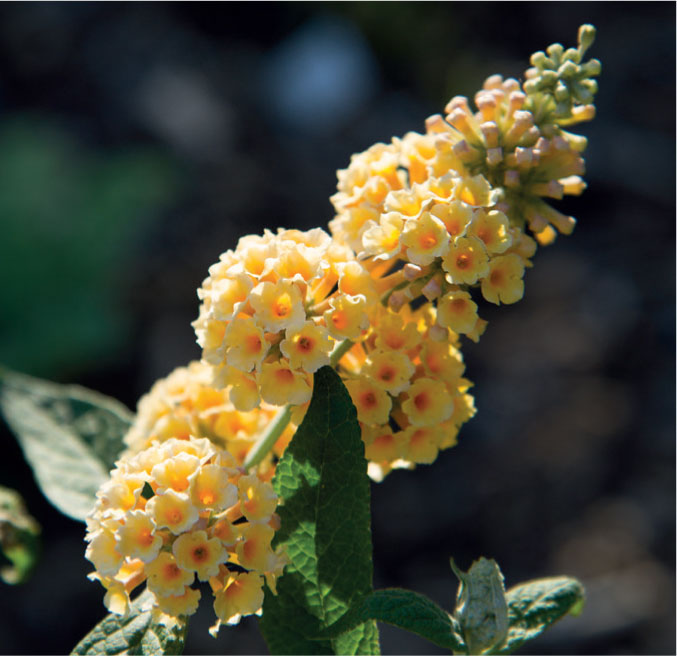
California Lilacs Ceanothus
Several species of small evergreen shrubs, most native to California, growing to about 3m and usually hardy. They typically have densely branching stems that are too slender for nesting birds but get covered with clusters of blue flowers visited by Honeybees and bumblebees. Garden centres usually only stock hybrid cultivars, which I have found quite variable in their wildlife value. Try ‘Dark Star’ and ‘Gloire de Versailles’, but with so many cultivars out there, do let me know if you find another good one. They like well-drained soil in sun. To maintain, cut out dead wood in spring and then prune lightly after flowering.

Daphnes Daphne
We have two native members of this genus: the evergreen and widespread Spurge-laurel D. laureola and the rare and deciduous Mezereon D. mezereum (above). Both are useful in that they are neat, 1m tall shrubs that will tolerate some shade, especially the Spurge-laurel. While I haven’t found that either are particularly big hits with pollinators, Mezereon has beautiful pink flowers in early spring borne along the stems, and they both produce good numbers of berries, black in Spurge-laurel and red in Mezereon. The latter in particular may be harvested enthusiastically by Greenfinches.
In the garden, you may be just as likely to grow one of the non-native shrubs, favoured for the beautiful scent of their very early spring flowers. D. bholua from the Himalayas and D. odora from Japan and China are perhaps the most frequent, and are visited by early pollinators, including a few spring butterflies.

* Deutzias Deutzia
Deciduous shrubs from Asia that become absolutely decked in flowers in mid-spring. Of all the flowering shrubs in my garden, D. × hybrida ‘Strawberry Fields’ (below) is the best of all for bumblebees, which crawl in their droves over the masses of simple, pink-rimmed flowers. Honeybees and solitary bees also visit. Growing to about 2m tall, it basically looks after itself and so I cherish it greatly! Other single-flowered Deutzias can be just as good, and indeed a Polish study found that D. scabra var. watereri had more nectar and pollen than any other, but sadly most of those you’ll find on sale are frilly doubles, which may get some bee action but much less than if the plant breeders had left them alone!

Flowering Currant Ribes sanguineum
A nicely compact, spine-free, hardy shrub to 3m tall, native to the western USA, with several cultivars. In April they are covered with clusters of delicate reddish-pink or white flowers, useful for some pollinating insects, set against fresh-green, lobed leaves. There are just a few black fruits in autumn that will be taken by birds such as thrushes. It can be used as an attractive informal hedging plant, and will tolerate dry shade and clay soils.

Germander, Shrubby Teucrium fruticans
A small shrub, 1m tall at most, hailing from south-western Europe. It develops a tangle of branches with small, rather grey, felt-like leaves typical of plants that need to cope with hot dry summers. The pale blue, hooded flowers are rather similar to those of Rosemary, and are regularly visited by bumblebees and other pollinators. Give it a free-draining soil in full sun for best effect and a long flowering season.
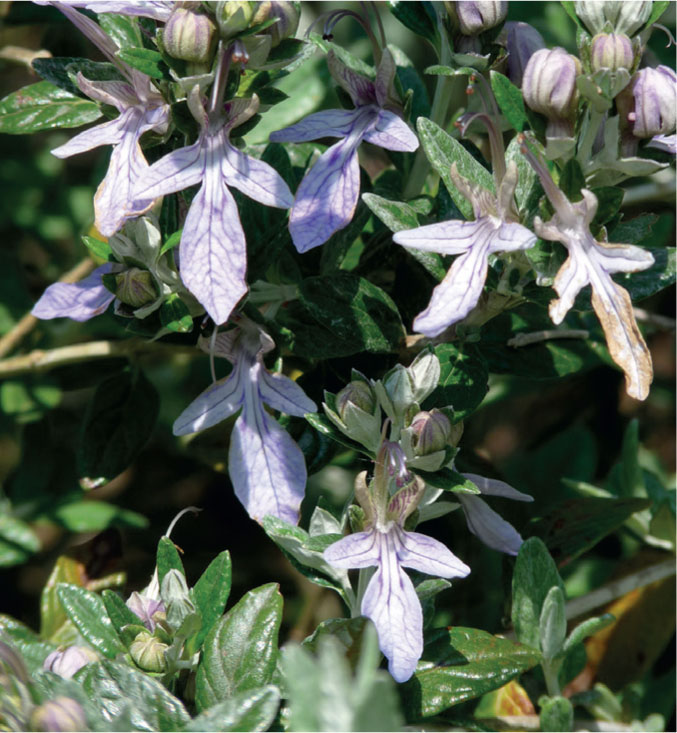
Gorses Ulex
Familiar, dense, spiny shrubs from coastal cliffs and sandy soils that get covered in yellow pea flowers, some even in winter. Caterpillars of Grass Emerald and July Belle moths specialise on gorse, as do various beetles and bugs such as the Gorse Shield Bug. The flowers aren’t well visited by insects but can be good for solitary bees, although you’ll need to ensure that you get the wild, single-flowered species. The thicket-like structure offers shelter, support for spiders’ webs, and nest sites for Wrens and Dunnocks.

Grevilleas Grevillea
Although somewhat tender, I include this to show that something that comes from Australia can still have some wildlife value in a British context. There are many species, but here the most reliable are some of the hybrids, such as ‘Canberra Gem’ (above), which are rather loose, rounded shrubs up to 2m high, their leaves a little bit like a conifer, and with strange, red flowers like curly spiders that are rich in pollen for some bees. Given a sheltered spot, the hybrids can survive perfectly well and can go on flowering for months on end.

Guelder Rose Viburnum opulus
I include this separate from the main entry for Viburnums because it deserves its spot in the limelight. A widespread native in the British Isles, growing to about 4m high at most, it is deciduous with attractive tri-lobed leaves. The heads of white flowers are rather like a hydrangea with fertile inner flowers and large sterile bracts around the outside. It’s the dangling bunches of succulent red berries that are its best asset, devoured by Bullfinches. The other native Viburnum in the British Isles is the southern English Wayfaring Tree V. lantana, fine in itself but the berries are rather tough and unattractive to wildlife. Both have a range of small insects associated with them, including the Viburnum Midget moth.
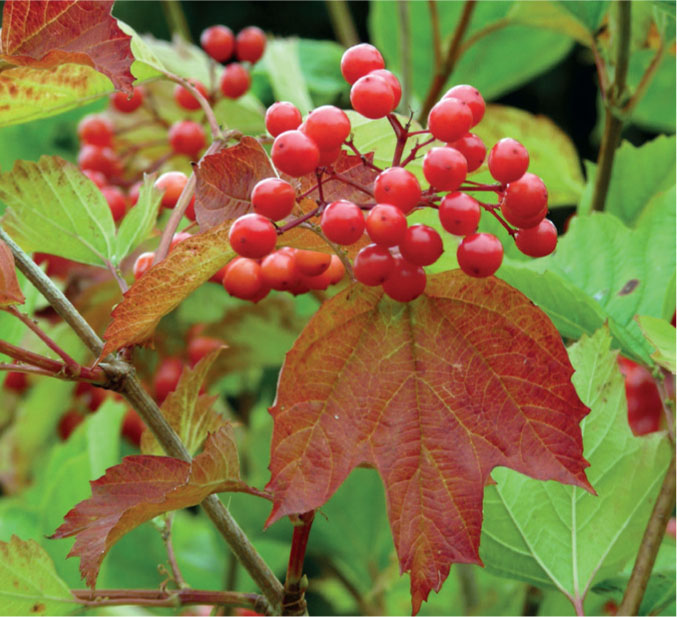
* Heathers Erica and Calluna
The mainstay of the heathland garden, heathers both look good and also work well for wildlife, even if they are a bit out of fashion. Most are dwarf shrubs to only about 60cm high, with a tough framework of woody stems and tiny evergreen leaves that offer good cover for insects and hanging places for spiders and their webs. Many common moth caterpillars eat the tough leaves including the Fox Moth, Beautiful Yellow Underwing, Yellow-line Quaker and True Lover’s Knot. Perhaps its best-known wildlife value is as a nectar source for bees. There are two main genera: Calluna contains just one species, Heather or Ling C. vulgaris, our common heather of moors and heaths, native to acid soils across the British Isles, and now with hundreds of garden cultivars. The pink-purple flowers (or white in some cultivars) are a delight in late summer. Avoid those with double flowers. The other genus, Erica, has 750 species! On acid soils, try Bell Heather E. cinerea (above) or the bog-loving Cross-leaved Heath E. tetralix, native on heaths and moors throughout the British Isles, or Cornish Heath E. vagans, native to The Lizard in Cornwall. For those of us on non-acid soils, however, I heartily recommend Winter Heath E. carnea from the Alps, or Darley Dale Heath E. x darleyensis which is Winter Heath crossed with Irish Heath, both of which flower in late winter and are ideal for early and late bumblebees and butterflies. Plant all in full sun, and prune after flowering.
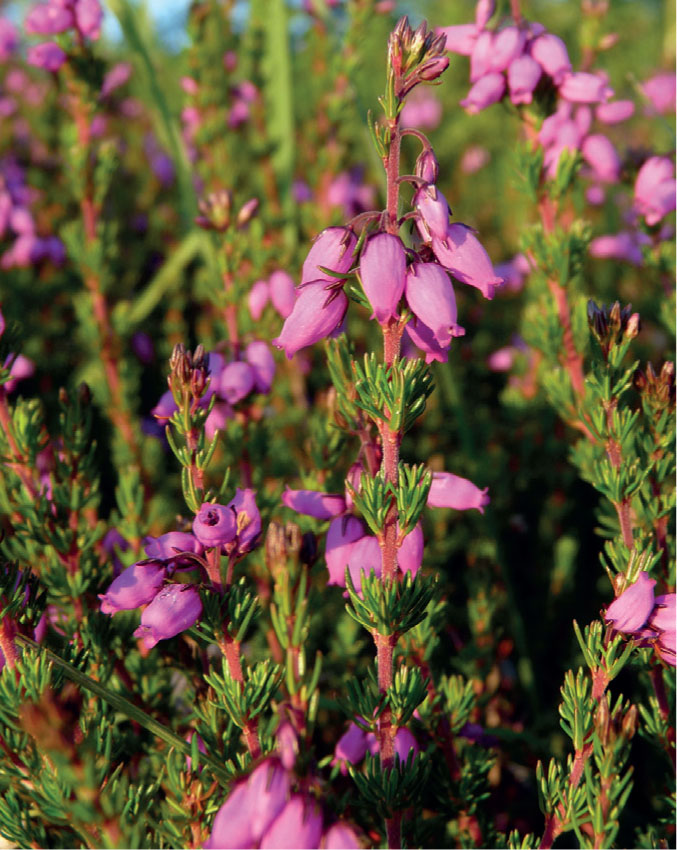
Hedge Veronicas Hebe
Often known by their Latin name, these are densely-packed evergreen shrubs, to 2m at most, from New Zealand. There are several species and many cultivars and hybrids, some not fully hardy, with different varieties for different seasons with spikes of pink, purple or white flowers. They tend to all get touted as being good for pollinating insects, but in my experience some are brilliant, some are good and many are poor. Try H. x franciscana with its rather fleshy leaves and short flower spikes, or H. ‘Great Orme’ and H. ‘Midsummer Beauty’, while the tall H. salicifolia is good for butterflies such as Small Tortoiseshell, Speckled Wood and Green-veined White. Grow them in full sun, take cuttings in late summer and prune after flowering. And if you see one packed with insects in a friend’s garden, beg a cutting or two!

* Hyssop Hyssopus officinalis
A semi-evergreen shrubby perennial to 60cm, native to southern and eastern Europe but hardy in the British Isles, with small aromatic leaves and dense spikes of two-lipped violet or blue flowers in late summer and autumn adored by Small Tortoiseshell butterflies and bees. It needs a sunny well-drained soil, and can form a nice low hedge like lavenders. Cut back hard in spring.
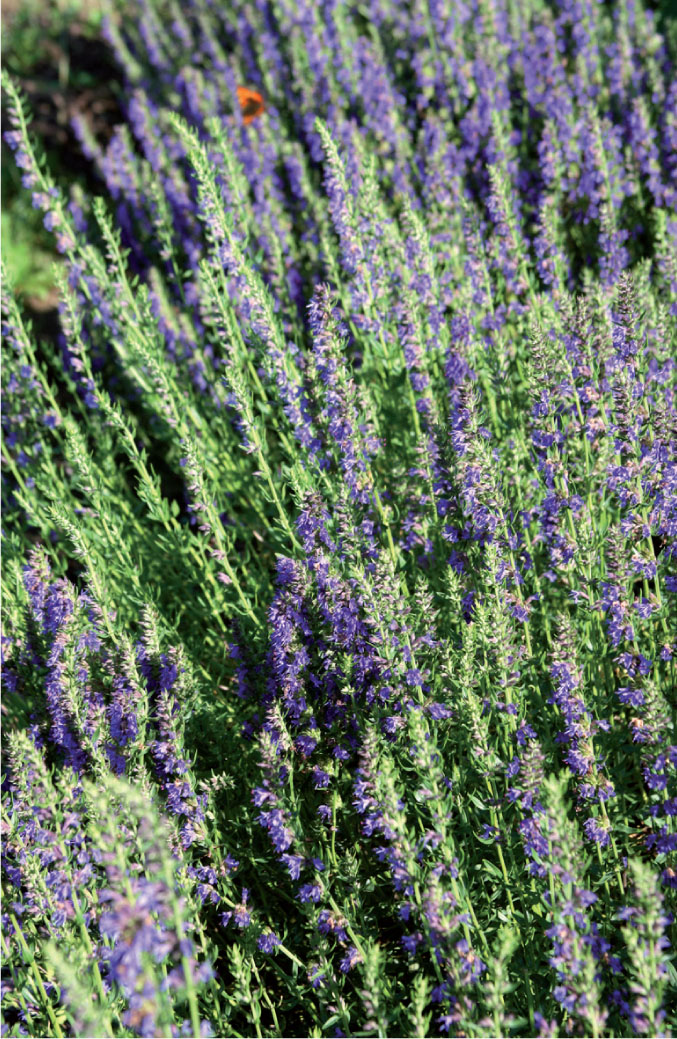
Juniper Juniperus communis
A conifer that has berries? What a brilliant way of adding year-round structure to a garden and offering something for wildlife! This is an evergreen shrub or small tree to 7m, with a scattered native distribution in the British Isles on southern downland, northern moorland and some heathland. The caterpillars of Juniper Carpet, Freyer’s Pug and Juniper Pug moths feed on the needle-like foliage, as does the Juniper Shieldbug, while the fruit slowly ripen to black (over three years) and are eaten by many bird species. Note that male and female flowers are on different plants. The dwarf ‘Compressa’, to only 75cm, will struggle to fruit but is good for small gardens, while for mid-sized gardens you might like the upright ‘Hibernica’.

* Lavenders Lavandula
Familiar, low, evergreen shrubs, with small, hard, aromatic leaves and long thin flower stems that are topped with small lilac flowers much visited by bumblebees, Honeybees, many butterflies (see here) and Hummingbird Hawkmoths. A garden favourite is English Lavender L. angustifolia, which isn’t native to England at all but comes from the Mediterranean and flowers from June to August. Finches may visit to take the seed in late autumn if left untrimmed. There are loads of cultivars to try, and research has shown that L. x intermedia may often be the best for pollinating insects, but being sterile it is unlikely to set seed, reducing its value for birds. French Lavender L. stoechas with its purple ‘rabbit’s ears’ at the top of the flower spike is not quite so good for bees, but still pretty effective. Larger lavenders seem to be better than the small cultivars such as ‘Munstead’ and ‘Hidcote’.
Grow Lavenders in hot, dry places with a very well-drained and rather poor soil. Prune hard after flowering and then clip the tips again in spring. They are easy to propagate from cuttings too, important as they don’t live long and can become leggy.
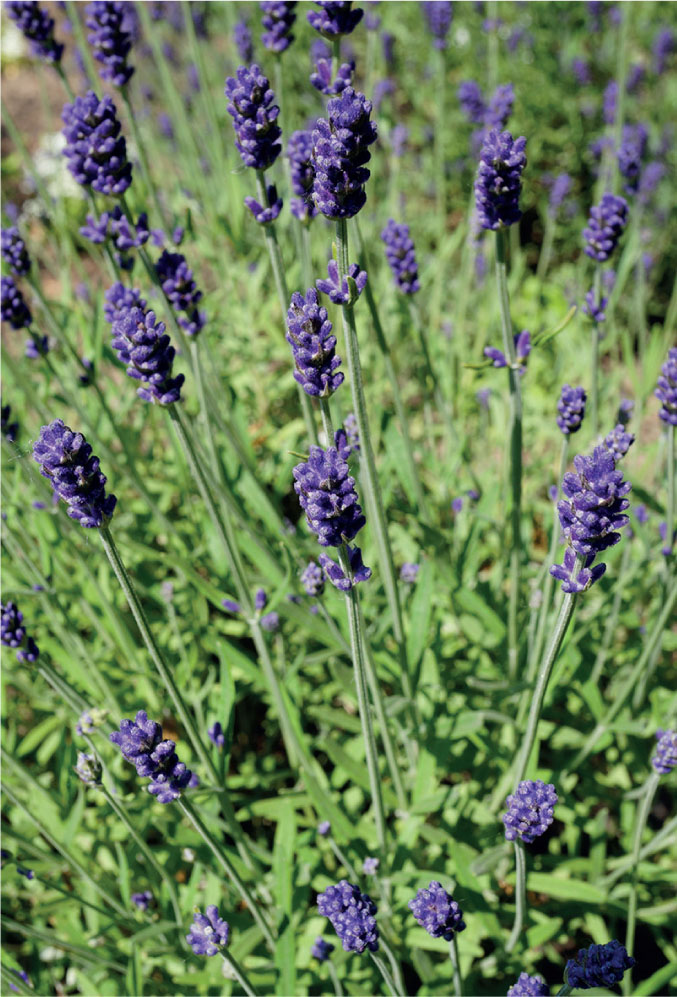
Myrtle (Common) Myrtus communis
Evergreen shrub, up to 5m tall at most, native to the Mediterranean and well able to tolerate winds and dry summers. It has small, aromatic, glossy leaves, and the white early-summer flowers with sprays of long stamens provide pollen for bumblebees. Blackbirds take the astringent, dark berries in late winter. It can be used as hedging, but give it a sheltered spot if you are in an area prone to hard winters.
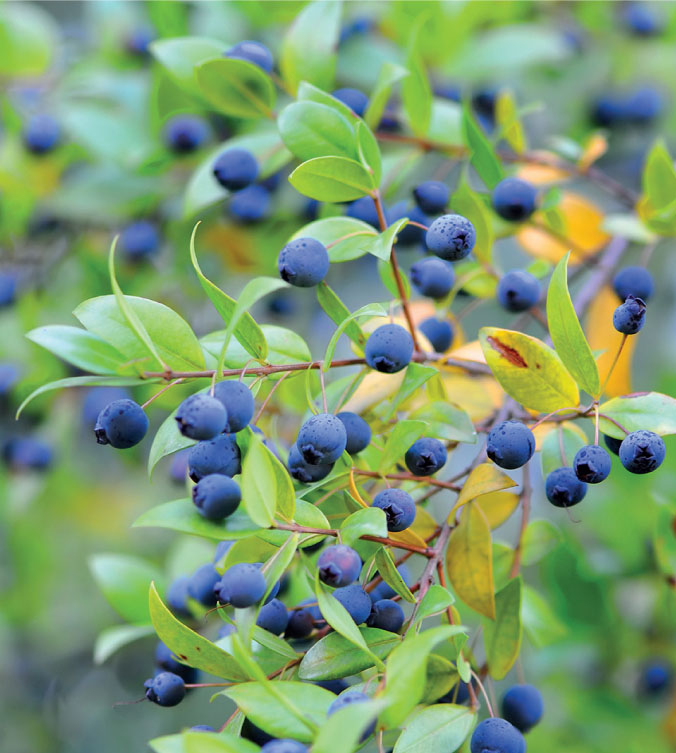
Oregon-grapes Mahonia
Several species and cultivars in this family of rather straggly bushes, growing to about 2m, with holly-like leaves. Structurally they are not dense enough or strong enough to offer nesting sites for birds, and the leaves are only palatable to a few insects, but their saving grace for wildlife are the sprays of yellow flowers, often in midwinter, that give nectar (and colour) at a time when little else is flowering. Late- or early-flying bumblebees make good use, as do winter flies. The flowers then turn into little pointed blue or purplish berries, taken by some birds such as thrushes. Commonly available are Oregon-grape M. aquifolium, native to North America, and the similar M. japonica from Japan. They can be planted as an informal hedge, preferring shade or half-shade in fertile soil.

Pieris Pieris
At their very best, these can be fantastic shrubs for spring pollinators, at times heaving with bumblebees, solitary bees and flies. Given that they are also beautiful, with their cascades of mini-lantern creamy or pinkish flowers and often with bright red fresh foliage, they make a very garden-worthy plant. My recommendations are larger varieties of P. japonica, and its hybrid P. ‘Forest Flame’, both of which can reach up to 3m tall but don’t need much care at all. Give them a well-drained soil and a position with a bit of shade but enough sunshine during the day to give the pollinators every excuse to visit.

Privet, Wild Ligustrum vulgare
A fine hedging shrub to 3m, semi-evergreen, and native to most of England and Wales. It creates enough cover for some birds such as Blackbirds to nest and for House Sparrows to gather for a natter. The leaves are eaten by moth caterpillars such as Waved Umber, Privet Hawkmoth, Yellow-barred Brindle, Lilac Beauty and Small Blood-vein. The dense spikes of overpowering white blossom in June and July are visited by various pollinating insects, including some butterflies and moths, and in autumn the little black berries are eaten by Blackbirds, Robins and Blackcaps. Be aware that privets suck moisture and nutrients from the ground around them to the detriment of other plants. Avoid the invasive but readily available Garden Privet L. ovalifolium.

Rosemary Rosmarinus officinalis
At home in the flowerbed or the herb garden, this evergreen aromatic shrub, to 2m at most, is from the Mediterranean. It has thin, tough leaves on usually upright stems, dotted with small, lilac-blue flowers that are much visited by Honeybees and bumblebees. There are plenty of cultivars, including some spreading forms for walls and rock gardens. Give it a well-sheltered position in sun, and prune back in spring after frosts have damaged the tips. It can be used as a low informal hedge.
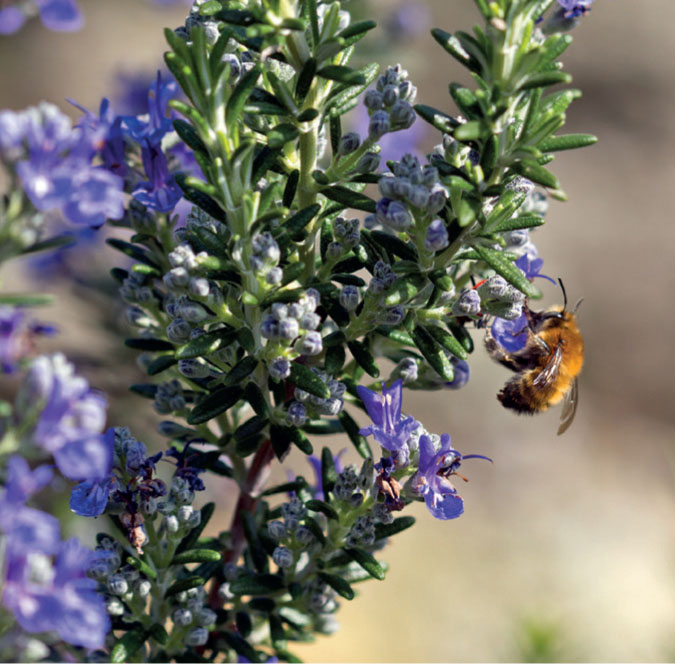
* Roses Rosa
This huge family of ever-popular plants is grown mainly for their pretty flowers and sweet scent. Those thousands of big-bloomed, heavily pruned cultivars in a rose bed aren’t what we’re interested in; we want those that offer nectar and pollen and succulent fruit (hips), which are usually the single-flowered older varieties and species roses. There are plenty of natives to try, including the vigorous Dog Rose R. canina growing to 3m, with pinkish flowers, and native to much of the British Isles. The shorter, rather weaker Field Rose R. arvensis is native to much of England, Wales and Ireland with white flowers, while the scrubby little Burnet Rose R. pimpinellifolia, native to much of our coastline, has lovely white flowers and black, round hips.
I’m a total convert to simple, single-flowered roses. Some attract heaps of pollinators, with R. moyesii, for example, being absolutely amazing and with the most intense red flowers on what is a large, vigorous shrub with arching stems. Among the thousands of hybrid roses, there is a small but growing group of single-flowered cultivars that are being recognised as very attractive to pollinators. In addition, rose foliage is eaten by many moth caterpillars including the Shoulder-stripe, The Streamer and Barred Yellow. Roses are also used by gall wasps (including the one that makes the Robin’s Pincushion), leaf beetles and, of course, aphids (and hence ladybirds and hoverflies), while leaf-cutter bees will target roses. Finally, the hips are eaten by Greenfinches and thrushes, plus Waxwings. Non-native roses to try include April-flowering Incense Rose R. primula, great for early solitary bees, and the shrub rose Lyda Rose (left). Just avoid the invasive Japanese Rose R. rugosa. (Also see Climbers.)


Sea Buckthorn Elaeagnus (Hippophäe) rhamnoides
An exceedingly spiny shrub, to about 8m at most, it grows in poor soil and on sand and is tolerant of salt, and hence is popular in coastal areas. The fierce structure is great cover for wildlife. It is native to the English east coast, but a non-native invasive plant away from its native range and should be avoided in Ireland and along the British west coast. The leaves are silver-green, the twigs dark and the acidic berries bright orange, not a favourite of birds until harsh weather forces them not to be so picky! Note that you’ll need two plants for berries to be produced.

Stranvaesia Stranvaesia davidiana, syn. Photinia davidiana
Closely related to the very common hedging plant Photinia ‘Red Robin’, Strenvaesia is well worth seeking out because its many simple white flowers, dotted among the leaves, can be bumblebee magnets. This large evergreen shrub from China, which can grow up to 8m tall, has rather leathery leaves that I suspect aren’t that palatable to insects, but it does have red fruit after flowering.

Sweet Pepper Bush Clethra alnifolia
A hardy deciduous shrub to 2m, native to North America, with oval, dark-green leaves and upright spikes of fragrant white flowers in late summer and autumn visited by bees, and by butterflies such as Peacocks. It grows best in half-shade and moist, lime-free soil, and benefits from some shelter.

Tamarisks Tamarix
Rather untidy, deciduous shrubs to 4m, but with attractive featheriness due to the tiny bluish-green leaves on the fine stems. However, it is for the many slender plumes of baby-pink flowers that they are included here, which are visited by bees, and which bloom for a long season from spring onwards. They are also useful for their hardiness, being some of the best shrubs to grow in exposed coastal locations where they can cope with high winds and salt spray. Most frequently grown is T. gallica from the Mediterranean but there are several other very similar species. Prune them hard after flowering.

Vaccinium
This genus of low-growing, even prostrate, small woody shrubs in the heath family is most associated with upland areas and acidic soils, the foliage often turning attractive reds in autumn. Most have pinkish bell-flowers pollinated by bees followed by red, bluish or black berries popular with many birds and small mammals. Familiar on uplands and heathlands throughout the British Isles is the native Bilberry V. myrtillus, up to 30cm high and with rather rounded pink flowers and black berries. In its wild habitats, dozens of moth species feed on the leaves as caterpillars, including the Fox Moth, as well as various sawflies and bugs. Somewhat easier to buy is Cowberry V. vitis-idaea, native to most of our high peat moorlands, but with several cultivars on the garden market. It also grows to 30cm, but has soft-pink bell-flowers and red berries. Most widely available is the North American Blueberry V. corymbosum (above) for your fruit garden, a taller bush up to 1.5m.

Viburnums Viburnum
Several garden species and cultivars of mostly evergreen shrubs, to about 2–4m, with clusters of white or pinkish flowers, sometimes visited by Honeybees and hoverflies, and followed in some by mainly blackish berries taken by some birds such as thrushes. The ubiquitous but rather uninspiring V. tinus is native to the Mediterranean, growing to 3m and coping well in shade, although the spring flowers will be borne more freely in sun. I much prefer V. x bodnantense (above), a hybrid of two Chinese species, which is especially useful in that it flowers through the winter on the bare branches, offering nectar to bravely venturing Red Admirals. V. x hillieri is a pleasant small evergreen bush that in a sunny location will be visited by some butterflies as well as Honeybees.
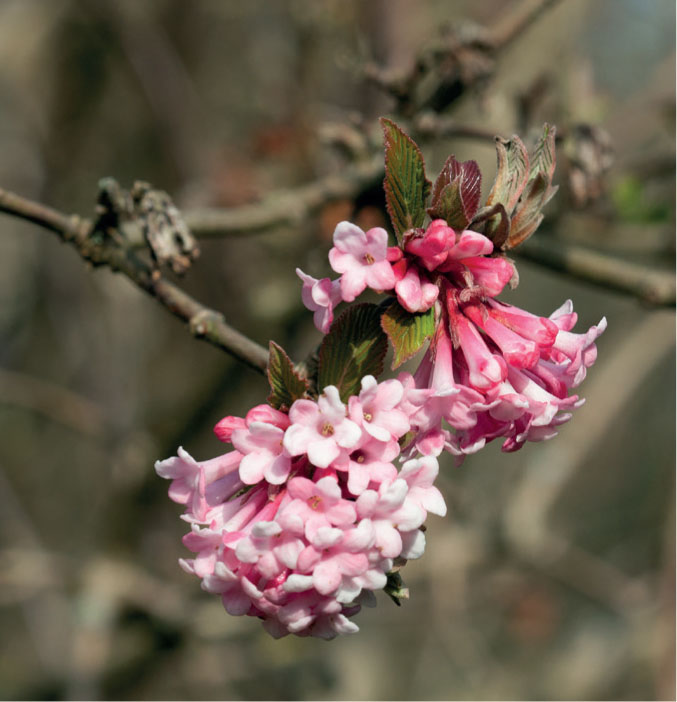
* Willows Salix
As well as the larger trees in the Salix genus, there are some smashing low-growing species that are great for smaller gardens and top notch for bumblebees; indeed they can be a mainstay for early-emerging species. My favourites are: S. aegyptiaca which can grow to 5m but can be cut back to 30cm or so every couple of years; the Halberd Willow S. hastata, which grows to about 1.5m with purple stems; the fiery-stemmed Salix alba vitellina (above) and the well-named Woolly Willow S. lanata. For living willow domes and structures, use Common Osier S. viminalis.

Winter Honeysuckle Lonicera fragrantissima
Quite different from the typical climbing honeysuckles (see opposite page), this and its hybrid L. x purpusii are thin-stemmed shrubs from China. They bear rather inconspicuous but powerfully scented white flowers in winter and early spring that offer much-needed nectar in warm spells to bumblebees, honeybees, hoverflies and flies.
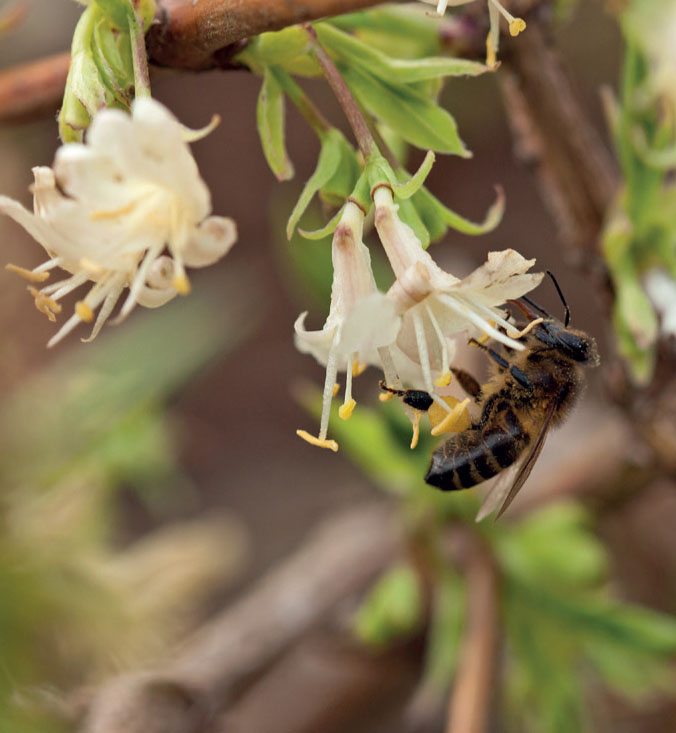
Climbers
Boston Ivy Parthenocissus tricuspidata
A superior alternative to the invasive Virginia Creeper (which should be avoided). It climbs using tendrils, and will happily cover a half-shaded wall with its ‘dinosaur footprint’ three-lobed leaves, which turn into the most glorious show of autumnal colour. It can be kept trimmed to shape, but the density of foliage makes it great for nesting birds such as Robins, Blackbirds and even House Sparrows; it even bears some berries.

Clematis Clematis
Choose carefully from this familiar group of climbers, because some have been so interbred for their more showy blooms that they have lost their value for pollinators. The ubiquitous ‘montana’ types, in particular, are very poor. Instead, be content with the more subtle charms of the small-flowered types, focusing on ones such as C. cirrhosa for winter bumblebees, and C. heracleifolia and its hybrid C. x jouiniana for moths. The Orange-peel Clematis C. tangutica isn’t a write-off for pollinators, but my absolute favourite is C. rehderiana (above), which becomes decked in autumn in cream-coloured bells that can be crawling with bees and other pollinators. Also C. flammula and its hybrid triternata will form a thicket, and will attract flies and other small pollinators. The early season C. alpina cultivars don’t grow very big and will attract some bumblebees. For those that like to grow native plants, try Wild Clematis (Old Man’s Beard) C. vitalba (below). A deciduous woody climber, it is native to most of southern England and coastal Wales, usually on limey soils, but planted further north and across Ireland. It trails up to 30m over bushes and hedges, with low-key, cream-coloured flowers in July to September followed by fluffy white seed heads lasting throughout winter. It isn’t regularly offered as a garden plant, but it helps create a useful tangle of vegetation for spiders, and the foliage is eaten by the caterpillars of Small Emerald, Least Carpet, Small Waved Umber and The Fern moths.
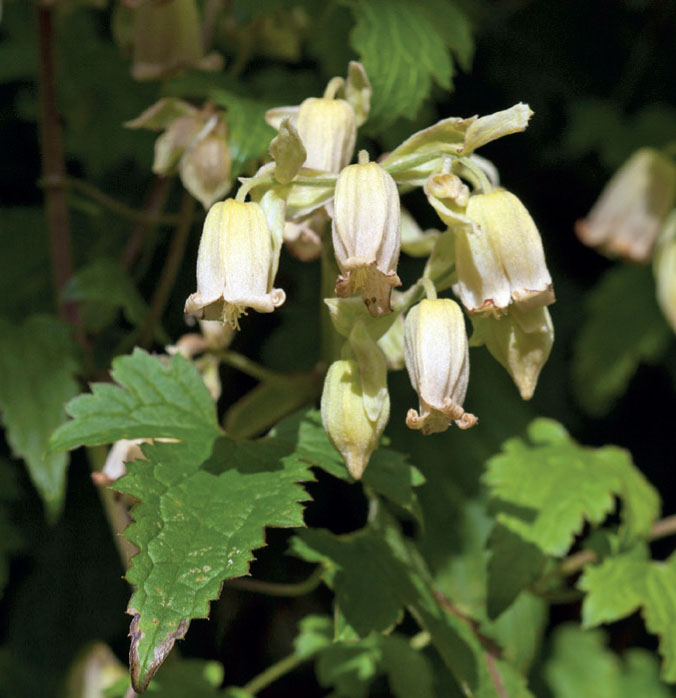
* Honeysuckle Lonicera periclymenum
Strong, easy-to-grow climber with rather exotic-looking, sweet-smelling flowers much used by bumblebees and Honeybees and also by some moths such as the Burnished Brass and The Shark. Native to almost every part of the British Isles, it grows to 7m, twining around trunks or trellises. Plenty of moth caterpillars feed on the deciduous foliage that emerges by late winter including Small Blood-vein, Early Tooth-striped, Lilac Beauty, Twin-spotted Quaker and Early Grey. The clusters of red berries that follow are eaten by birds such as finches, Blackbirds and Blackcaps, and Dormice use the bark in their nests. There are several species sold in garden centres, but it is probably best to stick to this native species, of which there are some excellent free-flowering cultivars to try such as ‘Graham Thomas’ and ‘Belgica’. Grow them in a fertile and moist soil, preferably with their roots in the shade.


* Hop Humulus lupulus
Perennial climber, native to well-drained soils across much of the British Isles except the far north, clambering rampantly to 8m each year around posts and over hedges using strong rough stems. It then dies back completely in winter. The leaves are large and palm-shaped, and the tiny greenish female flowers develop into the dangling golden ‘cones’ that were once used in beer production. This is a good plant for the caterpillars of the Comma butterfly, while those of Currant Pug, Pale Tussock, Twin-spotted Quaker and Dark Spectacle moths also eat it. ‘Aureus’ is a readily available golden-leaved version.
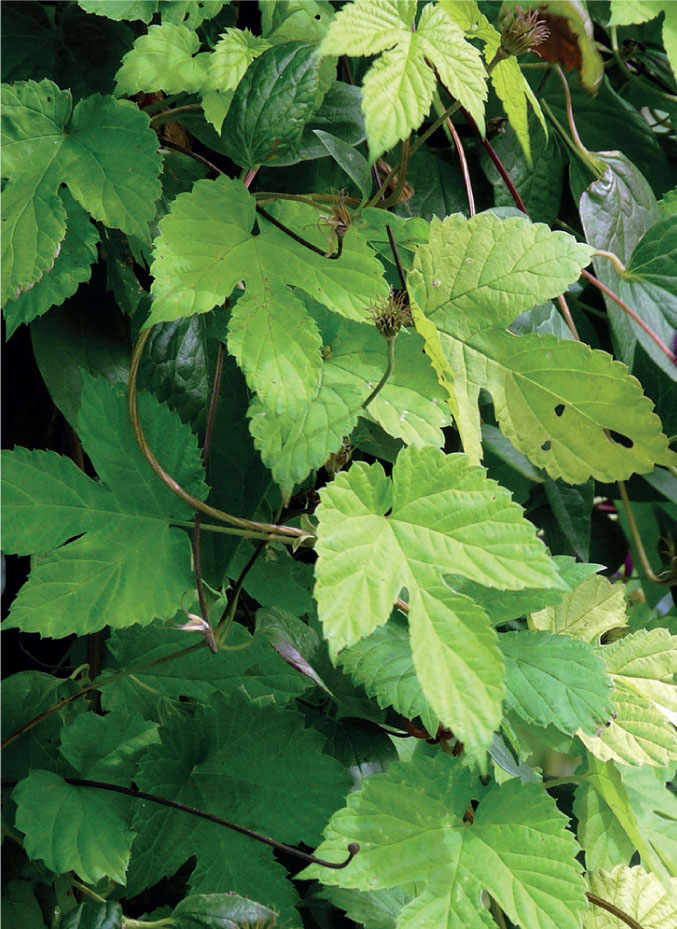
* Ivy Hedera helix
One of the workhorses of a wildlife-friendly garden. A familiar, evergreen, woody climber native to almost all of the British Isles, it climbs quickly up walls – even north-facing ones – and tree trunks, clinging with its short dense roots, and it will also carpet shady ground. The arrow-shaped, glossy leaves are eaten by a few moth caterpillars such as the Least Carpet, Yellow-barred Brindle and Willow Beauty, and the flowers by the caterpillars of the Holly Blue butterfly. Ivy also offers great cover for insects, encouraging visits by hunting tits and Wrens. The network of stems provides nesting sites for Robins and Spotted Flycatchers, and roost sites for many other birds. But it is when you encourage Ivy to grow into sunlight that it will shine the most, for only then will it flower. It is a superb autumn nectar source for butterflies (see here), wasps, bees (including being the sole food of the Ivy Mining Bee), many moth species and flies. The subsequent hard berries, super-rich in fat, are a staple winter food of Woodpigeons and Mistle Thrushes. Just be careful if growing it up house walls as you will struggle to remove the unsightly roots. There are all manner of cultivars and some related species to try, but many don’t flower as well as the original species.

Mistletoe Viscum album
One of Britain’s most curious plants, this is an evergreen perennial forming balls of lime-green foliage high up in apple, poplar, hawthorn or lime trees where the roots tap into the food supply of the host tree. It is native to lowland England. The flowers are tiny, but the white berries in autumn and winter are eaten by many bird species, including of course the Mistle Thrush. In fact, the plant relies on birds transferring seeds to the bark of another tree in order to spread.

Nasturtium – See Flowers.
* Roses Rosa
As well as the shrub roses here, I urge you to grow one of the single-flowered climbing or rambling varieties that will scramble up into a tree or over a trellis. The best not only have reams of gorgeous, simple flowers and arrays of small tasty hips but also help create a tangle of structure that may offer nest sites or at the very least safe lodgings for many creatures. Perhaps the very best is ‘Francis E. Lester’ (below), but there are others to try such as the orange-blossom scented R. ‘Wedding Day’, ‘Kew Rambler’, the yellow-flowered R. helenae and the very vigorous R. filipes ‘Kiftsgate’.

* Wisterias
Two similar species are grown in gardens: Japanese Wisteria W. floribunda and Chinese Wisteria W. sinensis. Their whippy stems wander up walls and over arches, thickening over time into a network of trunks. Their long leaves are divided into leaflet pairs, and the summer flowers are borne in beautiful cascades, loved by bumblebees and Honeybees. While not much wildlife feeds on the foliage, the branches form wonderful platforms for nesting birds such as Blackbirds, Robins and Spotted Flycatchers.

Bulbs
Flowers that grow from bulbs are typically one of the joys of spring but they are a mixed bunch when it comes to wildlife, with some appearing to offer very little value at all. However, a few are gems so here is my pick of the bunch.
* Alliums
A large family of bulbous perennials, including garlics, leeks, onions and their cultivars, typically with white or pink flowers in a dramatic, spoked globe at the top of a bare stem, much visited by bumblebees. The familiar herb Chives A. schoenoprasum is native to a few areas of Cornwall and mid-Wales on limestone and has pink pompom flowers emerging from the clump of grass-like leaves. Talking points for flowerbeds include A. rosenbachianum, A. hollandicum and A. cristophii which have giant, airy spheres of star flowers, or let a leek or onion go to flower and it will be just as successful. The one I think beats them all, however, is the Round-headed Leek A. sphaerocephalon (above), which can seem alive with bees. Just be aware that some of the heavily cultivated Alliums, such as ‘Globemaster’ or ‘Giganteum’, seem to have lost much of their attractiveness to wildlife.

Bluebell (English) Hyacinthoides non-scripta
A carpet of Bluebells is a glorious spring sight (and smell). A spray of basal leaves emerges in early spring, followed by the nodding, one-sided head of blue bells. It might seem a bit naughty that it has slipped into this list, because little wildlife actually uses it. There’s a little moth called a Bluebell Conch that might visit if you live near a bluebell wood, and Brimstone butterflies and mason bees may sip a bit of nectar from them. But this perennial bulbous plant is extra special because it is native only to western Europe including most of the British Isles, and is classified as ‘globally threatened’. So this is something you grow for the plant itself, not what life it supports. Only buy bulbs from reputable suppliers and, whatever you do, don’t grow Spanish Bluebells H. hispanica.
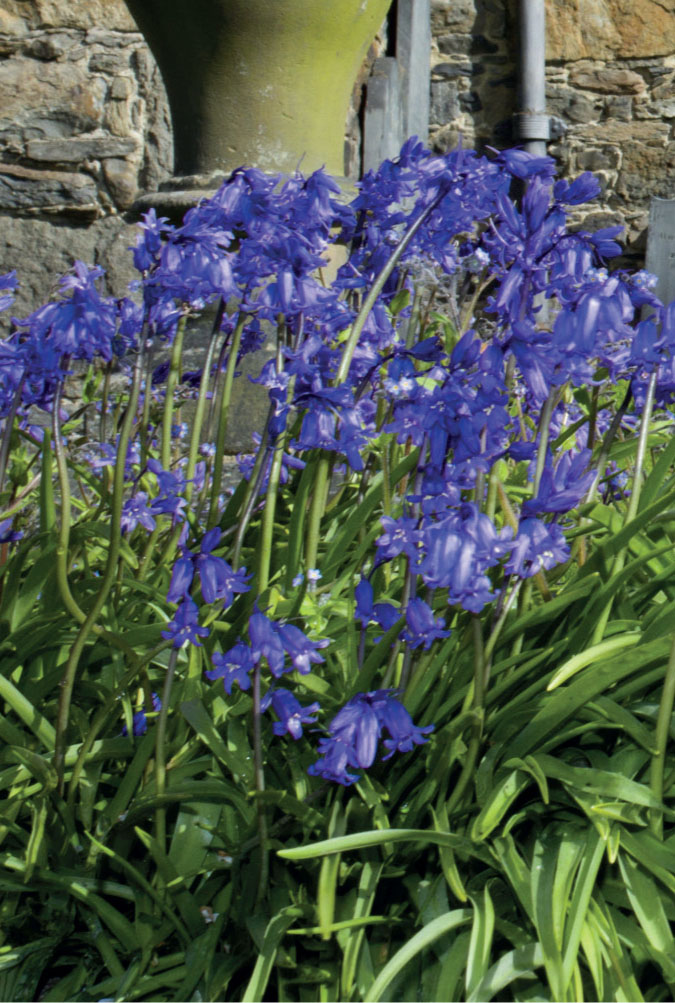
Crocuses Crocus
Plant these bulbs in a rather shady spot in the garden and they will disappoint and rarely open; give them a glorious and sheltered sunny location, however, and they will enthusiastically spread their pink, purple and lilac petals wide, welcoming bumblebees, Honeybees and hoverflies from as early as February in mild winters. Crocuses may not be native to the British Isles, but they haven’t come far, such as the ever-popular Dutch Crocus C. venus, originally coming from mainland Europe, and the rather more chunky C. tommasinianus from south-eastern Europe. Try C. angustifolius (above) from Russia for a splash of golden yellow. In the right place, it’s hard to go wrong with any Crocuses, especially when they are left to naturalise among the grass of a lawn left to become a spring meadow.

Daffodil, Wild Narcissus pseudonarcissus
You’re very lucky indeed if you see a large insect visiting a daffodil flower – they just don’t seem interested in them at all. However, turn back a flower head and you may find the inside dotted with tiny black beetles – pollen beetles. If you can, grow the rather delicate native species rather than the cultivars.

* Fritillary, Snake’s-head Fritillaria meleagris
A beautiful bulb for naturalising in a spring meadow. The large pendulous bells with their pink chequerboard markings are exquisite, held on slender stems and dangling a few inches above the grass. They are one of the best bulbs for bumblebees.

Grape Hyacinths Muscari
Mainly from the Mediterranean, this is quite a large group of easy-to-grow bulbous perennials and their cultivars, familiar in spring with bluebell-like leaves and tight little spikes of blue flowers barely 10cm high. These are a valuable early-spring nectar source for bees, especially solitary bees, with lots of varieties to try. Plant the bulbs in autumn in sunny spots that aren’t too damp.

* Sicilian Honey Garlic Nectaroscordum siculum
This, I think, is my favourite bulb for bees. A native of France and Italy, it sends up a tall slender stem in spring, from which a dozen or so pink-veined bells, each on its own fine stem, push upwards until they bend over under their own weight and dangle, inviting bees to enter from below. The seed heads are also attractive, and it’s the kind of plant that you can dot through and among other plants in the border.

Snowdrop Galanthus nivalis
I can’t claim that this ranks as one of the best plants for pollinators, but given that the pendulous white flowers bloom as early as January, it can really come into its own during those freakish mild spells in midwinter when some bees stir and have little else to turn to. Snowdrops are best planted ‘in the green’ after flowering – dig up clumps and replant in smaller groups that can then spread.

Squill Scilla
Although we do have some native species of Squill that are typically found on coastal clifftops around the British Isles, it is the Siberian Squill S. siberica that is most frequently planted in gardens. Barely rising 10cm above the clump of strap-like leaves, the nodding flowers are small and an intense blue, but the petals are spread more widely than a Bluebell and, grown en masse, they can be a useful food source in March for bees. They can be naturalised in a sunny woodland garden, where they get their moment in the limelight before the canopy closes over.
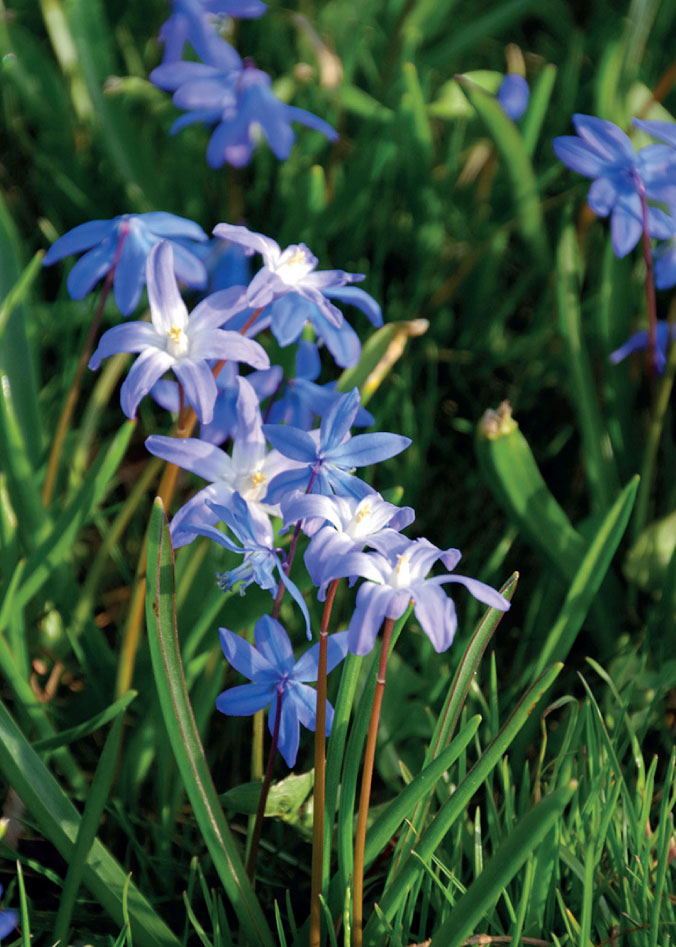

Flowers
Growing beautiful flowers has long been a bedrock of gardening, and it is one of the key ways of helping wildlife. In flower borders, freed from the shackles of growing among grasses, they can flower in profusion and set seed too. If you choose the right plants, pollinators, herbivores and their predators can thrive. Just remember to grow them in swathes rather than just ones and twos. Below is my selection of herbaceous perennials, biennials and annuals for flowerbeds, pots and planters. For further species for the wildflower meadow, see here, and for the cornfield garden, see here.
Agapanthus
Sometimes called African Lilies, but almost always known by their Latin name, these are rather lush-looking perennials, native to southern Africa, and their hybrid cultivars. Their splays of long, strap-like leaves radiate from ground level, from which the flower stems emerge to 100cm in late summer topped with a firework burst of blue or white bells; only a few cultivars seem to work well for pollinators, so snap up any that you witness being visited by bumblebees or Honeybees. Grow in well-drained soil, in sun or part-shade, and they will flower well if the roots are constrained. You may need to provide frost protection in colder areas.
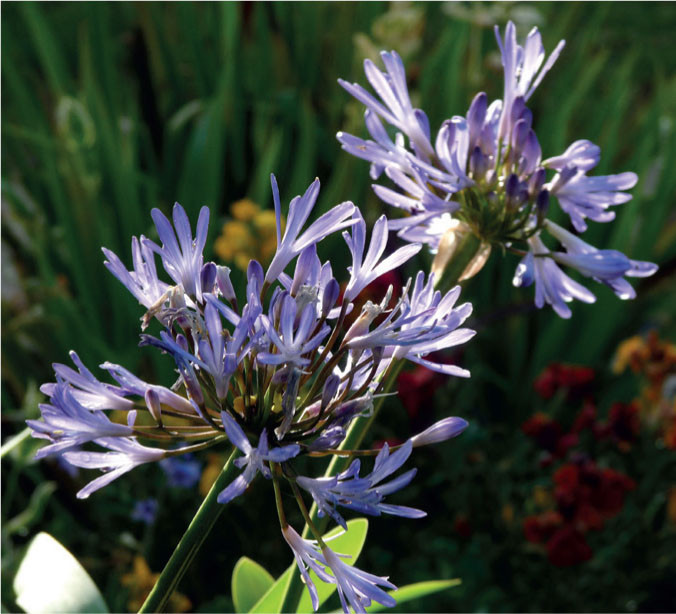
* Agastaches
An excellent genus of attractive and aromatic short-lived perennials and their cultivars, native to North America. Many look great in the flower border, forming compact or upright plants to 120cm with nettle-like (stingless!) leaves, topped with multiple spires of colourful summer flowers that are well-liked by bumblebees and Honeybees, and may be visited by butterflies such as Small Tortoiseshells and Painted Ladies. Try species such as Anise Hyssop A. foeniculum, with pink or purple flowers, Purple Giant Hyssop A. rugosa, with short purple flower spikes, and Mexican Giant Hyssop A. mexicana with pale lavender flowers. Just as good are some of the readily available and compact hybrids such as the excellent A. ‘Black Adder’ and A. ‘Blue Fortune’. Most like a sunny position on well-drained soils, although you may need to replenish from seed each year.

Alexanders Smyrnium olusatrum
Native to the Mediterranean, this perennial was introduced to Britain by the Romans for cultivation and is now common around southern coasts. A flush of fresh, rather pungent leaves emerges in midwinter, followed in March–May by big yellow-green umbels of clenched-up little flowers on top of hollow, metre-tall stems. These are visited by many insects, especially solitary bees and flies. It isn’t an obvious choice for the flowerbed, but it’s not unattractive – just rather green! It self-seeds easily, but is easily controlled by deadheading or weeding.

* Alkanet, Green Pentaglottis sempervirens
This boldly spreading perennial is really great for bumblebees and Hairy-footed Flower Bees. It is also one of the few flowers that Holly Blue butterflies seem to get stuck into. It is native to south-western Europe but long established in Britain. Very easy to grow and reaching about 60cm tall, it has rather rough oval leaves, above which bright blue flowers with a small white centre emerge from pink buds, flowering from spring into summer. Because of its invasiveness, restrict it to wilder parts of the garden and lightly shaded places such as hedgerow edges.
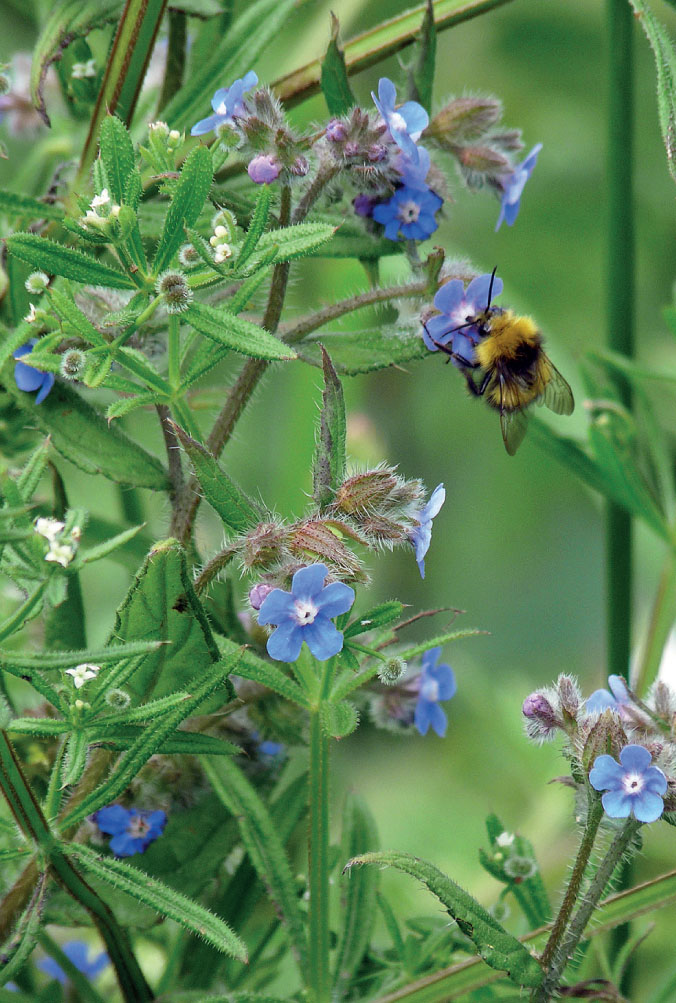
Anchusa Anchusa azurea
A member of the Borage family (which is always a good start as far as pollinators are concerned), this is a fine-looking herbaceous perennial from the Mediterranean, rather similar to Green Alkanet but with much richer purple-blue flowers, like large forget-me-nots. Grow in well-drained soil in a very sunny position for best effect, where bumblebees in particular are likely to visit regularly.

* Angelica (Wild) Angelica sylvestris
Bold biennial or short-lived perennial up to 2.5m tall, native throughout the British Isles on rich, moisture-retentive soils in sun or part-shade. Large, shapely leaves emerge from great pin-striped sheaths, and the purple stems are topped with big loose umbels of whitish pompoms, June–September, a magnet for a wide range of insects including solitary bees, flies, hoverflies and beetles. Every umbel can be chock-full of life. Try also the cultivar A. sylvestris ‘Purpurea’ (also known as ‘Vicar’s Mead’) with purple foliage, the even larger Korean Angelica A. gigas (above) from eastern Asia with reddish flowers, or A. archangelica, the tall biennial culinary herb which likes sunny well-drained positions where A. sylvestris will not thrive.

* Anthemis
The stand-out species in this genus is the perennial Dyer’s Chamomile A. tinctoria (above). It is a clump-forming short-lived perennial from mainland Europe to 90cm tall, with finely cut leaves above which are masses of large-centred yellow daisy flowers that bloom over a long season. Solitary bees and tiny wasps delight in the flat-topped flowers. Hardy, easy to grow and quick to flower, it’s great for a herbaceous border, especially on light soils, and there are several good cultivars to try.

Aubretia (Purple Rockcress) Aubrieta deltoidea
A native perennial of southern Europe, commonly grown to spill over rockeries and low walls in a mat of small leaves. These are studded in March–June with hundreds of pink to magenta flowers visited by Honeybees, bumblebees, hoverflies, flies, Bee-flies and butterflies such as Peacocks. It and its many hybrid cultivars like full sun and a well-drained soil.

* Bedstraws Galium
This family is little cultivated, but there’s definitely a place in gardens for them. Typically the different species form long trailing stems with whorls of tiny leaves and a froth of small, star-like, usually white flowers. Especially good is the rather delicate and low-growing Lady’s Bedstraw G. verum, native to meadows throughout the British Isles, and unusual in its yellow flowers. It is the food plant of Hummingbird Hawkmoth and Elephant Hawkmoth caterpillars, among others. The more robust Hedge Bedstraw G. mollugo, native of lowland Britain but not Ireland, is good for sprawling through hedges, and is also used by the hawkmoth caterpillars above, plus those of Cream Wave, Small Scallop, various carpet moths and the Small Elephant Hawkmoth. Bedstraws are also eaten by the Bloody-nosed Beetle.

Bee Balm (Bergamot) Monarda
This is – as its name suggests – a staple plant in the bee-friendly border. It is a herbaceous perennial from North America, throwing up clumps of serrated-edged leaves in spring. Then in late summer it is topped with rather spidery flower heads in reds and pinks, each one a whorl of individual tubular flowers clustered around a domed head of short bracts. There are plenty of cultivars to choose from, and I have yet to find one that doesn’t attract at least some bees, with the added bonus of Small Tortoiseshell and other large butterflies. However, it can be temperamental! It doesn’t like wet winters, yet also doesn’t like to dry out in summer.

* Bellflowers Campanula
Including some of Britain’s most beautiful native flowers, these perennials are insect pollinated, some by bees, and are also used by Campanula-specialist pollen beetles, gall-forming mites and gall-flies. Nettle-leaved Bellflower C. trachelium is native to much of southern England on dry, base-rich soils, with a beautiful flower spike, up to 80cm, of purple-blue bells in June–September. The nettle-like leaves are eaten by the Campanula Pug moth. Giant Bellflower C. latifolia is native from the English Midlands up into Scotland. The flowers are even larger than Nettle-leaved on an even taller stem. Both prefer to grow in shade or along a hedgerow, Milky Bellflower C. lactiflora (above) is a good garden substitute.
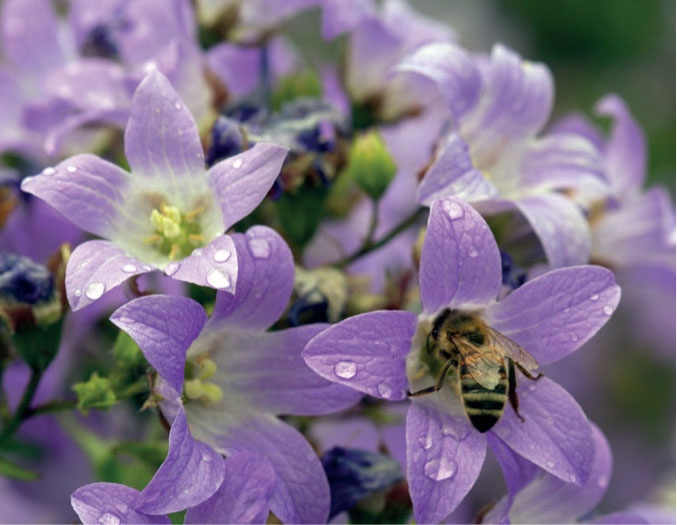
Betony Stachys officinalis
Growing to 75cm at most, and native in hedgerows, woodland rides and unspoilt grasslands throughout much of England and Wales, this perennial bears heads of small, claret-coloured, hooded flowers in midsummer. It can be grown in flowerbeds or in meadow areas, and there is also a lovely white form ‘Alba’ to try. Some butterflies such as Brimstone and skippers visit it, as well as bumblebees.

* Bird’s-foot trefoils Lotus
Top wildlife marks for these must-grow, low-growing relatives of the clovers, native perennials across much of the British Isles. The commonest are Common Bird’s-foot Trefoil L. corniculatus (above) of dry meadows and Greater Bird’s-foot Trefoil L. pedunculatus from damper grassy places. Both have clover-like trefoil leaves and heads of yellow pea flowers carried over a long season. They are essential as the caterpillar food plants of the Common Blue butterfly and various moths including burnet moths and the Burnet Companion, while adult Common Blues and short-tongued bumblebees will nectar from the flowers. Common Bird’s-foot Trefoil works well in lawns, forming mats of cheerful yellow if the mower is lifted a notch, or even in stone walls.
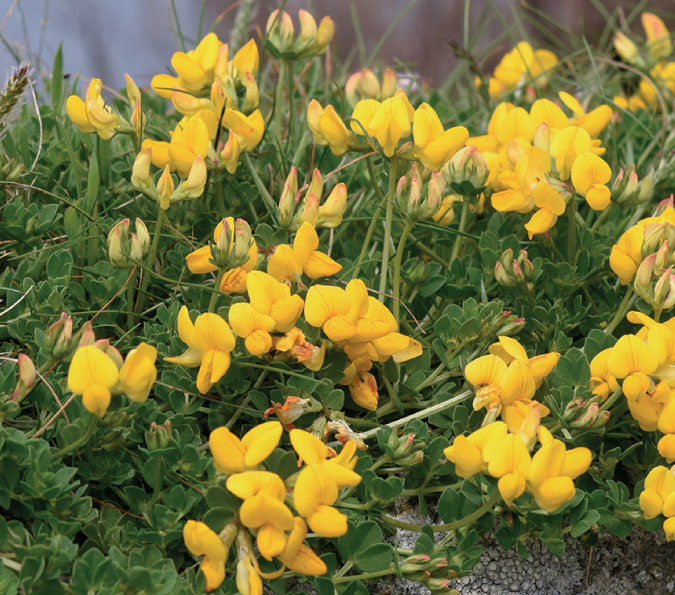
Bistorts Persicaria
I think it’s fantastic that some native plants are sold by garden centres, unaltered, for flower borders, and this knotweed family includes one of them, Common Bistort P. bistorta. It looks great in high summer, with candyfloss-pink drumstick flower heads the size of a cocktail sausage on slender stems held up above the carpet of green leaves. It doesn’t appear to have many insects associated with its foliage, but no matter, for it is excellent for bumblebees and some other pollinating insects. Left to spread in damp or even boggy ground, it will create good ground cover, reducing your need to weed! Another two to try are from the Himalayas, one called P. amplexicaulis, the other P. affinis ‘Donald Lowndes’ (above). The former includes a range of cultivars, often with much redder, more slender flower heads than Common Bistort, and also rather taller. The latter I think is great for the front of a border, barely taller than 20cm high, with a mat of slender leaves. Again, they are good bee plants.

* Blackroot/Culver’s Root Veronicastrum virginicum
Closely related to the speedwells and part of the foxglove family, this perennial is magnificent for bumblebees and Honeybees. From north-eastern America, it grows to 1.2m, topped with an array of the slenderest pointed candles of flowers borne July–September, which depending on the cultivar can be pink, white, purple or lavender blue. They need a good sunny position, and will be a star at the back of a border.

Blanketflower Gaillardia x grandiflora
From America, this is like a flower as drawn and coloured-in by children, the large daisy flowers with (usually) bold red centres and yellow tips. Growing about 30–60cm tall, it is a short-lived perennial and probably underused in the wildlife-friendly garden, given that they have a very long flowering season and can attract butterflies and all manner of bees, especially bumblebees. Single-flowered seed-raised strains are the best. It needs a light, well-drained soil or it will not get through the winter.
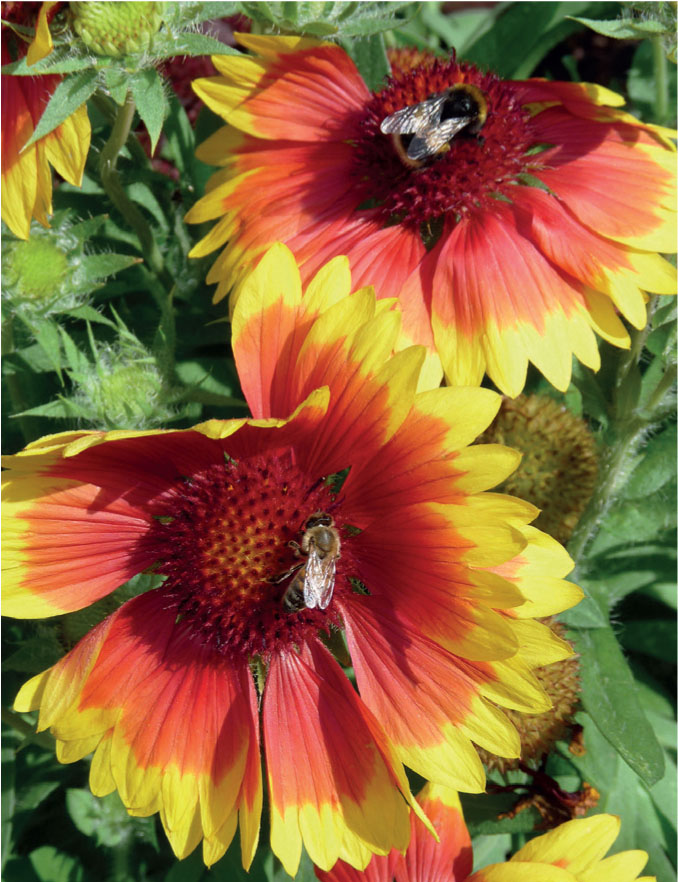
* Borage Borago officinalis
An annual, native to the Mediterranean but widely naturalised in British lowlands, this is a bushy hairy plant growing to 90cm, with attractive (and edible!) bright blue flowers, May–September, where bumblebees flock! There is an attractive white-flowered form. They do best in a moist, rich soil and are very easy to grow from seed.
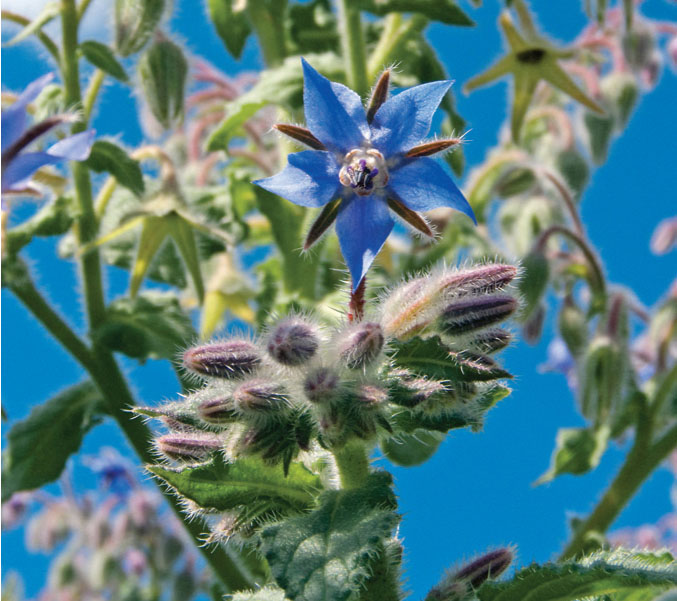
Bugbane Actaea simplex
Sometimes listed as Cimicifuga, Snakeroot or Baneberry, its tall flower stems grow to 2m from the deeply cut purple foliage and bear dense spires of tiny white flowers in late summer and autumn. These are adored by Red Admiral and Comma butterflies and by bumblebees. It needs moist soil, and does best in a little shade, but is prone to slug and snail damage when young. Cultivars to try include ‘Brunette’ and ‘James Compton’.

* Bugle Ajuga reptans
Scrambling hardy perennial, an essential plant for the woodland garden, and native to most of the British Isles. Spikes of blue flowers in April–May poke 10–20cm above the ground-hugging bronzed foliage. It is an excellent source of early nectar for Green-veined White and Orange-tip butterflies and for bees. It prefers moist soils in semi-shade, spreading vigorously using runners. Several cultivars are available, mainly for flower and foliage colour. It can be grown in a damp lawn in a ‘spring meadow’ regime.

Burdocks Arctium
A small group of closely related species, native to most of the British Isles, with Lesser Burdock A. minus the most widespread. They are herbaceous perennials of woodland and hedgerows, with broad basal leaves. The flower stems are up to 90cm tall, and bear rounded hook-covered flower heads topped with small, purple thistle-like flowers loved by Honeybees, bumblebees and butterflies such as Peacocks, Commas, Red Admirals and Painted Ladies. The burr-covered seed heads persist all winter and are visited by Greenfinches and Goldfinches. Grow them in moist, rich soil in semi-shade in wilder parts of the garden. They self-seed effectively; just be aware that the burrs can be a problem for livestock, pets or woolly socks!

Calamints Clinopodium (also known as Calamintha)
Excellent for bees, Common Calamint C. ascendens (Calamintha sylvatica) is a perennial herb native to base-rich soils in southern Britain, but more familiar in gardens is the paler-leaved Lesser Calamint C. calamintha (Calamintha nepeta), found naturally in just a few parts of East Anglia and good on dry, stony soils. Both grow to about 60cm, with rounded mint-scented leaves and small pink flowers with maroon spotting, borne in loose whorls up the stems. Also in the genus is Wild Basil C. vulgare (above), a native perennial to much of the British Isles although absent from uplands, growing to about 30cm with whorls of pink flowers up the stem and small, downy leaves with a soft aroma. It is found in hedges, coastal areas and downs, usually on alkaline soils, and is similarly enjoyed by bumblebees and also skipper butterflies.

* Campions and Catchflies Silene/Lychnis
Moths are the primary pollinators of this group of plants, especially from the Hadena genus whose caterpillars also feed on campion foliage and their seeds. Weevils, bugs and some bumblebees also visit. My favourite is Red Campion S. dioica (above), growing to 1m tall, with intense pink flowers borne mainly April–June but some flowering until November. It is native to almost all the British Isles, and enjoys the light shade of hedgebanks and open woodland. Expect to see noctuid moths nectaring at dusk; caterpillars of the Rivulet moth also feed on it. It self-seeds readily.
White Campion S. latifolia is an archaeophyte throughout most of the British Isles, flowering May–October often on sunny field margins. It can be used in a cornfield mix as an annual but another archaeophyte, the Night-flowering Catchfly S. noctiflora is often a better choice. The perennial Bladder Campion S. vulgaris, good for long-tongued bumblebees, grows to 1m in dry, grassy places throughout the British Isles, and the similar but shorter Sea Campion S. uniflora is found right round our coast on cliffs and shingle. Both have white flowers, the petals emerging from an inflated papery case, and the latter is the food plant of the Netted Pug moth caterpillar. Ragged Robin Lychnis floscuculi is a familiar perennial of wet meadows and ditches, growing to 75cm, with deeply cut pink petals. It is native throughout the British Isles and lovely in a damp garden meadow.

Candytufts Iberis
Some candytufts are visited by butterflies, including Red Admiral, Painted Lady and Small Tortoiseshell. The annual Candytuft I. amara is a British native but only to the Chilterns. It likes bare ground in full sun, preferably on chalk, and is short lived with white flower heads, May–August. Grow from seed. Several related species and their cultivars from southern Europe are commonly grown in gardens, including I. umbellata in shades from white to pink to purple, and the evergreen I. sempervirens, which is like a tiny shrub. They can be a bit hit-and-miss, but are worth a try.
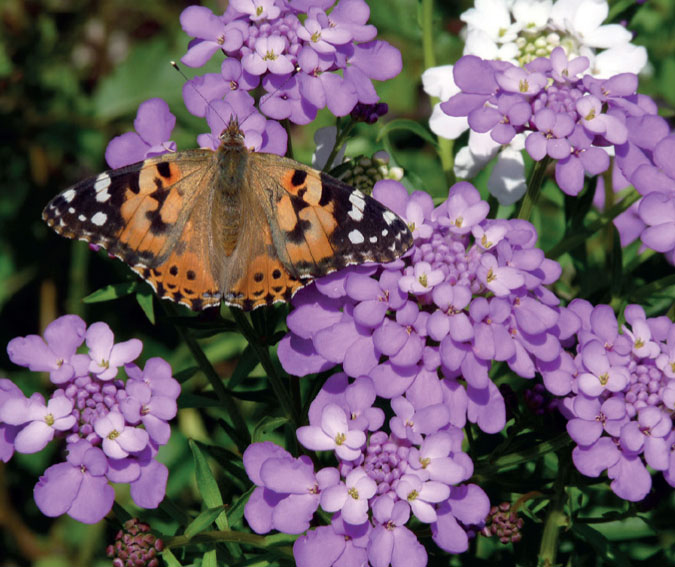
Cardoon (Globe Artichoke) Cynara cardunculus
Dramatic perennial from the Mediterranean, whose large purple-topped thistle flowers crawl with happy bumblebees and other insects, but you’ll need a big garden for it not to look out of place. The flower stems grow to 2.5m in a season, and the thistle-like leaves can spread just as wide. It needs full sun and well-drained soil, and can be propagated by seed or division in spring.
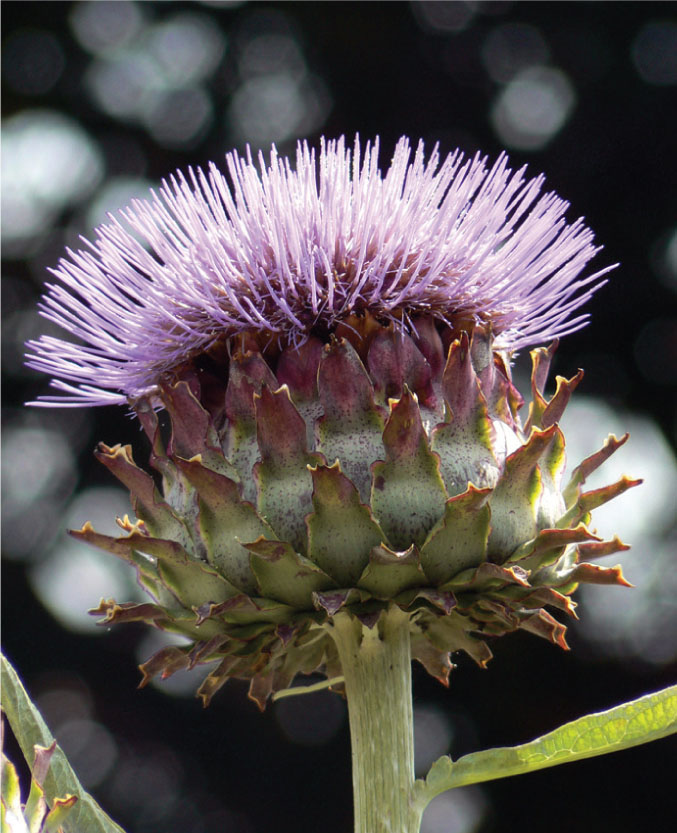
* Catmints Nepeta
A brilliant genus of hardy perennial plants for Honeybees and bumblebees – almost every variety I have seen works. Most have a haze of bluish or mauve flowers from June onwards on spreading clumps of rather glaucous foliage. Catmint N. cataria is an archaeophyte on southern English chalk, bushy to 90cm at most with a strong mint smell and small white flowers flecked with pink that are much appreciated by Honeybees; however, cats like it even more and will trash plants by rolling deliriously all over them! Instead, my cat-resistant favourites include N. x faassenii, a hybrid of two Caucasian species; it and its widely available cultivars ‘Six Hills Giant’ (above) and ‘Walker’s Low’ are great for edging a border. Hairless Catmint N. nuda from southern Europe isn’t quite so hot for bees, but is a lovely airy plant growing to 120cm; N. subsessilis from Japan grows to 90cm with tighter heads of larger purple-blue flowers and is liked by bumblebees; and N. nervosa from Kashmir has upright spikes of flowers, rather like Bugle. Catmints generally like hot, sunny positions in a free-draining soil.

Chicory Cichorium intybus
Hardy perennial growing to 1m, native to southern Europe but long since naturalised throughout much of southern Britain. The flowers are a little bit like blue dandelions, but held on tall, branched stems; they are visited by hoverflies, Honeybees and some solitary bees and bumblebees. It will grow in poor soil thanks to its deep tap root and likes a sunny position. Finches will eat the seeds if you grow en masse.
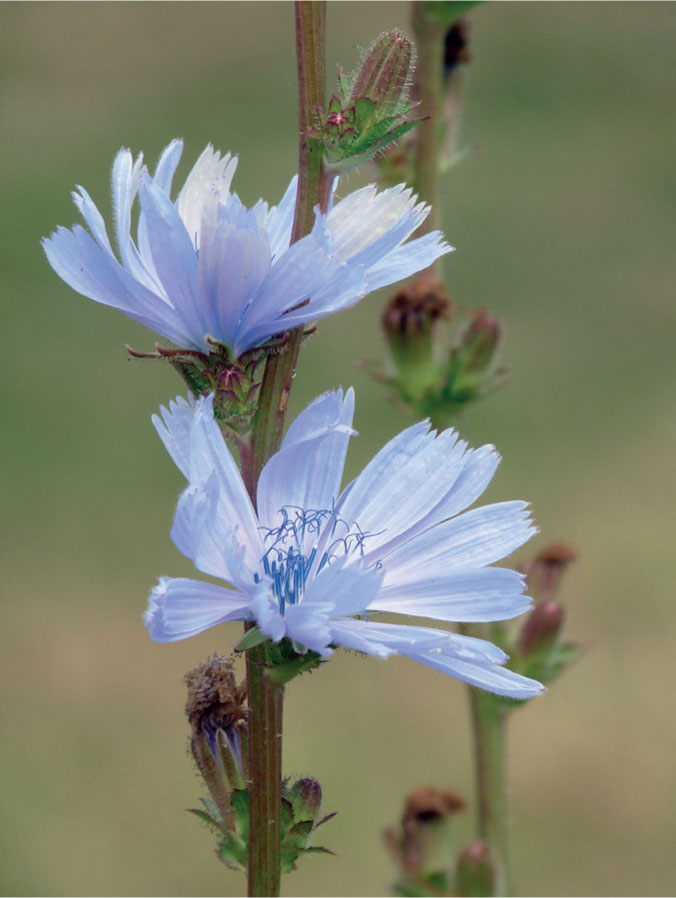
* Clovers Trifolium
‘Trifolium’ means three leaves, a familiar feature (unless you’re very lucky and find one with four!) of these grassland plants that gardeners often want to eradicate from their lawns; you’ll hopefully want to encourage them instead. Two perennial species stand out by being native to almost every corner of the British Isles and for having flowers that are a favourite of bumblebees and Honeybees. White Clover T. repens (above) can grow to 50cm if unchecked, with rounded heads of whitish flowers; there are many different strains used in agriculture, but look for seeds listed as ‘wild White Clover’. It can be mixed with a hard-wearing grass seed mixture to add life to a new lawn. It can boost the nitrogen in a lawn, helping the grasses, so you might prefer to go for Red Clover T. pratense, which is a bit more robust than the White, with rounded heads of pinkish (not red) flowers. Both don’t mind being trampled or cut. The foliage is eaten by Narrow-bordered Five-spot Burnet, Shaded Broad-bar, Common Heath, Mother Shipton and Burnet Companion moth caterpillars, plus clover sawflies and several weevils and gall midges. For bees, just allow the clovers to spread across a lawn and give them a chance to flower by holding off with the mower in summer. My favourite clover of all is Zigzag Clover T. medium (below) – its name is great, the larger flowers are a deeper, richer pink than Red Clover, and I find them more reliable for attracting butterflies.


* Columbine (Granny’s Bonnet) Aquilegia vulgaris
It is hard to believe that such an exquisite blue flower is native to most of the British Isles. It grows to 90cm, the flowers dangling above delicate triple-leaved foliage in May–June. It is visited by long-tongued bumblebees while aphids feed on the stems, attracting ladybirds. It has been the plant breeder’s dream, producing all manner of gaudy colours, but stick to the simple, gorgeous original and definitely avoid doubles. It prefers a rich, well-drained soil in sunny woodland, and self-seeds readily.

* Comfreys Symphytum
Several species of vigorous clump-forming perennials, all rather coarse and best kept to more informal parts of the garden, where their leaves can be harvested to make home-made liquid fertiliser. Their drooping bell-flowers are superb for bumblebees, and various flea beetles and weevils feed on them too. Common Comfrey S. officinale is probably native to most lowland areas of the British Isles, growing to 1.5m with crimson, mauve or white flowers from May to July, and preferring damp, ditch-side conditions. Russian Comfrey S. x uplandicum, a garden hybrid, can grow even taller and in drier conditions, with purple flower buds opening to deep blue. It is well established in Britain having once been a fodder crop. Tuberous Comfrey S. tuberosum is less in-your-face, growing only to 60cm with pale yellow flowers, and is native to much of lowland Scotland. Creeping Comfrey S. grandiflorum, from southern and eastern Europe, only grows to 40cm high, and is good for ground cover; although not especially pretty, it does flower from early in spring. However, top of my list for looks are the powder-blue comfreys such as ‘Hidcote Blue’ (above), which is an early flowerer and great for Hairy-footed Flower Bees.

* Coneflower Echinacea purpurea
Clump-forming perennial, growing to 120cm, native to the eastern American prairies, the roots being used for the herbal medicine you might recognise from the Latin name. It has dramatic flowers with pink outer petals (rays) and a dense mound of orangey central florets, especially enjoyed by bumblebees but also well used by other bees and many butterflies (see here). The seed heads form attractive ‘cones’ offering seeds for finches and Blue Tits. Grow in full sun and well-drained, fertile soil but keep well watered in summer. There are several cultivars with varying ray colour and shape that are worth growing, but I heartily recommend the gorgeous and simple original species. To propagate, divide in spring or autumn.
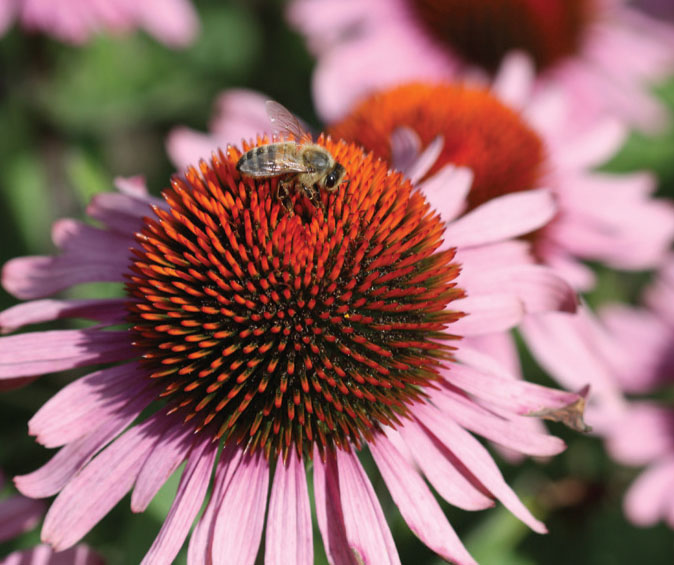
Coral Bells Heuchera
The sheer explosion in the number of cultivars of these North American perennials in the Saxifrage family has been astonishing. All have that basic characteristic of a neat mound of lobed leaves from which grow several slender flower stalks topped with sprays of very small pinkish or red flowers. Heucheraholics love them for the sheer profusion of leaf colours and patterns, from acid greens to purples. I was ready to dismiss them as worthless, but actually the flowers have proven to be great for some bees. I find that those with larger, red flowers such as ‘Firefly’ tend to do best, and be aware that those with green leaves will cope better in shadier conditions.

Cornflowers See Knapweeds and cornflowers
Corydalis solida
I don’t think anyone really knows this by the name Fumewort, so I’m sticking to the Latin name for this delicate perennial that originates from mainland Europe and is a good bumblebee plant early in the spring when little else is in flower. Above the ferny foliage, the shoals of flowers (for I think they look like little fish!) are pink with a hint of blue (in the photo above with Scilla) and are unusual in that they point downwards, with the long spurs at the rear pointing skywards.
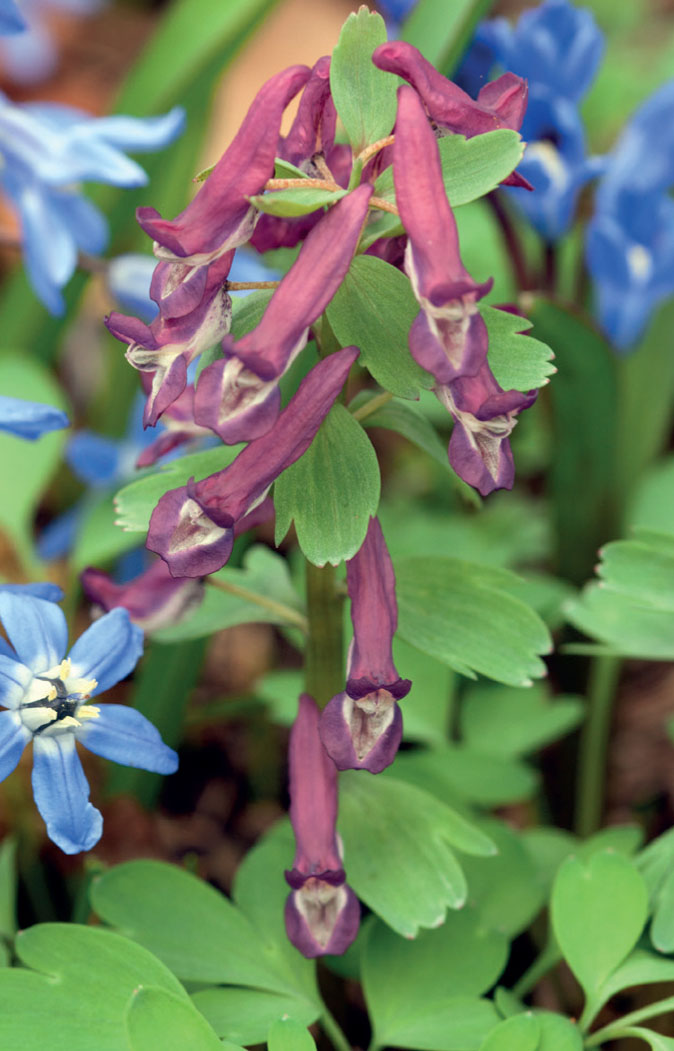
Cosmos Cosmos
Bees enjoy these three Central American plants and their cultivars, widely grown in gardens for their open, gaudy flowers. Chocolate Cosmos C. atrosanguineus (below) is a tuberous perennial, up to 60cm, with deep-red flowers and a scent that does have a touch of chocolate about it. It will struggle in cold winters. Frost-tender annuals to easily grow by scattering seed on prepared soil or in a large pot are C. bipinnatus with very feathery leaves and C. sulphureus with more simple leaves, which grow to 90cm. Cosmos generally like full sun and a moist, well-drained soil, and may need staking.
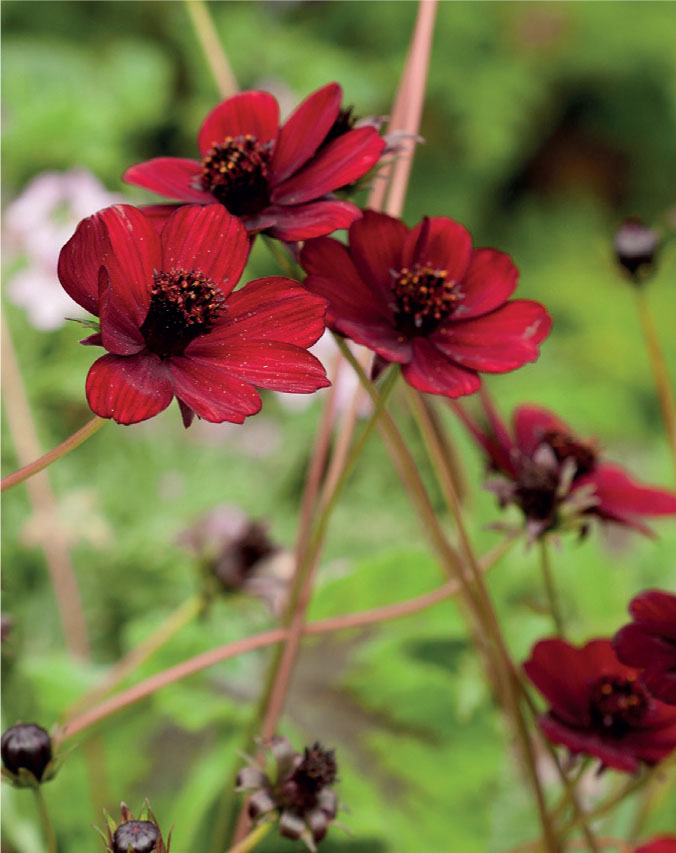
Cowslip Primula veris
With its nodding head of yellow flowers, this native of lowland meadows of the British Isles is much planted on road verges, although it is rare in the north. It is pollinated by early bees such as the Hairy-footed Flower Bee. It can sometimes cope well when added as plug plants to a lawn, and once it settles in and starts to self-seed, it can create a wonderful spring display.
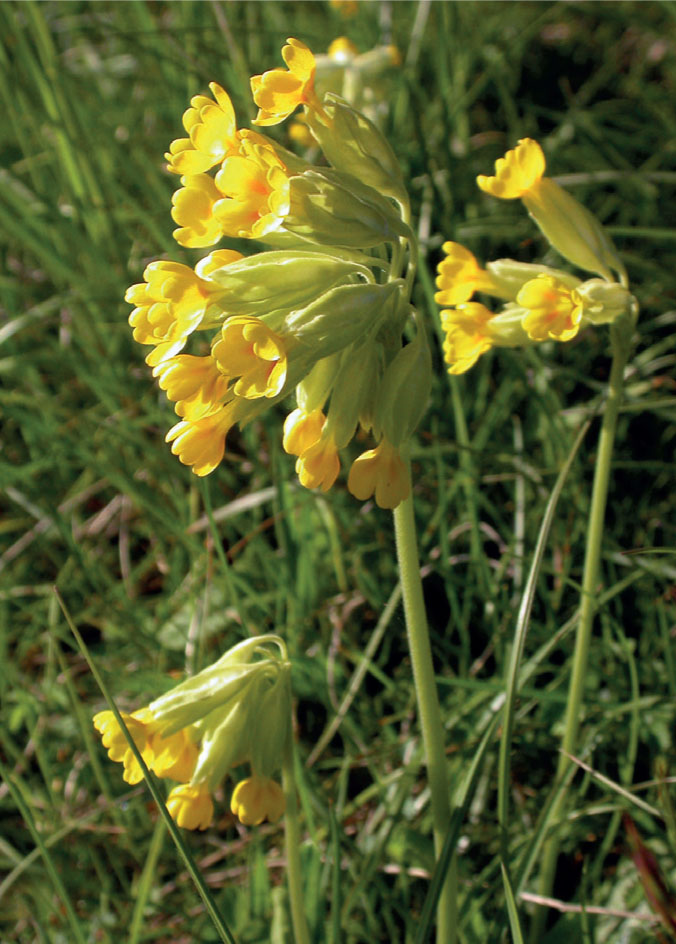
* Cranesbills Geranium
A fantastic family of mainly sprawling or semi-erect perennials, adored by bees. Don’t confuse them with pelargoniums, which are often sold as Geraniums but are something different altogether! Of the many species and cultivars of true Geraniums, most are usually less than 80cm high, have palmate leaves and are covered in delightfully simple, open, five-petalled flowers. Key species to look for include: Dusky Cranesbill G. phaeum, native to the Alps and Pyrenees, which has the most saturated dark maroon flowers; Meadow Cranesbill G. pratense, with large blue-mauve flowers, one of our most beautiful native plants, found on road verges and meadows in most of inland Britain (but not Ireland); the exquisite Bloody Cranesbill G. sanguineum which is a sprawling native to some of our coastal cliffs, dunes and northern limestone areas; and one of my favourite flowers, Wood Cranesbill G. sylvaticum, coping in half-shady positions and with pinkish flowers with a white centre.
There are also dozens of cultivars to choose from, such as ‘Mavis Simpson’ (left); in fact, it’s hard to find a bad one for bees if you stick to those with single flowers. The hybrid G. x magnificum (above) is especially good – it just keeps on flowering, and soon your local bumblebee population will learn that it is a plant that never stops giving. Geraniums tend to be happy in most soils, except those that are very wet, and most like sun or semi-shade. However, G. x macrorrhizum can cope even in almost full shade and spreads well, extending the family’s value even further.
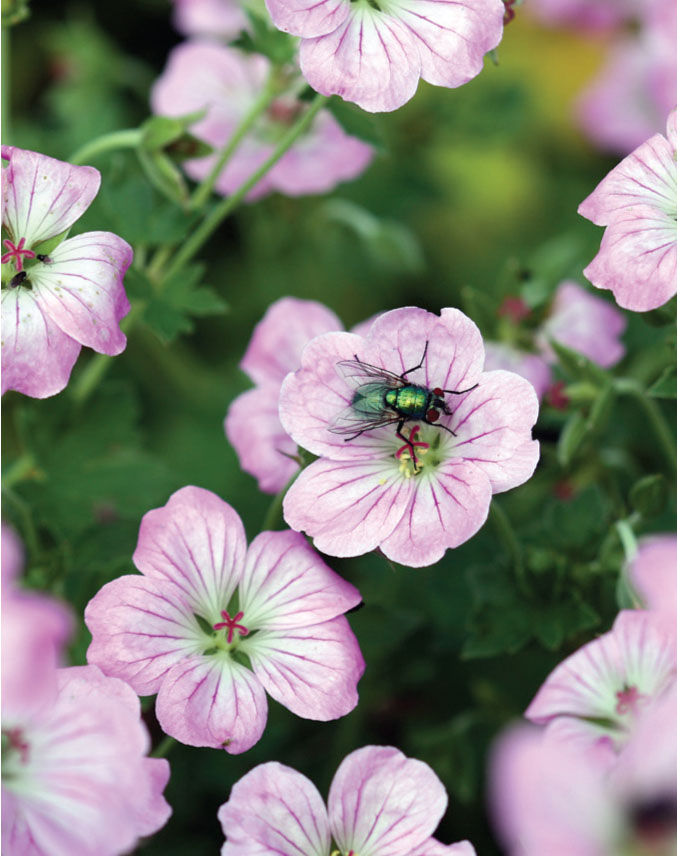

Dahlias Dahlia
Most readily available in this large genus are hybrid cultivars of D. coccinea and D. pinnata from Mexico, with big showy flowers in reds, pinks, oranges, yellow and whites. Take care! Only the single-flowered varieties and some of the ‘collerettes’ and ‘doubles’ will do – all the hundreds of ‘pompom’, ‘cactus’ and other extravagantly petalled cultivars are at the expense of the all-important nectar and pollen. Find the right ones, however, and they can be simply brilliant for pollinators, from bumblebees and Honeybees to hoverflies and even a few butterflies. Good varieties include ‘Yellowhammer’, ‘Twyning’s After Eight’ and ‘Moonfire’, while the widely sold ‘Bishop of Llandaff’ and ‘Bishop’s Children’ do well too; personally I adore the ‘Happy’ series (above). Dahlias will flower from midsummer right through to the first frosts. They take some effort – they are prone to earwig, slug and snail damage and mildew, often need staking, and most need to be lifted in winter to avoid the frosts. But if you have the time to care for them, they are well worth the effort.
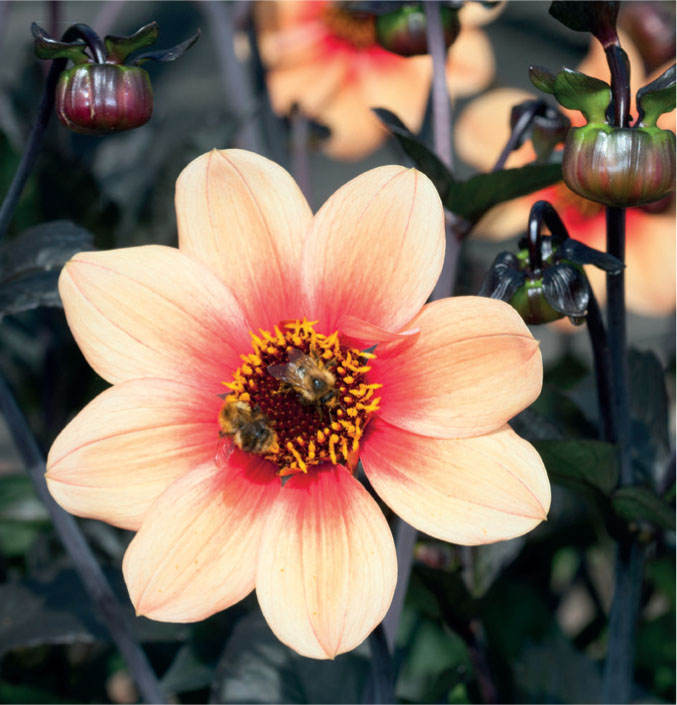
Dame’s Violet (Sweet Rocket) Hesperis matronalis
Slightly ungainly cottage-garden perennial, growing to 1m, with sweetly scented four-petalled flowers in pink, white and mauve borne over a long flowering season. It is a favoured drop-in for white butterflies and particularly for Orange-tips. It is widely established across much of the British Isles, originating in southern Europe, and prefers slightly shady hedgebanks and streamsides.

* Dead-nettles Lamium
This group of ground-cover plants has big-hooded, open-mouthed flowers much loved by bumblebees, and includes two common but attractive ‘weeds’, the Red Dead-nettle L. purpureum and White Dead-nettle L. album (above), both of which are archaeophytes found across most of the British Isles. They flower March–November. The Red is an annual of fertile, turned soils, sometimes persisting in lawns. It grows to 40cm, with purple-red whorls of flowers and round soft leaves that are often red-tinged. The White is a neat perennial of hedgerows growing to 60cm and with pure white whorls of flowers. Funny then how we ignore the ‘boring’ weeds and grow similar plants from garden centres, such as L. maculatum (below) from southern Europe and its cultivars. Fortunately, they’re still great for bumblebees, and they cover the ground well in shady – even dry – spots. Other insects use dead-nettles, too, including many generalist moth caterpillars, pollen beetles, the Pied Shieldbug and the Wool Carder Bee.
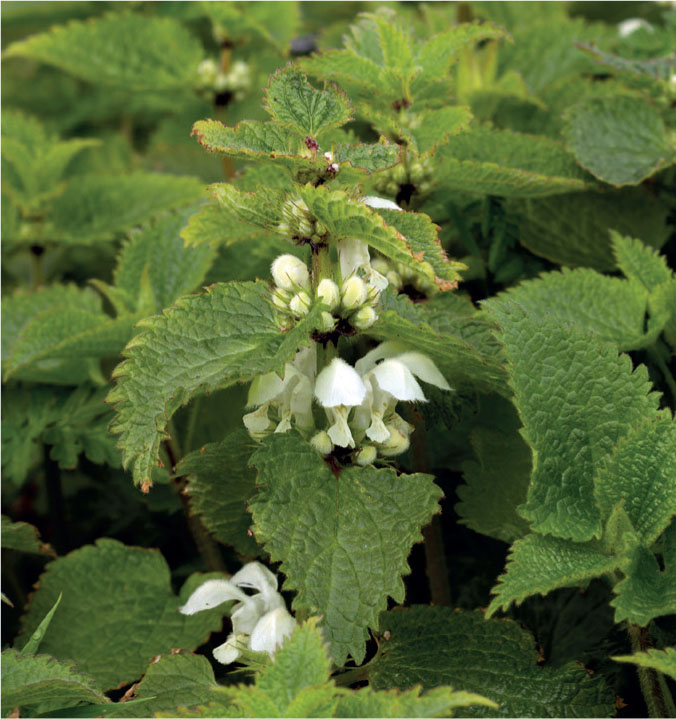

Delphiniums
Although the delphinium family includes several species of hardy perennials native to North America, Asia and parts of Europe, most grown in gardens are hybrid cultivars. They produce spikes densely packed with blue, mauve or pink flowers, the tallest (at over 2m) requiring staking. Most are enjoyed by bees, especially the larger bumblebees, and the foliage is eaten by the caterpillar of the Golden Plusia moth. What you may struggle with are slugs and snails, which love them even more – swap to Larkspur if that is the case. Grow delphiniums in rich soil in a sunny position, keep them well watered and avoid the doubles.
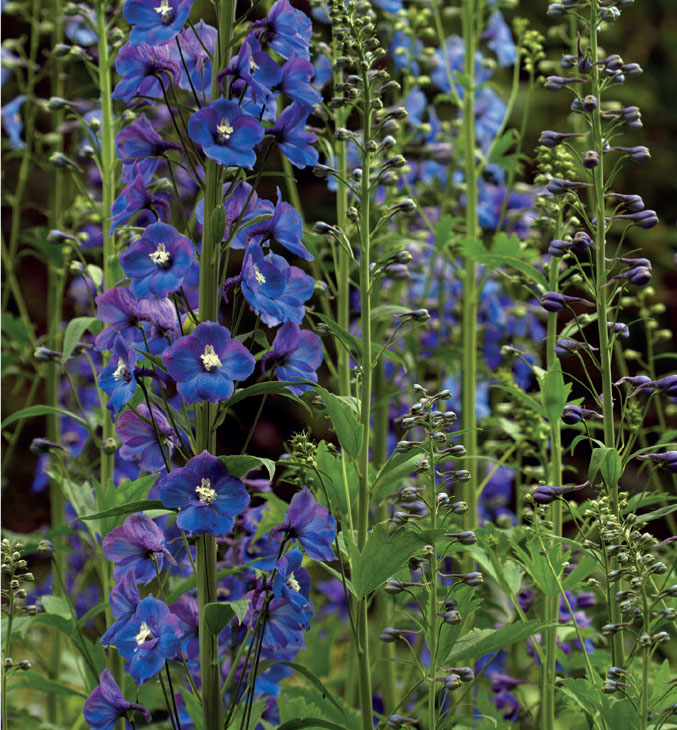
* Fennel Foeniculum vulgare
Tall hardy perennial in the carrot family, growing to 2m, probably native to the Mediterranean but grown as a herb in Britain since Roman times and now naturalised in southern coastal areas. Broad umbels of small yellow flowers attract all manner of insects, including hoverflies, flies, soldier beetles, parasitic wasps and solitary bees, the kind of insects poorly served by many garden flowers. It self-seeds readily but is easy to control. ‘Purpureum’ is an attractive cultivar with bronzy foliage.

* Fleabane, Common Pulicaria dysenterica
Native herbaceous perennial of damp grassy places in most of the southern half of the British Isles, spreading to form stands of rather furry leaves. These are topped with loads of golden composite flowers from July to September, with large centres and rather short ray petals. It’s not a plant you’ll find in most gardening catalogues (so you’ll need to go to a wildflower supplier or collect seed), but it is so good for butterflies (see here) that it should be! It also supports several micro-moths, plus leafhoppers and leaf beetles.

* Foxgloves Digitalis
The Common Foxglove D. purpurea is a gloriously showy, short-lived perennial or biennial of woodland glades, native throughout the British Isles. The familiar flower spike, growing up to 2m, is produced June–August, with dangling deep-pink bells into which long-tongued bumblebees clamber, while the Foxglove Pug (moth, not dog!) feeds on the leaves. Common Foxgloves prefer acid soils, moist and rich, and do well in light shade, self-seeding well. A white version ‘Alba’ is widely available, and I’d select those over most of the various cultivars. However, think about growing some of the more subtle perennial species, too, such as Large Yellow Foxglove D. grandiflora, Yellow Foxglove D. lutea, which is good for woodland areas, and Rusty Foxglove D. ferruginea (above), best in dry sunny places; the latter two are great for small solitary bees. Perhaps the best I’ve found so far for pollinators is ‘Goldcrest’, a hybrid between D. obscura and D. grandiflora, which seems to draw in bees from miles around.
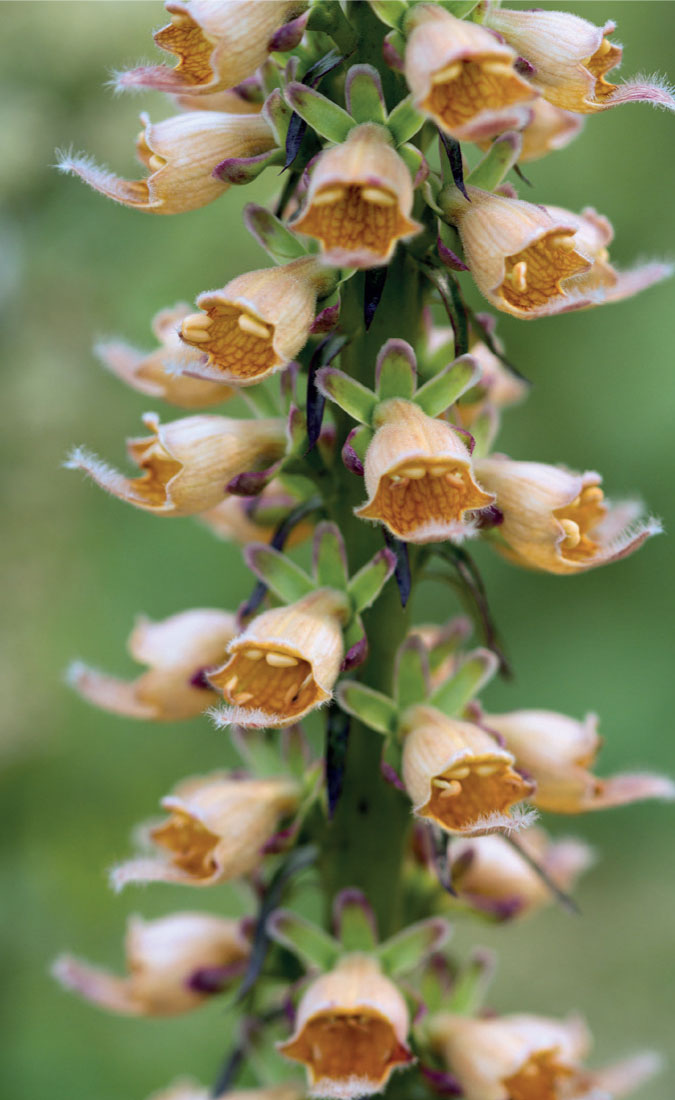
Gayfeather Liatris spicata
A herbaceous perennial, growing to 90cm, from eastern North America, surviving all but our hardest winters as a fattened root. In spring it forms a clump of grass-like leaves above which many tight spikes of pink flowers bloom from late summer to autumn. Bumblebees, Honeybees and some butterflies such as Brimstones eagerly visit. It likes a moist soil in sun or partial shade, and there are several cultivars including those with white and dark-purple flowers.

Geums
Instead of the rather unspectacular and persistent garden weed, Herb Bennet G. urbanum, which can be a bit troublesome, gardeners have the choice of a range of hybrid cultivars with their attractive and numerous individual red, yellow or orange flowers. Most tend to grow to around 60cm tall, and are a fine addition to the flower border. I admit that I find them quite variable in their attractiveness to pollinators, so definitely avoid the doubles, but a good single like ‘Totally Tangerine’ should do the trick, and there are few orange-coloured varieties to match it.
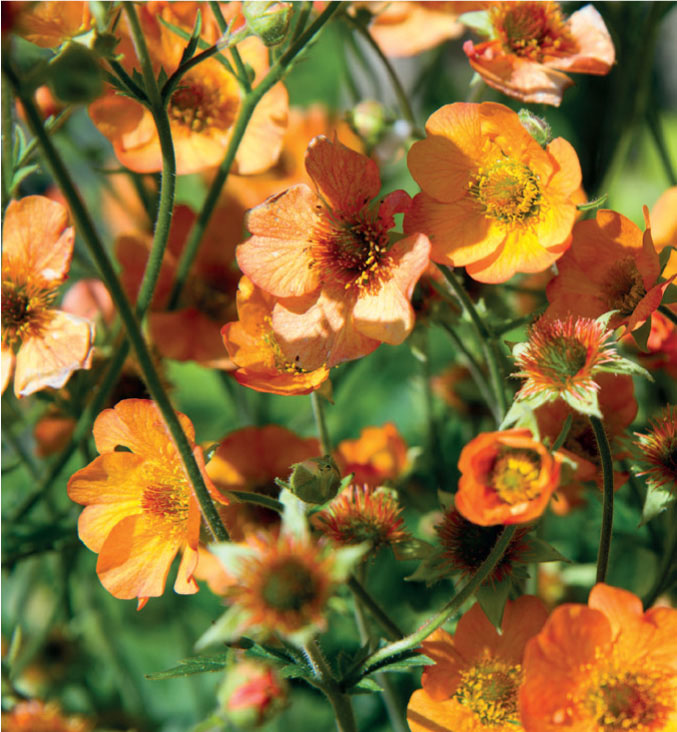
* Globe thistles Echinops
An eye-catching part of the herbaceous border and one of the very best plants for bumblebees, the spiky spherical flower heads the size of tennis balls are carried from midsummer to early autumn on 2m stems. Most are perennials native to southern Europe. Popular in gardens are E. ritro, to 1.2m, with lilac-blue flower heads, and the similar E. bannaticus ‘Taplow Blue’, both of which are also visited by butterflies such as Commas. E. sphaerocephalus is native to southern Russia with whitish flowers. All have thistle-like foliage.

Goat’s Rue Galega officinalis
Honeybees and bumblebees love this rather rambling hardy perennial, which grows to 1.5m and is native to central and southern Europe but is hardy further north. The white, pink and lilac pea flowers are borne in profusion June–August. It prefers sunny grassy places, and will do perfectly well on poor soil.
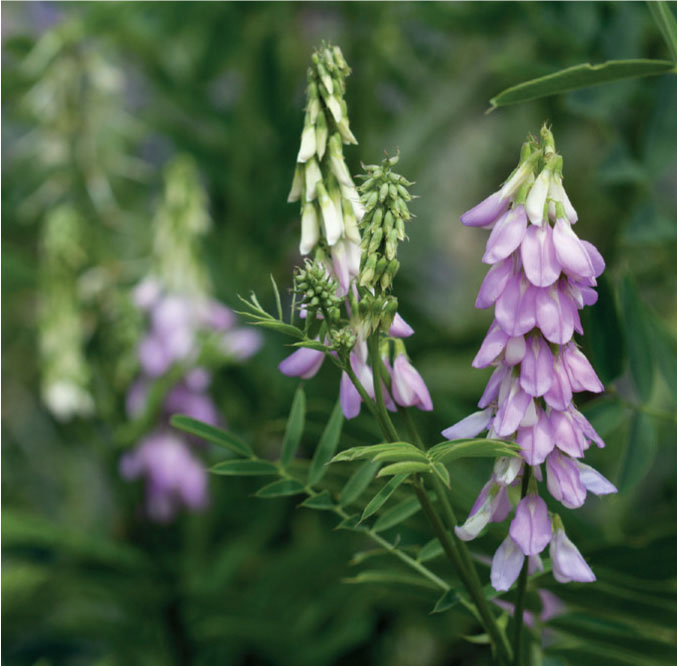
Ground-ivy Glechoma hederacea
Sprawling, furry perennial native to most of the British Isles on sunny road verges, hedgerows and open waste ground. Its purple flowers in April–June, on stems up to 20cm tall but often held close to the ground, are loved by bees, bee-flies and spring butterflies such as Small Tortoiseshell and Peacock, while the small kidney-shaped leaves are often used by gall wasps.
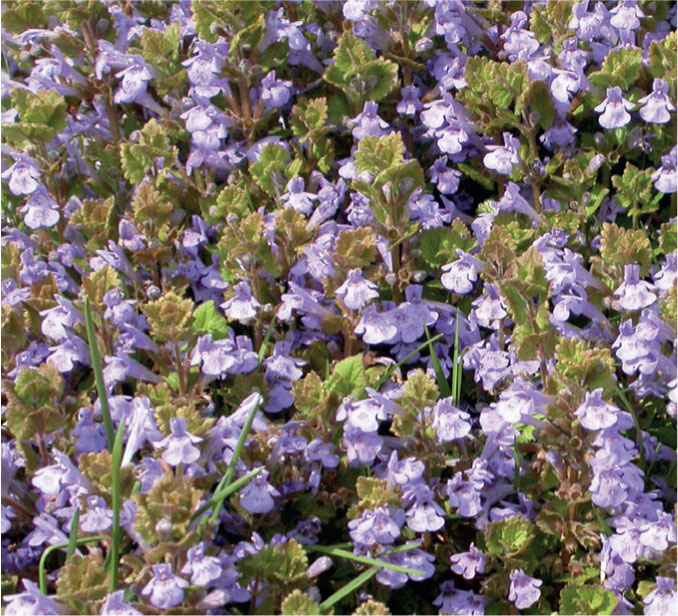
Hellebores Helleborus
The late-winter flowering season of several of these perennials offers early nectar for queen bumblebees. The multiple stems, up to 60cm, have simple, five-petalled, large nodding flower cups in whites, greens, pinks and even blacks, with a central cluster of big yellow stamens. Two types in particular stand out for the garden – Christmas Rose H. niger, native to central Europe, and Lenten Rose H. orientalis, native to the Black Sea area. But don’t discount the more subtle charms of green-flowered Green Hellebore H. viridis or the red-rimmed green bells of Stinking Hellebore H. foetidus, not quite as showy but both native to parts of south-western England and Wales and still enjoyed by bumblebees. All are great for the spring woodland garden in rich soil.
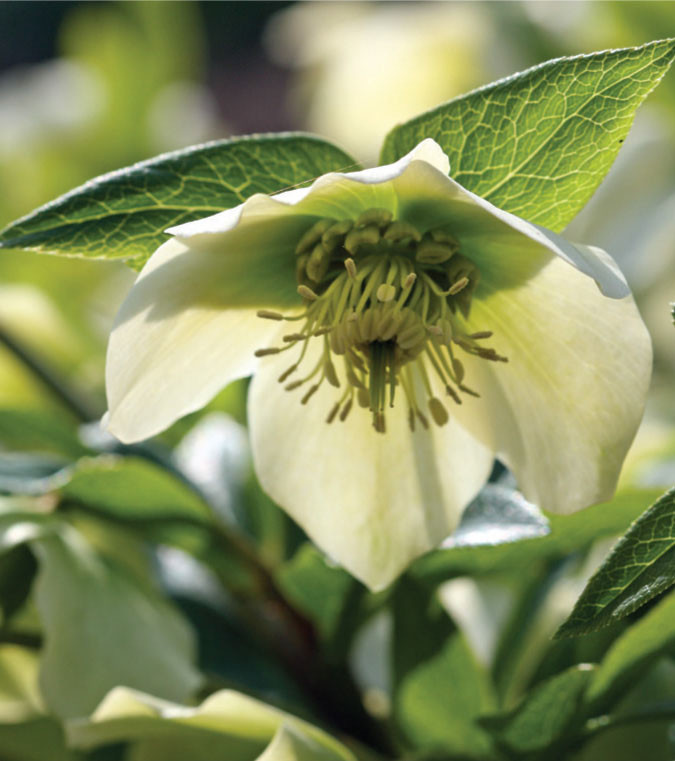
* Hemp-agrimonies Eupatorium
Top plants for butterflies, bees and hoverflies, our own Hemp-agrimony E. cannabinum, native throughout much of the British Isles although rare in Scotland, is a brilliant place to start. See here for the butterflies that visit its pale pink froth of flowers in July–September. It grows to 1.5m, spreading and setting seed readily, preferring damper soils and doing fine in light shade. Avoid the double-flowered variety found in garden centres. The American Joe Pye Weed E. purpureum (below) (now renamed Eutrochium purpureum) grows even taller, to 2m (subspecies maculatum is a little smaller), and has red stalks and flowers that are flushed deep pink. It is just as good for butterflies, and is best placed at the back of the border where it needs a good moisture-retentive soil.
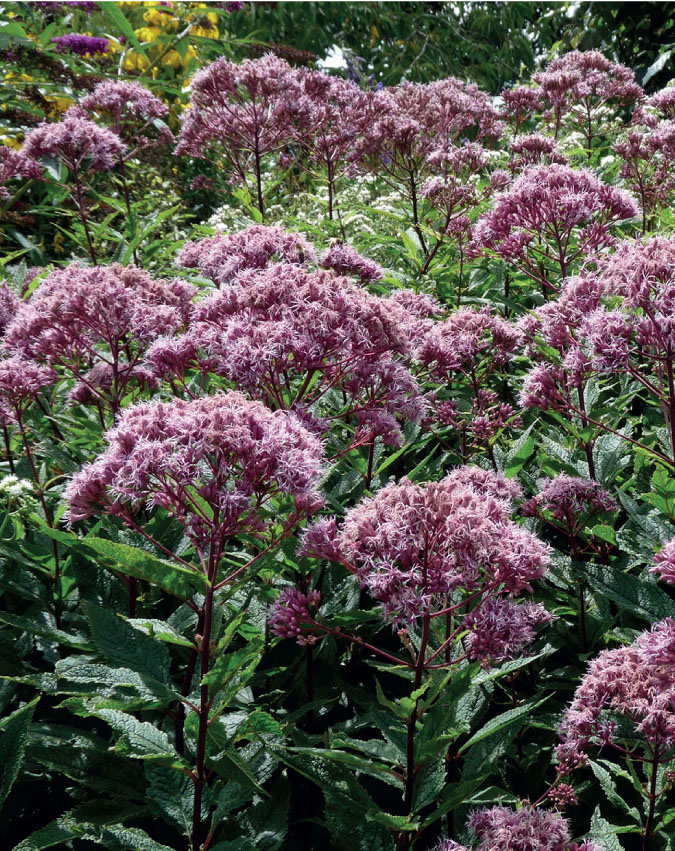
Hollyhock Alcea rosea
Originally from Asia, this dramatic plant, usually grown as a biennial, has large-petalled open flowers that bloom in sequence up the 2m stem. The flowers are pink in the original species and purple, maroon, white or yellow in cultivars. Inside, bumblebees wallow in yellow pollen, while caterpillars of the Mallow moth eat the large-lobed leaves. Avoid the doubles, grow in a moist but well-drained soil, and stake if necessary.

Honesty Lunaria annua
This easy-to-grow biennial, native to southern Europe, has heart-shaped leaves and delightful spring flowers in purple, magenta or white on stems up to 75cm tall, followed by disc-like translucent seed pods much used in flower arranging. The jury is out as to quite how good they are for wildlife, but Orange-tip and Green-veined White butterflies will certainly nectar and lay eggs there. It enjoys half-shade on moist but well-drained soils, and will self-seed.
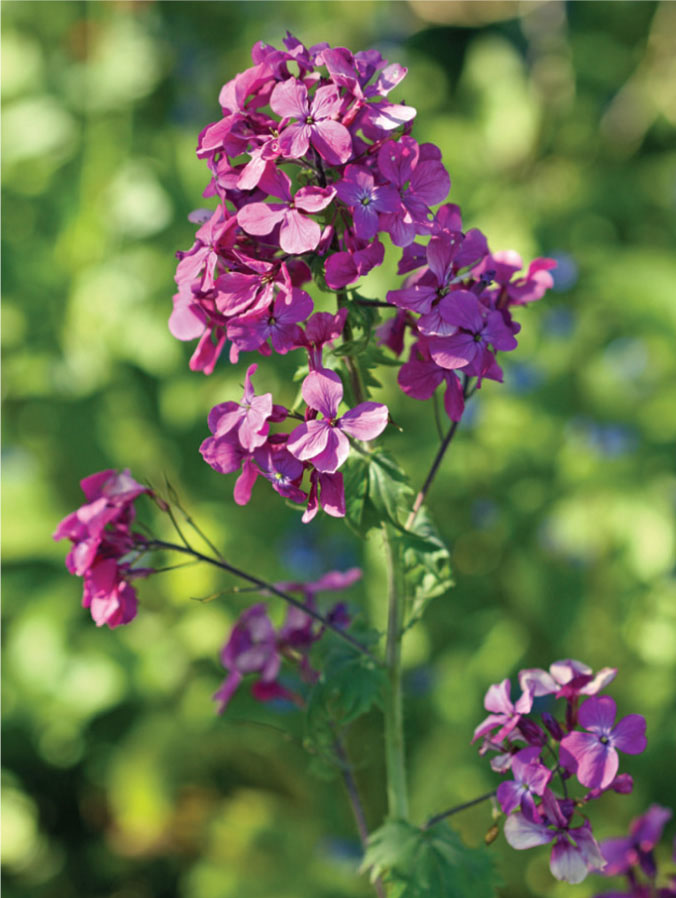
Honeywort Cerinthe major
Hardy annual or biennial native to southern Europe, its triangular, fleshy, bluish leaves topped with nodding plum-coloured flowers are much visited by bees, especially long-tongued bumblebees. Easily grown from seed, it needs a light, well-drained, fertile soil, preferably in sun. Deadhead to prolong flowering.
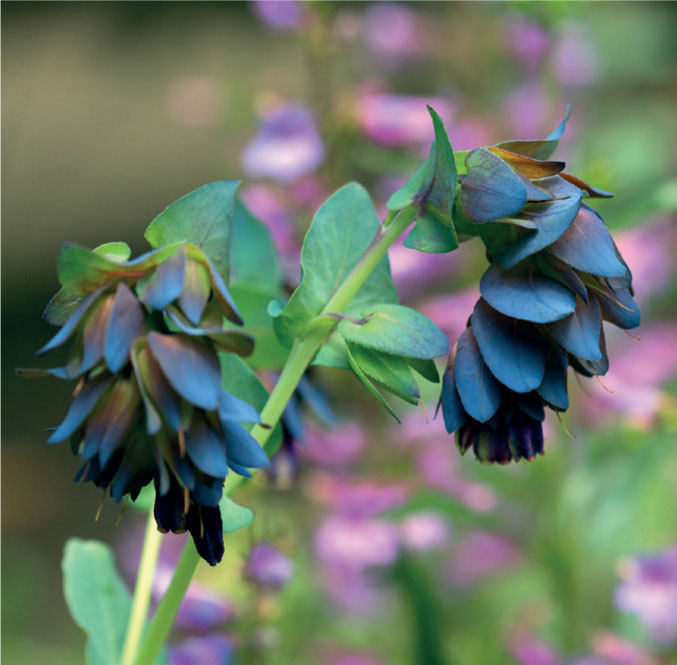
* Iceplants Sedum
Sedum spectabile stands out as one of the very best flowers for autumn garden butterflies. A hardy perennial native to eastern Asia, best grown on poor soils in full sun. It forms an evergreen clump of fleshy blue-green leaves above which the flower stems grow up to 60cm and open into flat-topped, massed clusters of hundreds of tiny pink stars. This is a feeding table in late summer and autumn for some of our showiest butterflies (see here), but make sure you grow several plants together for best results. Bumblebees and Honeybees love it too. Cultivars include white-flowered ‘Iceberg’, pink ‘Brilliant’ and deep-pink ‘Indian Chief’. You might also like to try Orpine S. telephium, probably native to many parts of the British Isles on woodland edges, but widely grown in gardens, too, where it works well for bees. Its plum-coloured cultivar ‘Matrona’ looks great in a border. The ubiquitous hybrid S. spectabile x telephium (above), marketed as S. ‘Herbstfreude’ or ‘Autumn Joy’, is sold everywhere as being good for butterflies but isn’t; it is fine for Honeybees but otherwise can be quite a disappointment.

* Inulas Inula
Tall perennials, most from eastern Europe and Asia, forming clumps of big broad leaves with tall flower stems topped with broad yellow daisy flowers. These are visited by several butterfly species, especially Peacocks, Commas, Red Admirals and Brimstones, but also whites and browns, and by bumblebees and Honeybees, and then by Goldfinches once the seeds have set. Elecampane I. helenium (above), from western Asia but now naturalised in Britain, grows to 2.5m with a flower up to 9cm across, and I. magnifica from the Caucasus is almost as big. As you can guess, they need plenty of space. Smaller gardens might suit I. hookeri from the Himalayas, only 75cm tall with flowers 3cm across. Inulas will tolerate some shade but they like rich, moist soil.

Jacob’s Ladder Polemonium caeruleum
A clump-forming hardy perennial, its fairly long leaves are divided neatly into opposite pairs of pointed leaflets. Multiple flower stems up to 90cm are topped with cup-shaped, mauve-blue flowers loved by Honeybees. In the British Isles it is native but only to steep limestone screes in the Pennines, whereas in gardens it grows best in fairly fertile soils. Several other species and cultivars are grown, including the similar Abscess Root P. reptans from the eastern USA and Boreal Jacob’s Ladder P. boreale from the High Arctic.

* Knapweeds and cornflowers Centaurea
A fantastic genus for bumblebees, bees, butterflies and birds, with flowers beautiful enough to be centre stage in the flower border. Common (Black) Knapweed C. nigra is native to the whole of the British Isles, Greater Knapweed C. scabiosa (above) to much of lowland England and Wales. Found in unimproved downland and meadows, they have stems up to about 80cm from which they bear pink-purple, thistle-like flowers on top of a firm, swollen head covered in bracts. See here for all the many butterfly visitors. The foliage is eaten by a whole host of leaf beetles, gall-flies and leaf-miner flies, and Goldfinches like the seeds. Grow them in poor soil as they may get too tall and floppy in a compost-rich border.
The cornflowers include the annual Cornflower C. cyanus, an archaeophyte that was once a problem weed of arable crops but is now rare in the wild. It has the purest of blue flowers, visited by Honeybees and hoverflies, and is ideal for your cornfield mix, but avoid the doubles. Just as good as the native species, at least for pollinators, are Perennial Cornflower C. montana, a native of the mountains of central Europe with large blue flowers, and Mealy Cornflower C. dealbata (below) from the Caucasus with pink flowers. For something different, try C. macrocephala, also from the Caucasus but with big yellow flowers, or for deep intense purples go for C. ‘Jordy’, a hybrid of C. montana and C. jacea but no less good for pollinators for that. Full sun and light soils suit most Centaureas.
If you are on clay, I’m a big fan of the closely related Saw-wort Serratula tinctoria, a rather slender plant that grows to 70cm with tight little knapweed flowers, loved by skippers and brown butterflies, and a delight in summer meadows. It is native to much of England and Wales, especially the south and west.


* Lady’s Smock (Cuckoo-flower) Cardamine pratensis
Delicately beautiful perennial that grows up to 60cm and is native throughout the British Isles and much of northern Europe in damp, even boggy, grassy places and ditches. It bears pale pink flowers of great simplicity, each with four petals, a sure sign of spring. It is essential as one of the two food plants of caterpillars of the Orange-tip butterfly, and is also used by those of the Green-veined White, and the adults of both species will nectar at the flowers in April–May. We need more gardeners to grow it.

* Lamb’s-ear Stachys byzantina (syn. S. lanata and S. olympica)
Growing to 50cm and native to the Caucasus, the little pink flowers of this clump-forming perennial are a big draw for various bees. However, its prime attraction is for the Wool Carder Bee, which harvests the soft, white hairs off the leaves to form its nesting chambers. It is fascinating to see one of these feisty bees determinedly guarding a clump, fending off intruders. Grow in a well-drained or even poor soil in a sunny position, and make sure you buy the flowering form rather than the non-flowering variety sold as ground cover.
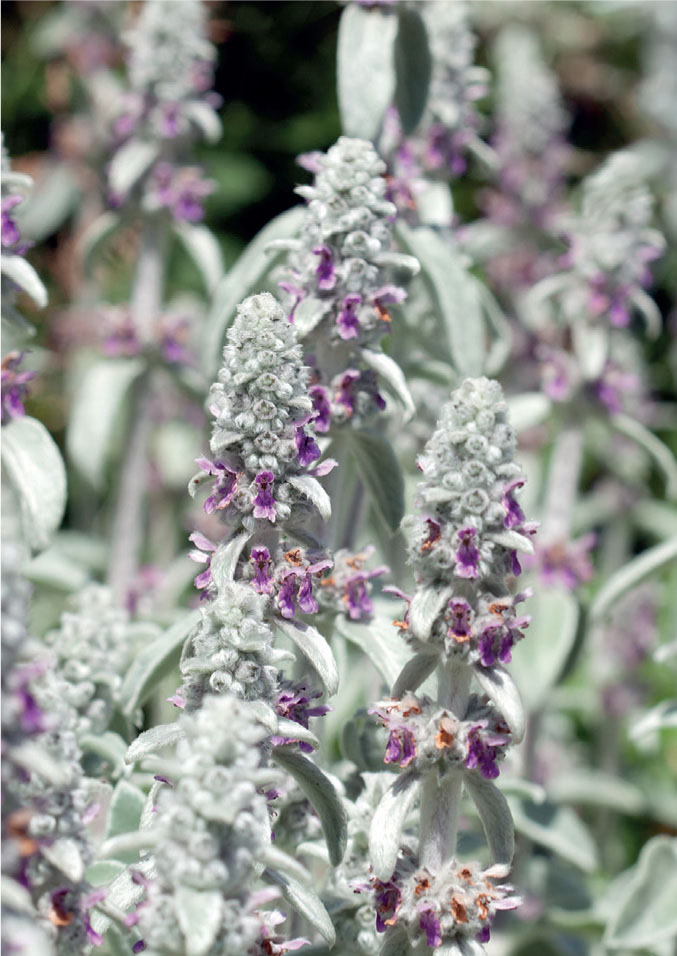
Larkspur Consolida ajacis
An annual, growing to 90cm (some cultivars are larger), native to the Mediterranean and a close relative of the delphiniums. It has finely cut leaves and tall stems lined with open flowers in purples, blues and pinks that are great for bees, especially bumblebees, and its foliage is food for the caterpillar of the Golden Plusia moth. Avoid all the widely available doubles and hunt down the simple singles. Grow in sun and a well-drained soil, maybe as part of an annual seed mix, but be prepared for major slug and snail damage. Taller cultivars may need support.

Lavatera, Annual See Mallows
Lithodora Lithodora diffusa
Perhaps best regarded as a sub-shrub, given that it is evergreen rather than herbaceous, but it barely reaches more than 15cm high as it creeps over rockeries and the front of borders. It hails from as close to Britain as France, although it never made it to the British Isles under its own steam. The most widely available cultivar is called ‘Heavenly Blue’, and the simple, star-like flowers are indeed of an intense blue and are wonderful for attracting all sorts of pollinators from late spring through much of the summer. You will need to grow it in acid soil with good drainage, and it does like sun.

* Lungworts Pulmonaria
I love these plants! On a springtime woodland garden floor, they form little clumps of white-spotted leaves, and hungry bumblebees, Honeybees and bee-flies thrust themselves deep into the throat of the blue tubular flowers. One species, the Narrow-leaved Lungwort P. longifolia, is native – if you live in parts of Dorset, Hampshire or the Isle of Wight, that is. Plain, simple Lungwort P. officinalis from Europe has been widely grown here for hundreds of years, and these days you can also buy P. angustifolia, P. rubra and P. saccharata (the latter with red flowers), plus lots of cultivars. All are perennials, up to about 20cm tall at most, enjoying partial shade and a loamy or clay soil.
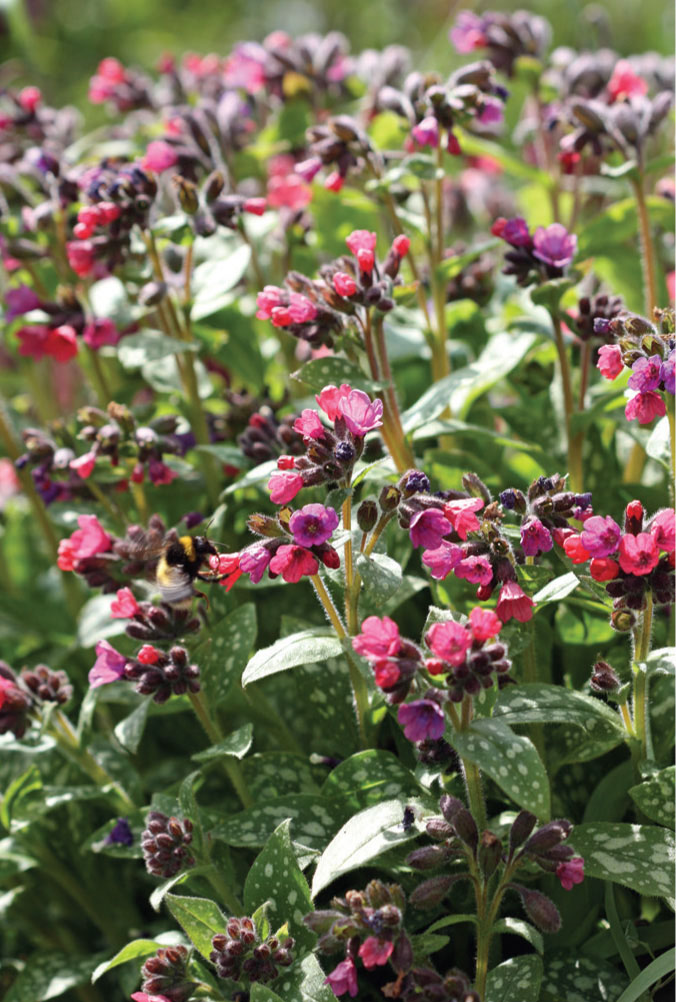
Lupins Lupinus
Dramatic, short-lived perennials, mainly available to buy as Russell lupins, which are a group of hybrid cultivars based on the North American species L. polyphyllus and the shrubby Tree Lupin L. arboreus. Even the hybrids tend to be good for bumblebees, Honeybees and mining bees, with their showy 1m high spires of carefully and densely arranged pea flowers in whites, yellows, pinks, reds and purples. Most are hardy but are prone to slug and snail onslaught. Grow in full sun in a fairly fertile soil, either sowing from seed in autumn or taking cuttings in spring. Just be aware that some lupins can be invasive, including Tree Lupin which is causing problems in some coastal sites, so compost all spent plants at home.
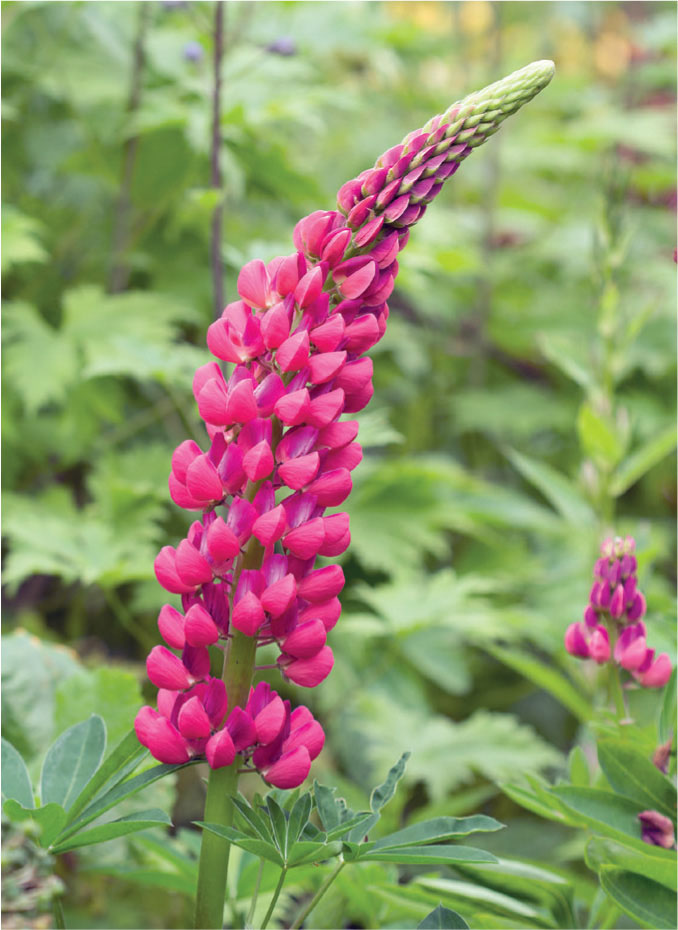
Lysimachia Lysimachia clethroides
Although there is an English name of Gooseneck Loosestrife, it is rarely marketed as such, so I’m sticking to the scientific name. It is a herbaceous perennial native to China and Japan, which produces heads of white flowers in a spike up to 1m tall, which in form are rather like those of buddleja but the tips habitually nod. It should quickly form a clump, and with dozens of nodding flower heads lined up, you can see the resemblance to a flock of farmyard geese. Given a sunny position, I think it is much undervalued as a nectar plant for butterflies, and it isn’t bad for bumblebees either.

Mallows and lavateras Malva and Lavatera
Two closely related genera of mainly perennials with large open pink flowers, often with notched petals, that look pleasant in the herbaceous border. All are visited by some bumblebees and Honeybees. Musk Mallow M. moschata is my favourite, a native beauty to almost all of England and Wales growing to about 80cm. It has fine-cut leaves and pale pink summer flowers, with an exquisite white version ‘Alba’. It likes sheltered edges with a bit of shade but will do fine in the open. Common Mallow M. sylvestris is a bit of a straggler with stems up to 1m, and is hit-and-miss with pollinators, but its deep-pink summer flowers are beautiful. It is the food plant of the Mallow moth, and there are some well-behaved cultivars to try. It is an archaeophyte across almost all lowland areas of the British Isles except the far north.
Bees seem to prefer the warmth-loving lavateras (above), sometimes called the ‘shrubby mallows’. We do have a couple of native species in the British Isles, but it is hybrid cultivars that are most widely grown, rising to 1.5m at times yet rarely needing support. There is also the lush annual L. trimestris from the Mediterranean. Mallows and lavateras like a well-drained soil and can cope with a little shade; most will self-seed.

Marigolds Tagetes
Widely grown in gardens, French Marigolds T. patula and African Marigolds T. erecta, both native to Mexico (work that one out!), have a neat mound of foliage and many daisy-like flowers with orange or yellow rays around the outside and a mass of tiny florets in the centre enjoyed by some pollinating insects, especially hoverflies and solitary bees. All are fast-growing half-hardy annuals and perfect for summer bedding, flowering in summer and usually 20–50cm tall, but you’ll need to search hard to avoid the double and pompon cultivars that are readily available but have had much of their goodness bred out of them. Good French Marigolds to seek include the single flowers of the ‘Disco’ series, ‘Naughty Marietta’ and ‘Cinnabar’, while African Marigolds include ‘Tangerine Gem’ and ‘Lemon Gem’. Grow them in a sunny position in a good, free-draining soil, or as companion plants to cabbages, cucumbers, potatoes and tomatoes.

Marigold, Corn Chrysanthemum segetum, syn. Glebionis segetum
One of the staples of the cornfield garden, long since present in the British Isles although not originally a native here. It’s very easy to grow, and the large, daisy flowers are a joyous deep golden yellow. The open flowers make fine feeding for some solitary bees and hoverflies.

Marigold, Pot Calendula officinalis
An easy-to-grow garden favourite, native to southern Europe and 30–60cm tall, depending on the cultivar. It is a hardy annual covered in lots of yellow or orange daisy flowers, which, if you avoid all the many double-flowered varieties and stick to the simplest varieties, will be visited by hoverflies and some solitary bees. Grow them in a sunny position in a well-drained soil, and you can easily extend the flowering season by deadheading.

* Marjorams Origanum
A must! Marjoram O. vulgare (above) is a perennial native growing to 50cm in dry grassy places throughout much of the lowland British Isles, although it is rare in Scotland. The clusters of small pink flowers open from deep red buds and are irresistible to Gatekeepers and many other butterflies (see here), but are also one of the very best bumblebee magnets. I have found the subspecies hirtum to be particularly effective (see photo). There are also several other species and cultivars to try, such as Sweet Marjoram O. majorana from the Mediterranean.
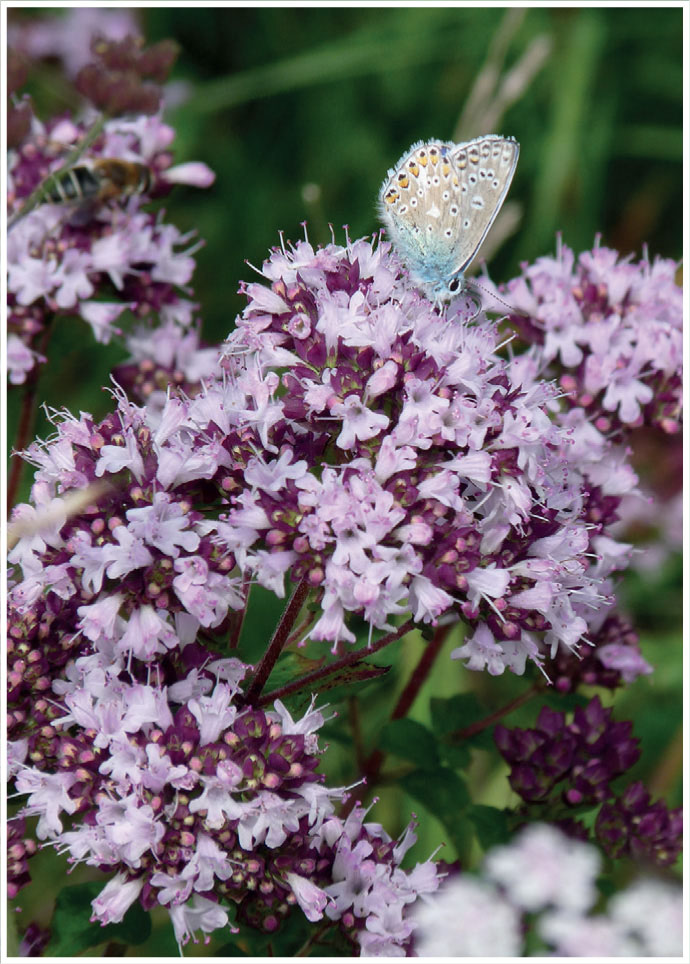
Masterwort Astrantia major
Hardy, clump-forming perennial, native to central and southern Europe, growing up to 60cm and great in the herbaceous border. Its little pincushion flowers in a ruff of white or pinkish papery bracts can be popular with Honeybees, bumblebees, flies, hoverflies and beetles, especially when grown in drifts. They flower from summer to autumn, the individual blooms on upright branched stems. The cultivar ‘Rubra’ is deep red, and there are several others to choose from. Grow in fairly fertile soil, preferably in sun.

* Meadowsweet Filipendula ulmaria
Native and still common throughout the British Isles on riverbanks and in fens, it is easy to dismiss this herbaceous perennial as not worthy of the garden, but if you have wilder, damper parts of the garden in full sun or light shade, it can make a dramatic show, heavy with scent. It quickly forms a clump, with long, strongly ridged, pinnate leaves. The flowers individually are tiny but combined in the large, irregular flower heads they form a creamy-white haze. After all the bee-friendly flowers in the list, it’s nice to recommend one that is great for flies (remember, many of your birds need flies!), and the plant itself is associated with a huge range of moth caterpillars, sawflies, bugs and beetles.
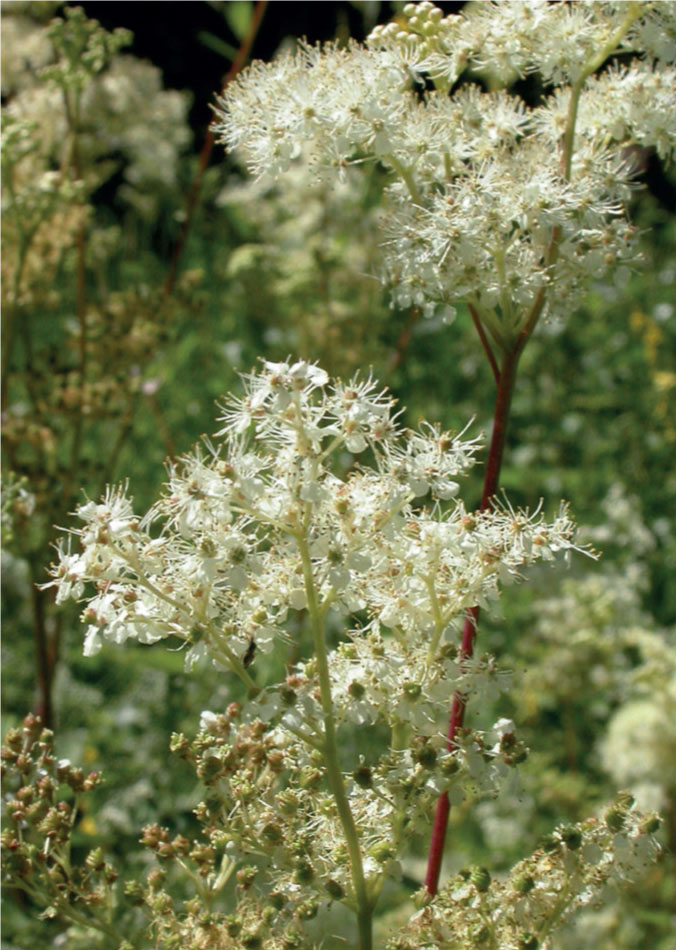
* Michaelmas Daisies Aster and Symphyotrichum
These flowers keep the memory of summer alive, with massed daisy flowers on tall stems, mainly in pinks and purples, that bloom from September onwards. The best of them prove irresistible to autumn butterflies (see here), while Honeybees and hoverflies also visit some varieties in droves. Most are 80–120cm tall, sometimes needing some support. Key species, of which there are dozens of cultivars, are New York Aster S. novi-belgii and New England Aster S. novae-angliae from North America with big showy flowers, Heath Aster S. ericoides, another American studded with smaller leaves and smaller pastel flowers, and Blue Wood Aster S. cordifolium. They have only recently been reallocated into the Symphyotrichum genus, but feel free to still call them Asters – I do! However, choose your cultivars carefully. Research at the National Collection in Malvern showed that only a small proportion of the varieties available shine for pollinators, with A. novi-belgii ‘Alice Haslam’, ‘Alderman Vokes’ and ‘Dandy’ coming out top. As a general rule, definitely avoid those where the flowers are all petal and no ‘middle’.
A. amellus from Europe, especially ‘Grunder’, can be good for butterflies, and has been shown to be great for hoverflies, but I am yet to be convinced by its hybrid, A. x frikartii ‘Mönch’, which is popular because it starts flowering in July and is less prone to mildew than others.
Grow Michaelmas Daisies in a moisture-retaining soil in a sunny position, and divide in spring to propagate.
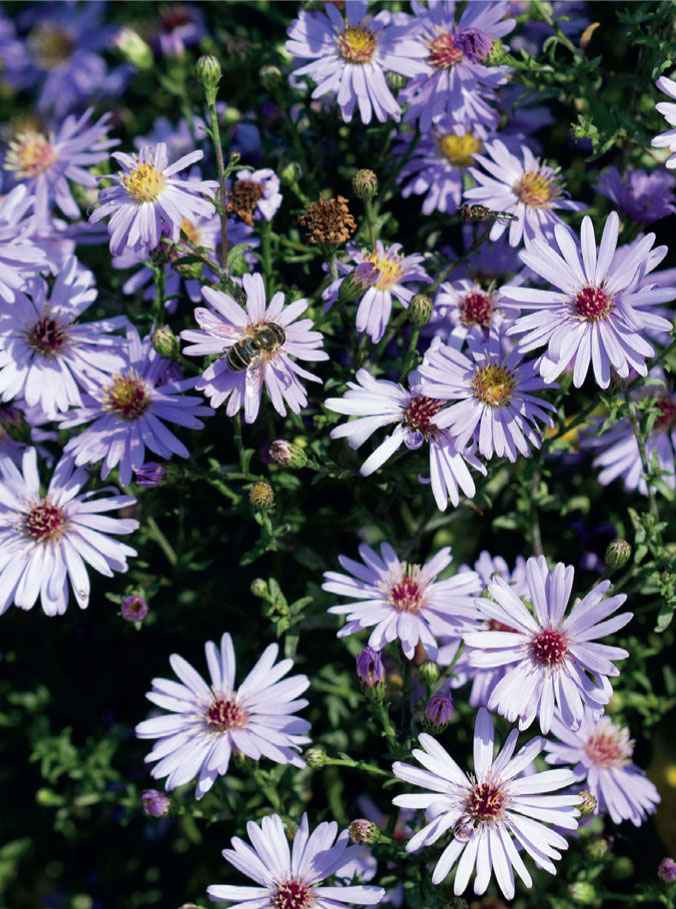
Mignonette Reseda lutea
Biennial or short-lived perennial native to much of England and some lowland areas of Wales and Scotland in rather sparse grassy areas and especially on alkaline soils. It has deeply cut leaves and multiple narrow spikes of lime-yellow flowers up to 75cm during June–September, visited by various bees including the yellow-faced (Hylaeus) solitary bees and by soldier beetles. It is rarely grown in gardens, despite the flowers making an attractive foil for gaudier blooms. Plant in a sunny position. Two alternatives from the Mediterranean include White Mignonette R. alba, similar but with white flowers, and the widely grown R. odorata with fragrant flowers.

Mints Mentha
Group of familiar aromatic perennials, most growing to 75cm, that have been much hybridised, with many having a bit of native British Water Mint somewhere in their ancestry. Varieties include the British archaeophyte Spearmint M. spicata, the widely grown Peppermint M. x piperita (M. aquatica x spicata) and Applemint M. suaveolens. They prefer rather moist habitats, with the small pink flowers borne in whorls up the stem or in terminal short spikes, visited by bees and some butterflies such as the whites. The ‘Buddleia’ group of cultivars of Horse Mint M. longifolia is said to be especially good, although more research would be welcome. Mints spread like the clappers so be prepared to contain them.

Monkshood Aconitum napellus
Native perennial to parts of south-western England and southern Wales, and naturalised in other parts of the British Isles. The summer flowers, in a spike up to 1.5m, have unusual purple-blue helmets visited by bees, especially long-tongued bumblebees. It enjoys rich soil in sunshine or the semi-shade of an open woodland, especially near water. There is also a beautiful white form. Be aware that the plant is highly poisonous.

Motherwort Leonurus cardiaca
The whorls of small pink flowers around the 1m stems reveal this to be in the Mint family. Native to south-eastern Europe, it was once grown in Britain as a herb. The leaves are rather like the shape of a duck’s foot, and it forms an interesting feature in a herbaceous border, where it can be very popular with a range of insects including bumblebees and hoverflies. It isn’t as invasive as the mints, and will do fine is a stony, poor soil, so is definitely one to consider.
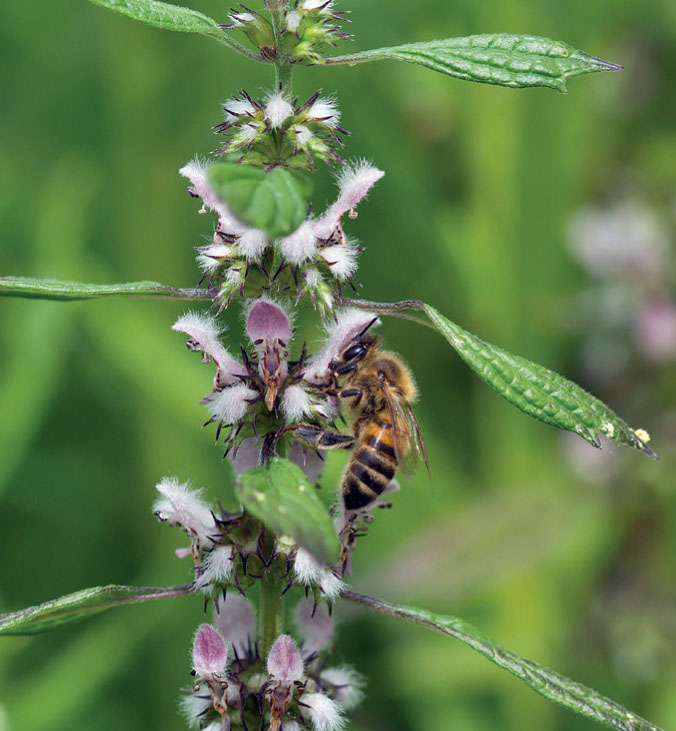
Mulleins Verbascum
The most prominent creature to use these dramatic plants is the Mullein moth, whose warning-coloured caterpillars feed openly on the large rosettes of leaves. Most mulleins produce a tall, slender flower spike studded with yellow or white flowers visited by hoverflies, solitary bees and bumblebees. The plants are also nibbled by various flea beetles and weevils. The biennial Great Mullein V. thapsus, up to 2m high, is a widespread native of lowland British Isles, with leaves like soft, pale-green felt. Similar garden plants, although more branched, are V. olympicum from Turkey and V. bombyciferum (below) from Asia. The perennial Dark Mullein V. nigrum is native to grassy places in central, southern and eastern England and has green spikes of purple-centred yellow flowers. V. chaixii from central Europe is just as effective for insects, and feel free to try some of the many hybrid cultivars. Grow mulleins in sunshine in a free-draining soil.
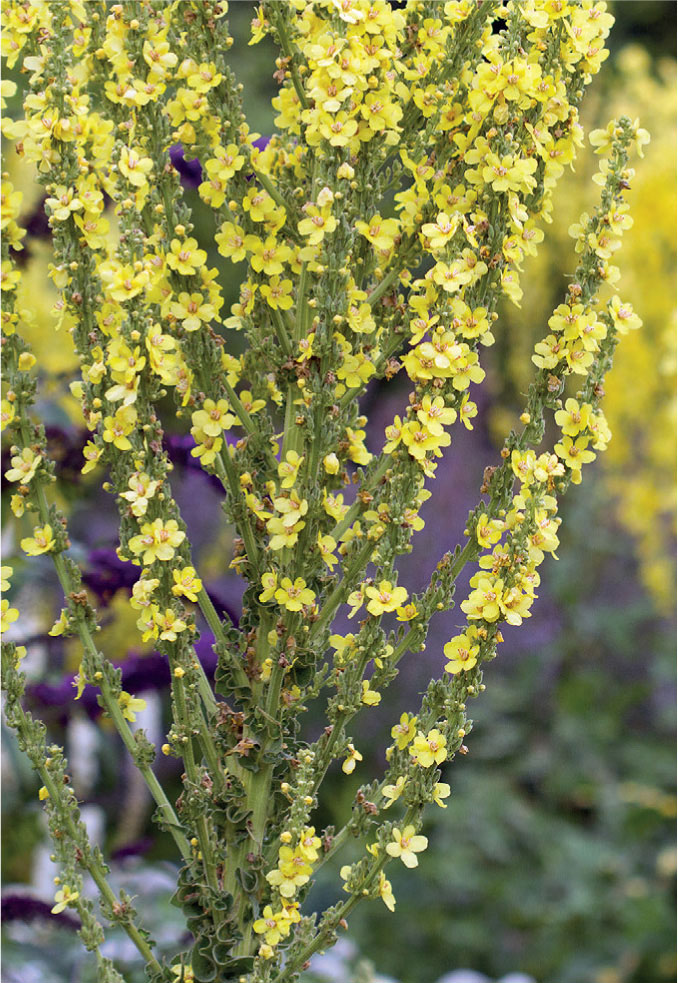
Nasturtiums Tropaeolum majus
It is absolutely pot-luck, it seems, whether any pollinators will find your nasturtiums – sometimes the bumblebees seem to go a bundle on them, sometimes the flowers remain resolutely empty. However, I include them more as a great plant to grow with kids, for these annuals, originally from Central America but now in a range of cultivars, grow incredibly quickly, clambering and in some cases climbing, and soon bearing lots of gaudy red and yellow flowers. On the rounded leaves, Large and Small White butterflies lay their eggs, and they make a great place for studying a butterfly’s life cycle, up close and without ruining your cabbages!

Pachysandra terminalis
From Japan, an evergreen perennial (some might consider it a sub-shrub) that is useful in the garden because it will grow in dense shade and, indeed, doesn’t like too much sunlight. It grows by sending out runners, from which grow neat, 25cm high stems with whorls of leaves topped by insignificant clusters of spring flowers. However, these are sweet and rich in nectar, and in a woodland setting before the canopy closes, they can be a good food source for spring butterflies and bee-flies.

Pansies and Violets Viola
Most people love the simple, colourful flowers of this big family of low-growing plants, several of which are native to the British Isles. Wildlife doesn’t flock to them in gardens, but Honeybees, bee-flies and smaller bumblebees will sometimes visit, and some violets form excellent ground cover in the woodland garden. Avoid the rather coarse and insect-free garden varieties and stick to the ‘small is beautiful’ native species. Sweet Violet V. odorata is a perennial of lightly shady places throughout lowland England and Wales and parts of Ireland; the violet, pink or white flowers are indeed sweet-smelling, and it spreads well. Common Dog Violet V. riviniana is a native perennial to almost the entire British Isles, mainly in woods; the small lilac flowers have a pale yellow spur at the back. Wild Pansy or Heartsease V. tricolor (above), with exquisite purple and yellow flowers, grows on acid soils often in the mountains and sometimes persisting as a perennial. And Field Pansy V. arvensis is an annual for the cornfield garden. Sadly, Garden Pansies, which are complex hybrids, rarely seem to deliver any wildlife value whatsoever and are another of those garden plants that might as well be plastic.

Parsnip, Wild Pastinaca sativa
The smaller bees and hoverflies do need rather different flowers than the heftier, longer-tongued bumblebees, and that often means members of the carrot family. However, something as widespread as Cow Parsley rarely seems to deliver, and in the absence of robust studies into non-native members of the family sold by flower catalogues, I think it is well worth considering Wild Parsnip, a native biennial of English and Welsh verges and grasslands on chalky soils. It does have rather a pungent smell, but I think the pinnate leaves look good and while the umbels of flowers aren’t dramatic, the yellowy hue is quite unusual and they can come alive with all sorts of insects, from flies to true bugs, that you just don’t see on other flowers.
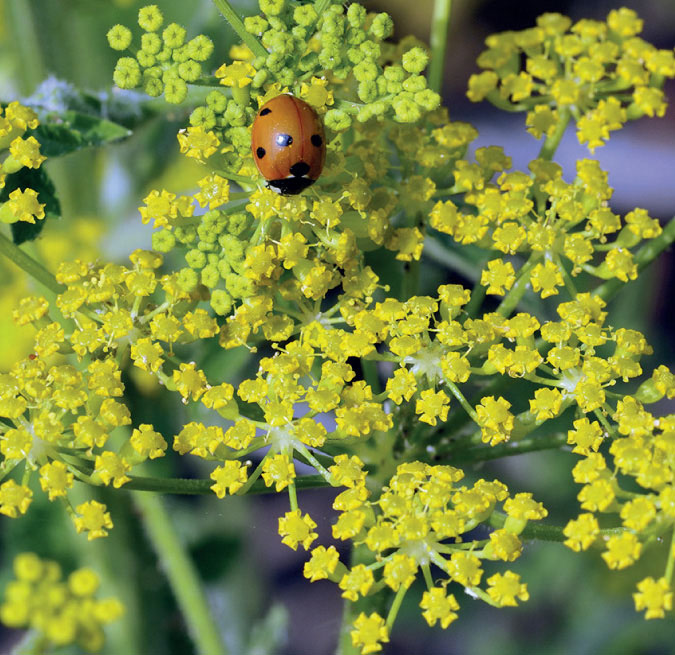
Penstemons Penstemon
From North America, this fairly large group of species is related to the foxgloves and has smaller, more numerous, trumpet flowers on an upright stem, often in blues and purples, into which bumblebees readily crawl. Some bumblebees also learn to pierce the base of the bell from the outside to get at the nectaries – so-called nectar-robbing. Cultivars of the species P. heterophyllus are especially good, but you’re more likely to find hybrid cultivars for sale, which are hardier. Rock-garden varieties grow to about 20cm and herbaceous ones, which may need staking, up to 1.2m. They like full sun or light shade and a moist, well-drained soil.

Peonies Paeonia (singles)
For a long time I saw no value in this group of herbaceous flowers until I realised how good some of the single-flowered varieties could be for a wide range of bees, which appear to be drawn in for the pollen. They only flower for a short time in the summer, and need to be in fertile deep soil and out of the blazing afternoon sun, but for the size and beauty of the bloom and as something for the bees away from the main sunny borders, they will be much admired.

Phlomis
Evergreen perennials with whorls of simple, heart-shaped leaves growing at intervals up the 1m stems which cup the hooded flowers, yellow in the case of P. russeliana (above) and lilac-pink in P. italica. Long-tongued bumblebees visit for nectar, but added value is the chance of finches taking the seed, plus the seed heads are very attractive indeed so you’ll be happy to leave then standing over winter, providing a sanctuary for various insects.

Phlox, Perennial Phlox paniculata
There are over 100 cultivars of this North American herbaceous perennial, with simple, five-petalled pink, purple and white flowers. Plants quickly develop into a clump, and even though the flower stems can be 1m or more tall, they rarely need staking. The flowers hide a deep tube down to the nectar, so this is a plant either for butterflies, especially the Brimstone, or for hawkmoths including the Hummingbird Hawkmoth. The foliage can be prone to mildew, and you are best to plant it in deep rich soil that holds moisture well, especially if well mulched.

Poached-egg Plant Limnanthes douglasii
Very easy to grow, a hardy annual, native to north-western USA, its flowers having yellow centres (the ‘yolk’) and white tips. Sow it in March directly into prepared ground where you want it to flower or in pots, ideally in a sunny position. It will grow quickly and is good for solitary bees and Honeybees, flowering in June–August. It will self-seed.

Poppies Papaver
Much loved and deeply symbolic, most poppies also provide a good source of pollen as well as a little nectar for Honeybees and bumblebees, although there is little other insect life associated with them. Birds such as Goldfinches take the copious seeds. The red poppies we see in cornfields are several different species, the commonest being Common Poppy P. rhoeas (above) and Long-headed Poppy P. dubium. Both are annuals, growing to about 60cm, and are archaeophytes in most lowland areas of the British Isles. There are some cultivars of Common Poppy – the so-called ‘Shirley Poppies’ – which can be just as good, but avoid the doubles. Opium Poppy P. somniferum (above), despite looking so exotic, is also an archaeophyte, again widespread and annual, growing to 120cm; its large lilac flowers have a purple blush at the centre. Again, avoid the blousy doubles and ‘peony-flowered’ cultivars. You can also try Oriental Poppy P. orientale, an Asian perennial, with its vermilion papery petals. All these poppies prefer sunny positions in rather dry cultivated ground. For shadier areas, you can’t go wrong with the yellow Welsh Poppy Meconopsis cambrica, native to western areas of the UK, which should self-seed freely.


Primroses Primula vulgaris
There are lots of garden primulas but, for wildlife, stick to evergreen Primrose P. vulgaris (above) and avoid the useless hybrid primulas and polyanthus. Native almost everywhere in the British Isles, its foliage is eaten by caterpillars of dozens of moth species, especially the various species of yellow underwing and the Xestia genus including Setaceous Hebrew Character. The beautiful lemon flowers are also visited by bee-flies, although be aware that it is not a flower that buzzes with insect activity.

Rattle, Yellow Rhinanthus minor
As well as being the crucial ingredient in the summer wildflower meadow because of its ability to suppress vigorous plants like grasses (see here), this is a plant that has the added benefit of being enjoyed by bumblebees. It is a short annual, usually 20–30cm tall, with yellow, hooded flowers. If you live near to large meadows full of Rattle, you may be visited by the Grass Rivulet moth whose caterpillars feed on the ripening seeds in their inflated dry pods. Sow in autumn.
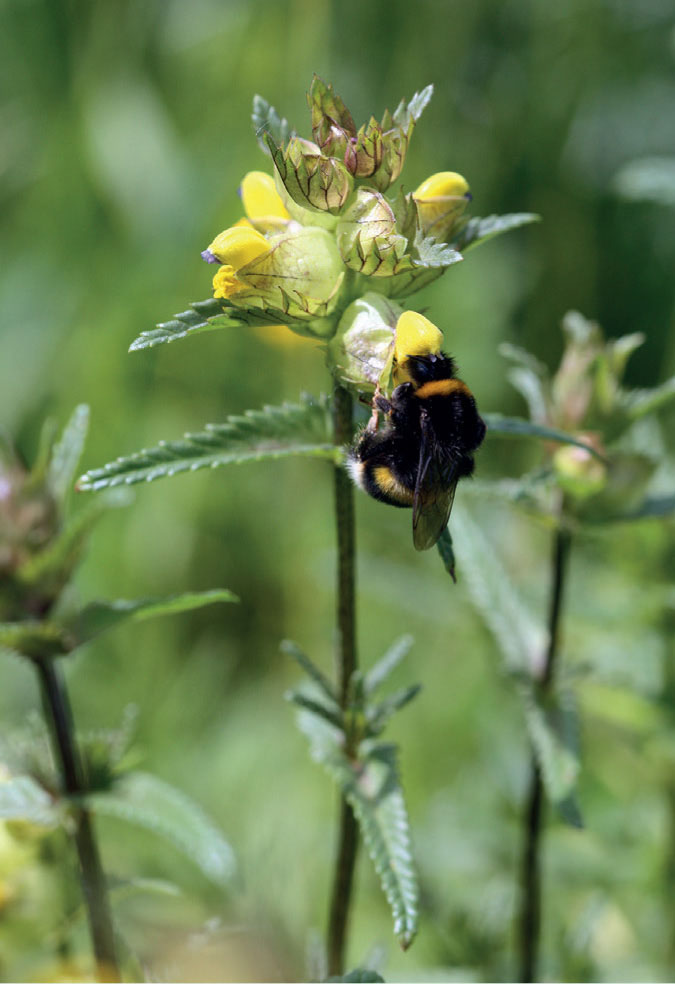
Red-hot Pokers Kniphofia
Attention-grabbing perennials from southern Africa with dense heads of red or yellow flowers in June–September on a 1m stem above a rosette of spiky foliage. House Sparrows, Blue Tits and Great Spotted Woodpeckers have learnt to visit them for nectar, getting their heads covered with pollen in the process. Some are great for Honeybees and bumblebees, and are also enjoyed by wasps, while the clump of evergreen leaves provides a winter refuge for ladybirds and other beetles. The many species and hybrid cultivars like a sunny position in moist, well-drained soil, and do well in coastal gardens.

Rudbeckia
I’ve stuck with the Latin name for this herbaceous perennial as the sometimes used English name, Black-eyed Susan, is also used for the climbing plant Thunbergia. It is really easy to grow and soon clumps up into a tall swathe of large deep yellow daisies, ideal for the prairie garden, with a domed black disc of florets at the heart of each flower. Two key species to try are R. fulgida (including the cultivar ‘Goldsturm’ (above)) and R. hirta, both of which are moderately attractive to some butterflies and bees, but I include them as much for the seed heads, which if you’re lucky will be found by flocks of Goldfinches.

* Sages and claries Salvia
One of the very best groups of plants for bees, with a whole host of native and foreign species and cultivars, and all good looking, too. Most are clump-forming perennials, with spikes of flowers somewhere on the purple spectrum, each tubular flower having a tall hood and a large landing pad. For a native beauty, go for Meadow Clary S. pratensis, a very rare plant in the wild in Britain, with 1m stems of vibrant deep-blue flowers. A good filler for borders is Balkan Clary S. nemorosa and a whole host of hybrids based on it, often under the names S. x sylvestris and S. x superba (above), whose spikes packed with deep-purple flowers are great for bees. Whorled Clary S. verticillata and its cultivars are also good for bees, while the herb Sage S. officinalis forms a low evergreen bush, but still sporting good spikes of bee-friendly flowers. Most salvias need full sun and a well-drained soil, but Bog Sage S. uliginosa from South America likes a moist soil where it will grow to 2m tall and delight bumblebees that visit the large sea-blue flowers. Even some of the heavily cultivated Salvias, such as S. x jamensis ‘Hot Lips’ can, on occasion, be good for pollinators, but the bedding cultivars of S. splendens tend to be lifeless.

Sainfoin Onobrychis viciifolia
A perennial in the pea family, with pleasing diamond-shaped heads of pink pea flowers above rows of paired leaflets. It is possibly native to southern England chalklands as a dwarf form and was then developed as a fodder crop; it is now most regularly seen on road verges. It produces nectar and pollen, a bounty for large pollinating insects, especially bumblebees, which can open the flowers with their weight. It is also a food plant of the Narrow-bordered Five-spot Burnet moth.

* Scabiouses Scabiosa/Knautia/Succisa
Three closely related genera of mainly perennial plants, simply brilliant for nectaring butterflies (see here), burnet moths, bees and other pollinating insects, and for finches that feed on the seeds. My garden wouldn’t feel complete without them! Most have lilac ‘pincushion’ flowers held on slender wiry stems. Field Scabious K. arvensis is native to most lowland areas of the British Isles although rare in Scotland, growing to 1m tall in unimproved sunny grasslands. It flowers July–October if deadheaded regularly. Small Scabious Scabiosa columbaria is like a petite version, native to chalk and limestone soils in England, and has a pale yellow version, S. c. var. ochroleuca. Devil’s-bit Scabious Succisa pratensis has smaller, deeper-coloured pompons in autumn (great as late nectar for butterflies), and is native throughout almost the entire British Isles. All will look fine dotted among other perennials. If you want something from further afield, Sweet Scabious Scabiosa atropurpurea from southern Europe is much like Small Scabious but with deep crimson flowers. It is often grown as an annual; avoid the widespread doubles. Knautia macedonica (above) from central Europe grows to 75cm and has scarlet flowers. Give all Scabiouses a well-drained soil, preferably alkaline.

* Scabious, Giant Cephalaria gigantea
I’ve kept this separate from the other Scabiouses as it is in a different genus and you’ll need to site it carefully as it does grow over 2m tall! It can be blooming marvellous for bumblebees; in fact, at times they cluster on the pompon cream flower heads as if deliriously happy. It is a perennial from the Caucasus and, as you can imagine from the height and the 1m spread of the large clump of basal leaves, this does need a bit of space at the back of the border.

* Scorpion Weed Phacelia tanacetifolia
Sometimes called Fiddleneck, this is a stand-out plant for pollinators and is easy and cheap to grow. An annual grown from seed, it is a little straggly with fine-cut leaves and coiled heads of lavender flowers that unfurl over a long season. Bees and hoverflies of many species visit large patches of Scorpion Weed in their droves, such as when it is planted as a green manure crop and allowed to flower. You can sow Scorpion Weed in spring or autumn, and it will freely seed.

* Sea-hollies Eryngium
Several species of spiky-leaved perennials, most with a dense cone of blue-tinged flowers borne from mid to late summer in the middle of ruffs of thorny bracts. Sea-holly Eryngium maritimum is native to shingle beaches and dunes in the southern half of the British Isles and grows to 60cm. Common garden plants in the family include: E. giganteum (above) from the Caucasus, which reaches 1.5m, including the dramatic silvery cultivar ‘Miss Willmott’s Ghost’; E. planum from central Europe, the least spiny of the bunch; and E. bourgatii from the Pyrenees, growing to 40cm with blue flowers. They’re brilliant for adding texture to borders, and the flowers are well visited by bumblebees, solitary bees, Honeybees and some butterflies such as Gatekeepers. For something more unusual, try Agave-leaved Sea-holly E. agavifolium from Argentina and Rattlesnake Master E. yuccifolium from America, both with fierce leaves and with smaller, green, spiky flower heads on branched flower stems up to 1.8m, adored by soldier beetles and many other pollinating insects. Give all sea-hollies a free-draining soil in full sun, and they even cope well with drought.

Snapdragon Antirrhinum majus
From south-western Europe, the original species has been turned into a mass of cultivars grown as half-hardy annuals in bedding schemes everywhere. Most have been tweaked too far and lost their wildlife value, but those that have retained their worth provide us with the entertainment of watching as bumblebees fly onto the ‘landing pad’ at the mouth of the flower, their weight opening the dragon’s mouth so that they can reach the nectar. Low-growing varieties for small gardens include ‘Floral Carpet’, barely 25cm tall, but some cultivars retain more of the character of the wild species and grow up to 1.5m tall; look out for those growing semi-wild on walls and collect the seeds! Avoid the doubles, go for old varieties, and grow them on a hot sunny site, deadheading through the season.
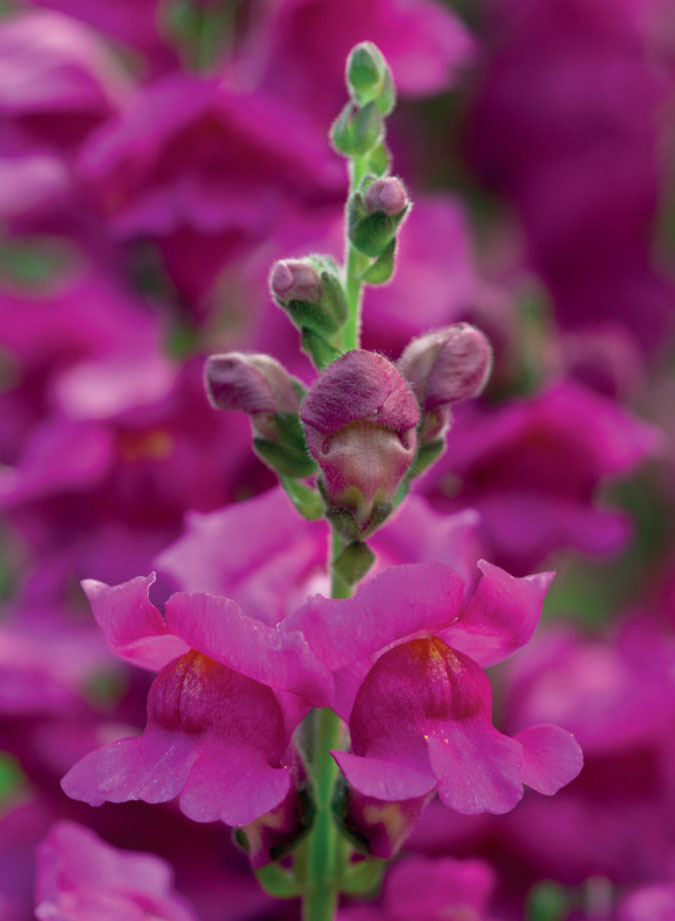
Sneezeweeds Helenium
Wonderful clump-forming perennials that will add a blaze of colour to any flower bed. Native to North America, they were once used by native Indians to make snuff, hence the name. The species H. autumnale grows to 1.5m, with lovely, sunshine-coloured, large daisy flowers, the central florets in raised cones that are visited by all sorts of bees, often in excellent numbers. However, you are far more likely to be able to get hold of the many hybrid cultivars, which tend to be shorter with orange or red petals or cones – try something like ‘Sahin’s Early Flowerer’ or the old variety ‘Moerheim Beauty’.

Speedwells Veronica
Large genus of flowers including some very attractive native species. In the British Isles, most wild speedwells are low-growing weeds, often annual, but the rare Spiked Speedwell V. spicata (above) is a perennial native to parts of East Anglia and forms clumps of foliage topped with 60cm high spikes of bright blue flowers. It has several garden cultivars in reds, pinks and whites. V. longifolia, native to mainland Europe, is similar but even taller, again with cultivars. For sheer native charm, the Germander Speedwell V. chamaedrys may have small flowers but they are the most intense blue and produced in profusion, and it creates a wonderful mat of ground cover in semi-shady spots and hedgebanks.

Spurges Euphorbia
A huge genus of plants, with some 450 species or more worldwide including many cactus-like succulents. However, here in the British Isles we’re much more familiar with either those annual weeds of the vegetable patch such as Sun Spurge E. helioscopia, the native knee-high Wood Spurge E. amygdaloides found in ancient woodlands, or the range of non-native species available for herbaceous borders. The latter tend to get grown for their architectural feel, many having neat whorls of leaves above which the acid-green flowers are like a cluster of cups held above ruffs of green bracts. I won’t deny they are a bit hit-and-miss as far as pollinators go, but the best can be great, especially for solitary bees, flies, hoverflies and ants. The top choice I have found is E. cornigera (above) from the Himalayas, which is a beautiful perennial with white midribs to the leaves. Avoid the invasive E. amygdaloides var. robbiae, and just be careful of the poisonous sap of spurges when handling.

Statice Limonium sinuatum
A Mediterranean version of Sea Lavender, much grown in gardens as a half-hardy annual for flower arranging, and is ideally suited to dry free-draining soils. The winged stems, which grow up to 45cm, bear little white tubular flowers dotted among colourful purple bracts (or various other colours in cultivars), and are enjoyed by several butterfly species.

Stock, Night-scented Matthiola bicornis
In the cabbage family, this is a rather weedy-looking annual from Greece growing to only 30cm tall with narrow grass-like leaves. Its wildlife value is that its simple, four-petalled, pale pink flowers open at night, releasing a glorious scent that draws in night-feeding moths.

Stonecrops Sedum
Ground-hugging perennials forming bobbly carpets of bulbous little leaves in inhospitable places such as gravel, walls and cliffs. Their little starburst flowers, often densely packed, are good for bees of all sorts. Several species are used on ‘green roofs’; typical (and desirable) in the mix are Biting Stonecrop S. acre, native throughout much of the British Isles except the Scottish Highlands, with yellow-star flowers, and White Stonecrop S. album, possibly native to parts of Devon but at the very least an archaeophyte almost everywhere in lowland areas of the British Isles. One of the best I have seen for attracting insects is the yellow Kamchatka Stonecrop S. kamtschaticum (above), but try Spanish Stonecrop S. hispanicum and Reflexed Stonecrop S. reflexum too. See also Iceplant for larger Sedums.

Strawberry, Wild Fragaria vesca
A tiny version of the garden strawberry, this low-growing perennial with little, three-toothed leaflets spreads out through semi-shady glades by slender runners. It has small, open, white flowers which turn into strawberries barely a centimetre across. These fruits, while just a morsel for us, are greedily snapped up by Blackbirds, mice and Foxes. Many weevils and good numbers of generalist moths eat the foliage, and mining bees visit for nectar. Let this undemanding plant cover the ground in a woodland area – it is easy to weed out if necessary.

* Sunflowers Helianthus
Most of us at some stage must have grown a sunflower from seed – and I bet it was one of the giants! Any plant that grows almost as fast as Jack’s beanstalk is a great introduction to gardening for kids. The late summer flowers are much appreciated by bumblebees, and you may be able to harvest some home-grown birdseed from them, too. Originally from North America, some cultivars can reach 4m or more in a season, and all tend to have golden rays and a large disc of dark brown florets in the centre, sometimes to 30cm across. Avoid the doubles and the ‘chrysanthemum’ series, and try shorter varieties to avoid having to stake them, such as ‘Taiyo’ which only grows to 120cm.
Most are annuals, but if you fancy one that comes back year after year, try the perennial H. x laetiflorus ‘Lemon Queen’ (above), which grows as a spreading clump and bears large daisy-like flowers in the purest of yellows and is great for bumblebees and Honeybees. However, the best for butterflies in my experience is another perennial H. x multiflorus ‘Capenoch Star’.


Sunflower, Mexican Tithonia rotundifolia
Here is a really easy to grow annual flower that will brighten up any sunny flower border. Within the one growing season, it can reach 1.5m tall, with a mass of branches and large, spear-shaped leaves, but it is the many 5cm-wide daisy-like flowers that draw the eye. The ring of large ray petals is coloured the most vivid orange as if from a child’s paintbox. You can expect bumblebees and hoverflies, but this is also a great flower for butterflies which, considering there are so few flowers they will regularly visit, make this a real winner from a very reasonably priced seed packet in spring.

Sweet William Dianthus barbatus
Part of the large family of pinks, Sweet William is a half-hardy perennial from southern Europe, usually grown as a bedding annual, and reaching 40cm. The massed heads of open, tooth-edged flowers have petals neatly marked with red, pink and white rings, and some varieties are moderately successful for butterflies, with Red Admirals, Small Tortoiseshells, Peacocks, Painted Ladies, whites and even skippers visiting. Sow early indoors, and plant out once the risk of frost has passed in a sunny position at the front of a border.

* Tansy Tanacetum vulgare
Aromatic (OK, slightly smelly!) perennial, probably native across much of Britain although thought to be introduced in Ireland. It grows to 120cm, with pretty, fine-cut leaves eaten by more than a dozen species of micro-moths. The yellow button flowers, produced June–August, are very popular with insects, including butterflies, hoverflies, pollen-eating beetles, solitary bees and wasps, ants and more, while the seeds are taken by Greenfinches. It likes sun and a fertile soil, often on riversides and other damp locations. Propagate by division in spring, or just allow it to spread by its creeping roots.

* Teasel Dipsacus fullonum
Familiar throughout much of lowland Britain, although scarce in Scotland and Ireland, this native biennial is a rather robust plant with large, coarse basal leaves and then a spiny hollow stem topped with spiky ‘hedgehog’ flower heads. The small purple flowers open in hoops around the heads, and are visited by bumblebees and butterflies such as Peacocks. Once the flower heads have dried, Goldfinches cling eagerly to extract the seed. Easy to grow, even in semi-shade, it will then set seed as it pleases!

Thistles Cirsium and Onorpordum
It is easy to dismiss thistles as prickly, troublesome weeds – and some are indeed unsuitable for all but the wildest of gardens – but their purple crowns of flowers are some of the very best for bees, butterflies, beetles and a whole host of other insects, and the seeds are snapped up by Goldfinches. A great garden compromise is the trendy C. rivulare ‘Atropurpureum’ (below), a perennial from central Europe growing up to 1.5m, less prickly than most, with tall, branched flowering stems from June to September, great for bumblebees and some butterflies such as Small Tortoiseshell and Large White. C. ‘Mount Etna’ also appears to be good and C. japonicum from eastern Asia is similar. For a wilder, woodland area of the garden, try Marsh Thistle C. palustre, an upright perennial native to the entire British Isles, which grows up to 2m with many little purple flowers on small side branches favoured by butterflies (see here). For a large herbaceous border, an option is the mighty Scotch Thistle Onopordum acanthium, actually a native of southern Europe; a biennial, it forms a spiny, woolly rosette of leaves in year one and then goes bananas in year two, throwing up 2m fiercely-spiked stems topped with large purple flowers which are loved by bees and larger butterflies. Perhaps my favourite is the immaculate and non-spiny Melancholy Thistle C. heterophyllum, which looks much happier than the name suggests and whose flowers will be rummaged endlessly by your bumblebees.
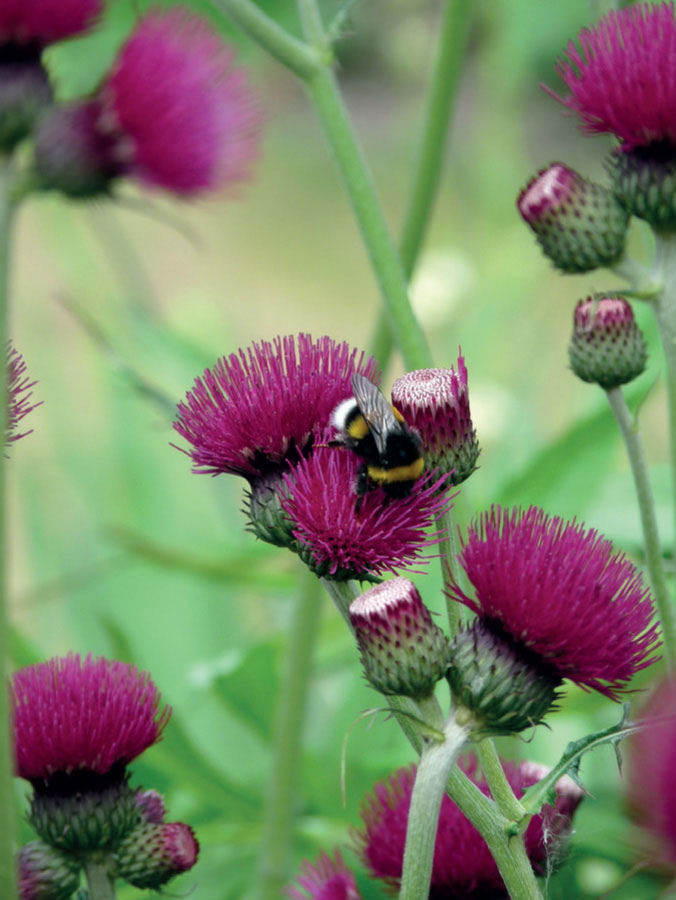
* Thymes Thymus
This large family of herbs form aromatic, low-growing mats of tiny, evergreen leaves, which become topped during May–July in equally small pink or purple flowers loved by bees and other pollinating insects. They grow well in full sun on steep banks and in troughs and are invaluable in gaps in paving, struggling if they face competition from other plants. Wild Thyme T. polytrichus is a common native across much of the British Isles, even in the mountains, and on downs, cliffs and heaths. In garden centres you are more likely to find Large Thyme T. pulegioides, native to southern England, and the very rare East Anglian native Breckland Thyme T. serpyllum, but there are plenty of other species and cultivars to try too.

Tickseeds Coreopsis
Most members of this genus of flowers from North America are quite bushy if delicate perennials to about 60cm, with attractive open daisy flowers in summer. The sunshine-gold outer petals often have serrated edges, and the small knot of florets at the centre is much visited by bees and some butterflies (see here). Three perennials to include in herbaceous borders are C. lanceolata, C. grandiflora and C. verticillata (above), the latter with especially fine-cut foliage. Annuals to try include C. tinctoria, usually with a band of chestnut at the base of the petals, and C. drummondii. Avoid double-flowered cultivars. Give Tickseeds a position in full sun in free-draining, even poor, soils; some may need staking.

Toadflaxes Linaria
Related to snapdragons, these attractive flowers are designed for bees, whose weight opens the mouth of the flower to get at the nectar and pollen inside. The best for pollinators is Purple Toadflax L. purpurea (above), native to Italy but long since grown in the British Isles and widely naturalised. It is a hardy, upright, rakish perennial growing up to 1m and looking fine among other perennials in a sunny border; it self-seeds freely. The small purple or pink flowers in June–August are fantastic for bumblebees. Common Toadflax L. vulgaris is a native perennial of unimproved grassy places throughout much of the British Isles, especially on chalky soils, but is rare in Scotland and Ireland. It is usually quite short, with delightful yellow flowers July–October with orange ‘headlights’ to guide in bumblebees. Toadflax Pug moth caterpillars feed on the foliage. Fairy Toadflax L. maroccana is an annual, as the Latin name suggests from Morocco, only growing to 30cm, with grass-like leaves and lots of small flowers in yellows and reds. Visited by solitary bees, it is ideal for the cornfield garden (see here). Ivy-leaved Toadflax Cymbalaria muralis (below, with Painted Lady) is native to southern European mountains but has been grown here for hundreds of years, and is now naturalised almost everywhere on old walls, where it roots into tiny gaps. The tiny flowers are visited by tiny bees!


Tobacco Plant (Flowering Tobacco) Nicotiana sylvestris
Native to Argentina, this rather ungainly annual (sometimes perennial in sheltered places) grows quickly to 120cm, topped in summer with immensely long and thin white tubular flowers releasing their heady fragrance at night. Only something with a very long tongue can reach the nectar, and that means hawkmoths, and in particular the migrant Convolvulus Hawkmoth with its 10cm wingspan. Grow in a well-drained but fertile soil in a warm position. There are other tobacco plants to try, such as the much shorter cultivars of N. alata, also known as Flowering Tobacco or sometimes Jasmine Tobacco, native to South America, but avoid the scent-free N. x sanderae.

Valerian, Red Centranthus ruber
Easy-to-grow, slightly fleshy, evergreen perennial, up to 1m, native to southern Europe but widely naturalised in northern Europe, especially in coastal areas on shingle and walls where it can be a problem for rare native shingle flora (so avoid it in such places). The loosely massed heads of pink or scarlet flowers (or white in the form ‘Alba’) bloom May–August and can be visited by several butterfly species (see here). It is also an important nectar plant for moths including the Hummingbird Hawkmoth, and some bumblebees also check in. It will grow in very poor soils, preferring plenty of sun, and self-seeds readily.
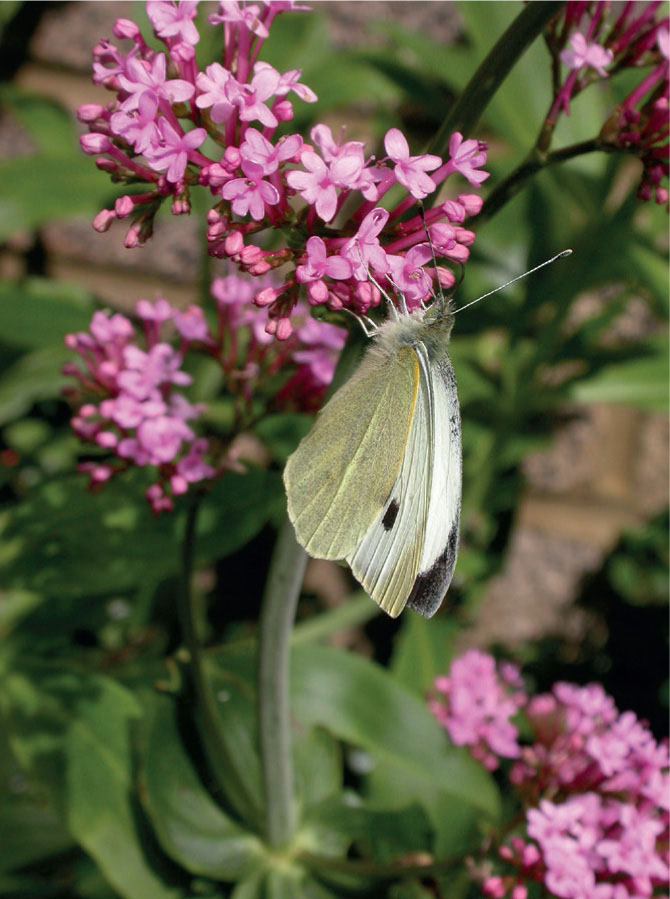
* Verbenas
From this big family, of which a few species are frequently grown in gardens, the best by far is V. bonariensis (above) from South America, the airiest and trendiest foil for all sorts of herbaceous border plants. It has thin but self-supporting stems, up to 1.5m, topped with flat clusters of small, pink-purple flowers. Some bumblebees visit, but it is even better for butterflies (see here) and Hummingbird Hawkmoths. It self-seeds well, and it is easy to take cuttings in autumn. Vervain V. officinalis is thought to have been in Britain since Neolithic times and has a subtle charm (ie very small flowers!) but is still quite popular with butterflies. V. rigida from South America, growing to 90cm or less, and V. hastata from the USA are readily available and can satisfy some bees and butterflies. Grow all verbenas in sun in well-drained soil.
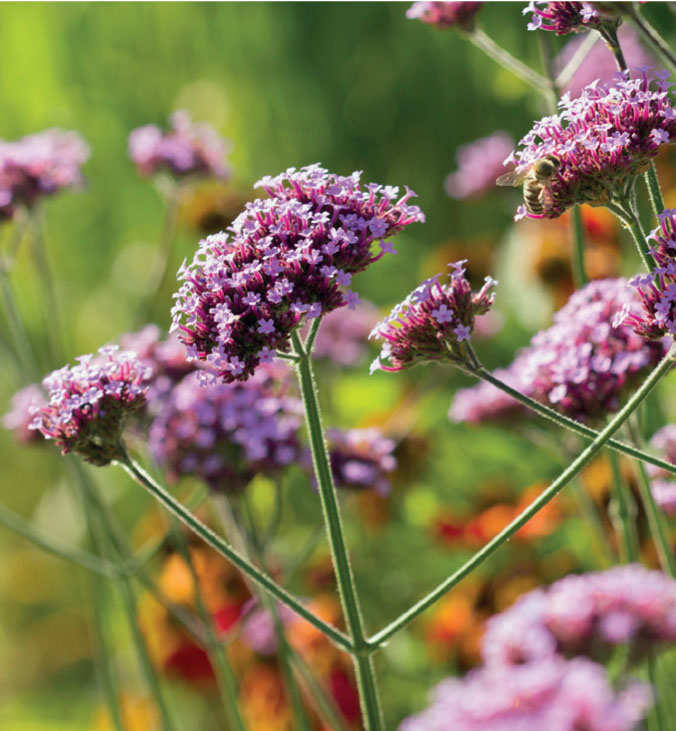
Vetches Vicia
Group of plants in the pea family, which clambers using tendrils. Despite not being typical garden centre plants, they look great in the garden, especially Tufted Vetch V. cracca (below), which is native to almost every corner of the British Isles. It scrambles up to 2m, draped over other vegetation, with rich-purple flowers in a one-sided spike visited by bumblebees, some butterflies such as skippers, and in particular by burnet moths. The foliage is the food plant of The Blackneck moth caterpillars. Another perennial, again a widespread native here, is Bush Vetch V. sepium (below), with small clusters of mauve flowers, the leaves eaten by Cream Wave moth caterpillars. Common Vetch V. sativa is an annual, native everywhere except the far north and rare in Ireland, with paired pink flowers. Vicia vetches are also eaten by other generalist moth caterpillars, gall midges and leaf-miner flies.


* Viper’s buglosses Echium
Great name; great wildlife! The stems of these perennials and biennials are usually covered in glass-like hairs and are topped with spikes of often blue flowers, popular with bees and many other insects. Viper’s Bugloss E. vulgare (above) is a fine-looking biennial of dry grasslands and coastal habitats, native to much of lowland Britain except the far north, growing to 60cm. Soldier beetles and burnet moths nectar at it and many garden moth caterpillars feed on it including the Orange Swift. However, if you want something even showier and you live in the sheltered south, go for one of the giants from the Canaries or Madeira, such as the 3m tall biennial E. pininana, the shrub-like perennial E. fastuosum, or my favourite flower of all, the scarlet flame-flowered E. wildpretii. For the front of flower borders, the annual E. ‘Blue Bedder’ is just as good as all the wild species.

Wallflowers Erysimum
The familiar Wallflower E. cheiri from southern Europe, also sold as Cheiranthus cheiri, and the similar Siberian Wallflower E. allionii are useful spring bedding plants with fiery flowers, the best of which are visited eagerly by bumblebees, but they are rather variable when it comes to insects. So focus if you can on the hybrid cultivars based on E. bicolor from the Canaries, in particular E. ‘Bowles’ Mauve’, which is widely acknowledged to be the best for pollinators including bees, bumblebees and especially many butterfly species. It is a perennial but quickly turns leggy, so take cuttings from them to keep a stock of fresh young plants.

Willowherb, Rosebay Chamerion angustifolium (syn. Epilobium angustifolium)
This native perennial of open woodlands, railway embankments and waste ground across most of the British Isles, forms dense stands. The flower stems, up to 1.5m tall, have pink spikes of flowers June–August opening from the base up, turning to curly pods of white fluff. It is an excellent nectar plant for moths and some bumblebees and a food plant for the caterpillars of Elephant and Small Elephant Hawkmoths. Some bees will also visit. A superb white-flowered form, ‘Album’, looks great in borders. Plant from seed in autumn; just beware you may need to keep it in check once established.

Wood Sage Teucrium scorodonia
Native throughout much of the British Isles, this adaptable, patch-forming perennial grows up to 50cm high in woodland glades, hedgerows, shingle beaches and dunes. It forms a modest flower spike of lime-yellow flowers with a large lower lip, a source of nectar for the Shears and Tawny Shears moths, while the soft, rounded leaves are the sole food plant of the day-flying moths Speckled Yellow and Golden Pearl. Look out, too, for Caucasian Germander T. hircanum, which has dense spikes of tiny purple flowers visited by bumblebees. The Wall Germander T. chamaedrys, a rare native of Sussex, is a small plant for a dry sunny situation that is a magnet for bumblebees.
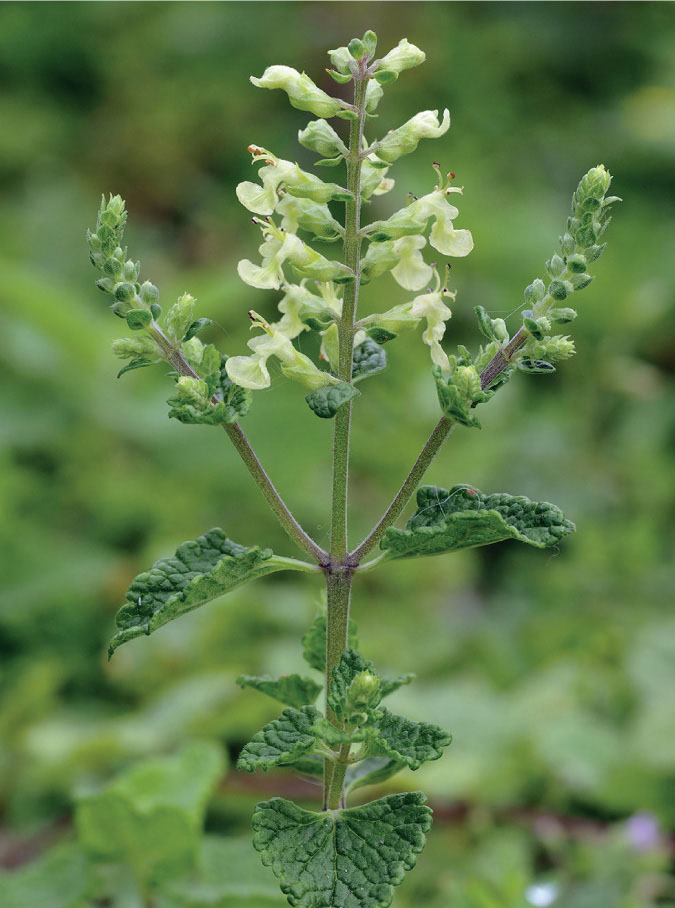
Yarrows Achillea
It is likely that your lawn already contains Yarrow A. millefolium, a native weed throughout most of the British Isles and the origin of a whole suite of garden cultivars. It is a perennial growing to 75cm, mainly in grasslands where its feathery foliage can be inconspicuous in cut grass. If allowed to flower, the flat densely-packed flower heads are white or tinged pink and offer easy access for solitary bees and solitary wasps, while a whole host of beetles and generalist moth caterpillars feed on the foliage, including the Tawny Speckled Pug. Plant breeders have been able to draw out flower colours from bright yellows to fiery reds, which I often find every bit as good for insects. A. filipendulina from Asia, rather taller up to 1m, has even larger ‘table tops’ of often bright yellow flowers that are great for short-tongued pollinating insects. Yarrows like a free-draining soil in full sun.

Yellow Archangel Lamiastrum galeobdolon
Closely related to the dead-nettles, this is a beautiful native of moist woodland in southern Britain, often in ancient woodlands, where it forms patches up to 30cm high, spreading via long runners. The whorls of bright yellow, hooded flowers during April–June are visited by bumblebees and larger solitary bees such as the Hairy-footed Flower Bee. The subspecies L. g. argentatum is a widely planted cultivar with silver patches on the leaves but is highly invasive and should be avoided.

Grasses
So often dismissed as ‘just grass’, there is so much more to it than that. In gardens, lawns tend to be sown with a very restricted range of cultivated species, often dominated by various rye grasses and fescues, but there are actually dozens of different wild species, including ones adapted to woodland, heathland and dry grassland. These wild grasses can also be incredibly beautiful in an understated way, such as Quaking Grass Briza media. Many of the wild species, such as Yorkshire Fog (below).
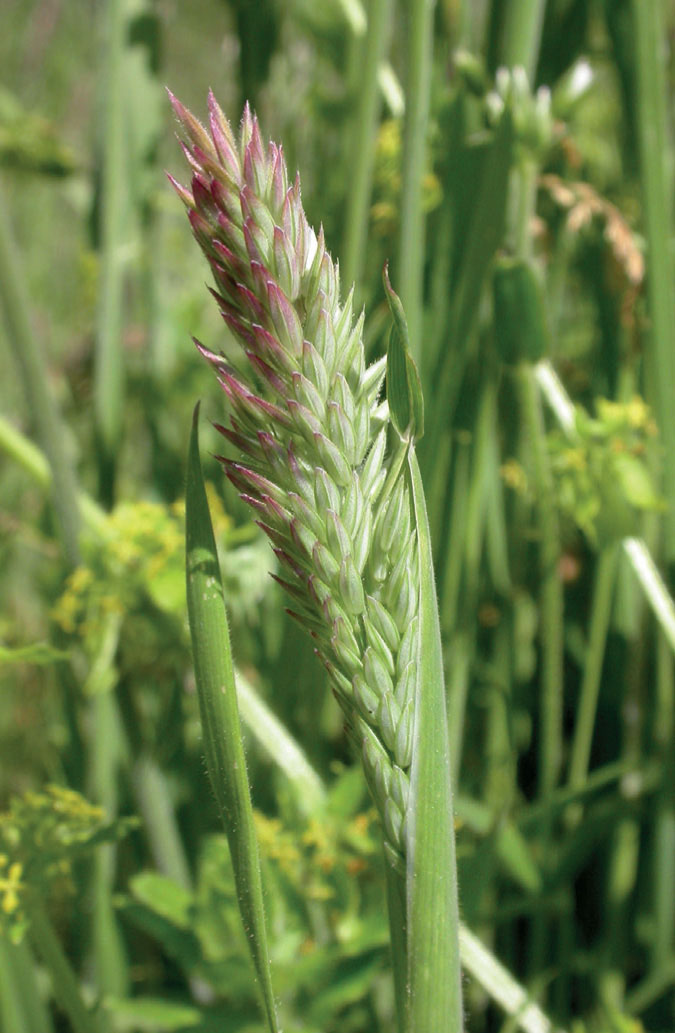
Bents and wild fescues are vital food for the caterpillars of several meadow butterflies as well as for various moth caterpillars, grasshoppers and bugs including the Tortoise Bug and the Turtle Bug.
There are then also lots of ornamental grasses, which have had something of a boom in popularity due to the trend for prairie planting. Often quite tall and with a ‘tufted’ habit (growing up from a central point), they are increasingly being recognised as a fabulous place for beetles and other small creatures to snuggle into, especially for the winter. They often produce lots of seeds, too, which can then be devoured by sparrows and finches.
One of the key things with any grasses, as far as wildlife is concerned, is letting them grow unchecked rather than mowing them constantly. This then offers wonderful cover for all sorts of wildlife, including Hedgehogs, and the tussockiness is used by voles and carder bees.
See here for those grasses to plant in a wildflower meadow, and here for heathlands. Anything you can do to choose grasses other than those used in cultivated lawn mixes gets you a giant tick where wildlife is concerned.

Ferns
The lush green foliage of ferns makes them pleasing additions to the moist, shady parts of the garden where few other plants survive. I have to be honest, their wildlife value is somewhat compromised by their lack of flowers or fruit, and few creepy-crawlies seem able to eat the foliage either. Nevertheless, they offer cover and microclimates that might otherwise be absent, often year-round in the case of evergreen species, and there are some micro-moths and leaf-mining flies that will use them. Why look further afield than our beautiful natives?
Three common evergreen species of walls and rocks: Common Polypody Polypodium vulgare, growing to 20cm, often on mossy tree trunks.
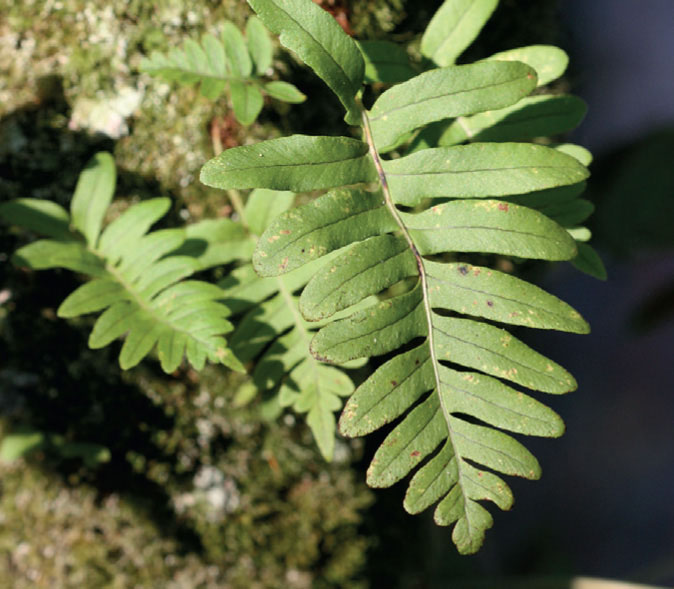
Common Polypody
Wall-rue Asplenium ruta-muraria, up to 10cm, with fans of little clover-like leaves.
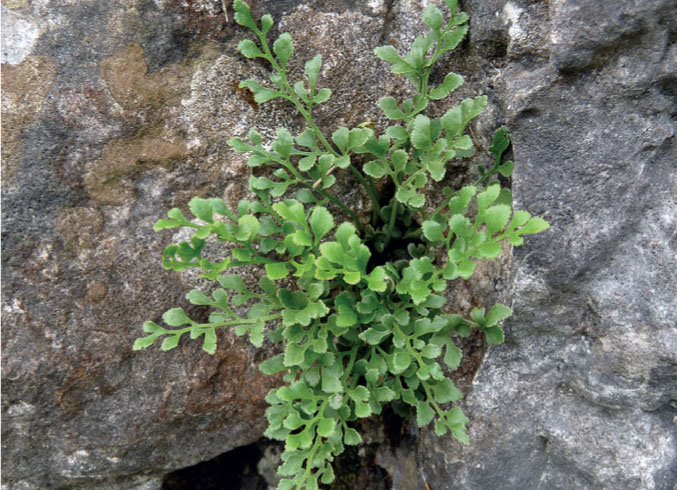
Wall-rue
Maidenhair Spleenwort Asplenium trichomanes, with delicate weak stems lined with square leaflets.
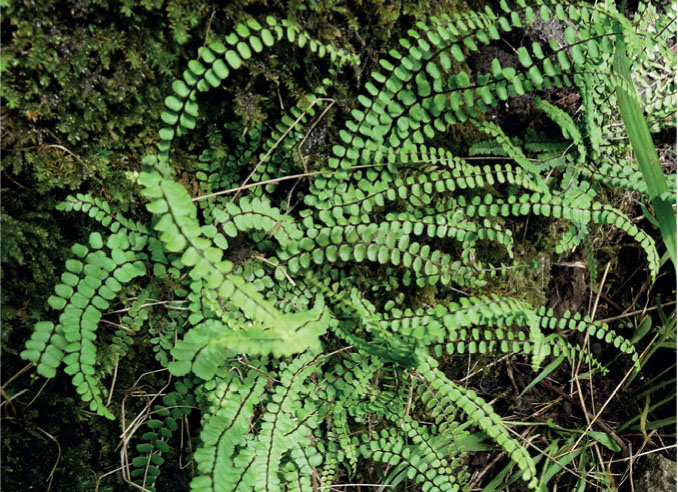
Maidenhair Spleenwort
Three deciduous species that form familiar 1m high shuttlecocks in woodland with deeply cut leaves: Lady Fern Athyrium filix-femina, Male Fern Dryopteris filix-mas and Broad Buckler Fern Dryopteris dilatata.

Male Fern
Hart’s-tongue Phyllitis scolopendrium, an unusual fern with its simple clump of leathery strap-like leaves, which grow to 30cm.
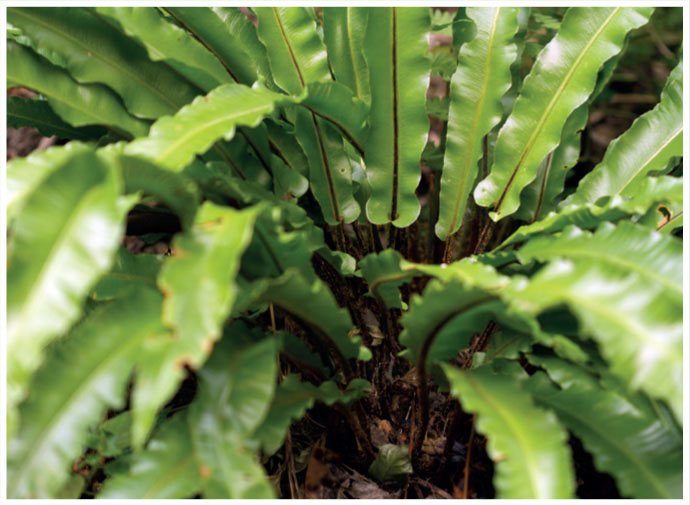
Hart’s-tongue
Hard Fern Blechnum spicant, common on acid soils in the wetter west, growing to 40cm, with leaves divided neatly into ‘fingers’.

Ostrich Fern (Matteuccia struthiopteris)
Pond and bog plants
The range of plants to use in a pond is small compared with what you can grow in flowerbeds. Their wildlife value is as much for the varied cover they offer as what might take pollen, nectar or feed on the leaves. Avoid the non-native invasive species at all costs (see here), buying only from the most reputable suppliers, but also avoid those plants that will be just too vigorous for the size of your pond – I’ve seen too many ponds where something like a White Water-lily has not only covered the entire surface but is actually busting out from the banks.
Avens, Water Geum rivale
Waterside flower of poorly drained soil native throughout much of Britain, especially the northern half. It has nodding, understated bell-flowers on long stems, the petals and cup of sepals a deep, shady red-pink. It will grow in semi-shade quite happily, where it is visited by bumblebees.

Bogbean Menyanthes trifoliata
One of the most distinctive water plants, with sprawling stems up to 1.5m long from which rounded trefoil leaves poke up through shallow water as a dense crowd of foliage. They are joined in late spring by flower spikes with pink buds opening to a head of white star flowers with frilly edges, visited by some bees and other pollinating insects such as flies. Grow in larger ponds only.

Bulrushes Typha
Everyone knows the head-height Bulrush T. latifolia (sometimes called Reedmace) that grows tall and dominant in large ponds and canals with its giant, chocolate-brown sausage seed heads. It is native to most of the British Isles but rare in Scotland. You may also know Lesser Bulrush T. angustifolia (below), rather more slender but often as tall and with thinner sausages; it is a scattered native mainly in England. Both have several beetles that use them and a few moth caterpillars such as the Bulrush Wainscot, and their seed heads are probed by Blue Tits and Chiffchaffs in search of insects hiding within them, as well as by Reed Buntings for seeds. However, they are vigorous plants that can choke small ponds quickly and their roots can puncture pond linings, so only plant it if you are sure your pond can cope with it. Avoid Dwarf Bulrush T. minima which is an invasive non-native species.

Flowering Rush Butomus umbellatus
One of the most attractive wetland plants native to most of lowland England, preferring fertile soils in alkaline waters. It is a perennial that likes to have its feet permanently in shallow water. The leaves are thin and grass-like, but the flowering stems grow to 90cm with an umbrella of pink flowers at the top in summer. It reproduces by rhizomes, is not especially rich for wildlife, but the slender stems are ideal for emerging dragon- and damselflies to cling to, and it certainly looks good!

Frogbit Hydrocharis morsus-ranae
A free-floating plant of still, shallow water, with leaves (borne in summer only) like miniature lily pads, this is a rather scarce native of scattered locations in England and Ireland. It sports charming three-petalled white flowers just above the surface. Its wildlife value is as a place for damselflies to alight and for pond snails to lay their eggs.

* Hornworts Ceratophyllum
An invaluable waterweed, including for the smallest of ponds. The common species is Rigid Hornwort C. demersum (above), native to still and slow waters throughout much of southern Britain, where it lives mostly submerged and free floating, forming dense masses without getting out of control. It is eaten by Moorhens and Mallards, and provides wonderful hiding places for aquatic life such as freshwater shrimps and tadpoles. It is also used by many dragonflies and damselflies as places to secure their eggs.

Irises
What beautiful flowers water irises are, with their strap-like leaves and large elegant flowers, but select carefully for the size of your pond. The glorious Yellow Flag Iris pseudacorus is native to almost the entire British Isles, with sunshine-yellow lily heads, but is too aggressive for a small pond or bog garden; however it will form a dramatic clump of 1m tall strap leaves along a large pond margin. If the flowers are en masse, Bumblebees will visit, and Moorhens will find plenty of places to hide among the leaves. For small ponds, there are two brilliant irises to try: Japanese Iris I. laevigata, or the equally beautiful I. veriscolor, both of which are typically a blue-purple colour.

* Loosestrife, Purple Lythrum salicaria
One of our most beautiful wildflowers, with elegant flowering stems up to 1.5m topped with a long head of magenta flowers loved by bees (bumble, Honey and solitary) and Brimstone butterflies. It is native to most of lowland British Isles, growing in clumps in damp soil or even with its feet in water. Some generalist moth caterpillars feed on the foliage, as do various leaf beetles and weevils. There are over a dozen cultivars of the species, with many spreading well in a moist herbaceous border where they are just as good for bees. For medium ponds and larger.

* Marsh Marigold Caltha palustris
Native throughout the British Isles, growing to 60cm at most, a glorious deciduous perennial of water margins and wet meadows, with large kidney-shaped leaves. In April–June, it is decked with large yellow buttercup flowers, visited by various pollinating insects such as hoverflies, flies and solitary bees but sometimes by Small Tortoiseshell and Peacock butterflies. It will happily grow in 10–20cm of water and is well behaved, even in quite small ponds. Avoid the doubles, usually called ‘Flore Pleno’ and ‘Monstrosa’.

* Mint, Water Mentha aquatica
A native perennial to almost the entire British Isles with scented foliage, growing along water margins and around ponds, even with its roots fully submerged. It is 90cm high at most, the flowers clustered in pompons at the top of leafy stems where they are visited by butterflies, especially the whites, Small Tortoiseshells and Peacocks. Easy to grow, but just be aware that, like most mints, it will put plenty of its energy into spreading, so if using in a small pond be prepared to need to keep it in check.

Pondweeds Potamogeton
There are many species of pondweeds in the Potamogeton genus, many growing up to 4m long under water, and so are only suitable for larger ponds. Here they help form the underwater landscape for pond creatures. Fleshy flower spikes emerge above the surface with clenched, lime-green, wind-pollinated flowers. Both Broad-leaved Pondweed P. natans (below) and Bog Pondweed P. polygonifolius have floating, heart-shaped leaves up to 12cm long, ideal resting places for damselflies and egg-laying spots for pond snails. The former is native to most of the British Isles, the latter to acid waters in the west, north and on heaths. Different in habit are Curled Pondweed P. crispus and Perfoliate Pondweed P. perfoliatus, both scattered natives in lowland areas of the British Isles, with upright submerged leaves.

Reed Phragmites australis
Wetland grass native across almost all lowland areas of the British Isles where it spreads quickly to form the familiar monoculture swathes of swaying, golden-topped stems in fens and marshes. Growing up to 3m high in a year and spreading by rhizomes, it is for large ponds only! It is also said to puncture pond liners. It does, however, provide wonderful cover, and even a few square metres of it may host some of its specialist moths, such as those in the wainscot family. Moorhens may nest among the stems, warblers and tits hunt for insects and Reed Buntings may drop in for the seeds, so if you have a pond large and robust enough it is certainly worth planting. Bundles of the cut stems are useful for adding to solitary bee boxes.

Rush, Soft Juncus effusus
Native across almost all the British Isles and common in damp areas, it forms a clump of sharp cylindrical leaves up to about 60cm tall. Its wildlife is a rather unspectacular entourage of micro-moths, leafhoppers and leaf-mining flies, but the fascinating form of the plant called ‘spiralis’ twists all over the place and makes an unusual addition to the pond, while the upright structure of the basic species is ideal for damselfly nymphs to clamber up as they emerge. Can be used in a small pond.

Spearworts Ranunculus
These two species of aquatic buttercup, both native to the British Isles, are useful in ponds to add marginal cover, although the flowers and foliage are not especially favoured by insects. Greater Spearwort R. lingua (below) is a deciduous perennial, up to 1m tall, a scattered native to lowland areas, much declined in the wild but popular as a pond plant and able to spread quickly on long runners. The open yellow flowers are up to 5cm across. Lesser Spearwort R. flammula is more suitable for small ponds, usually no more than 30cm high, with flowers 2cm across, and native throughout the country.
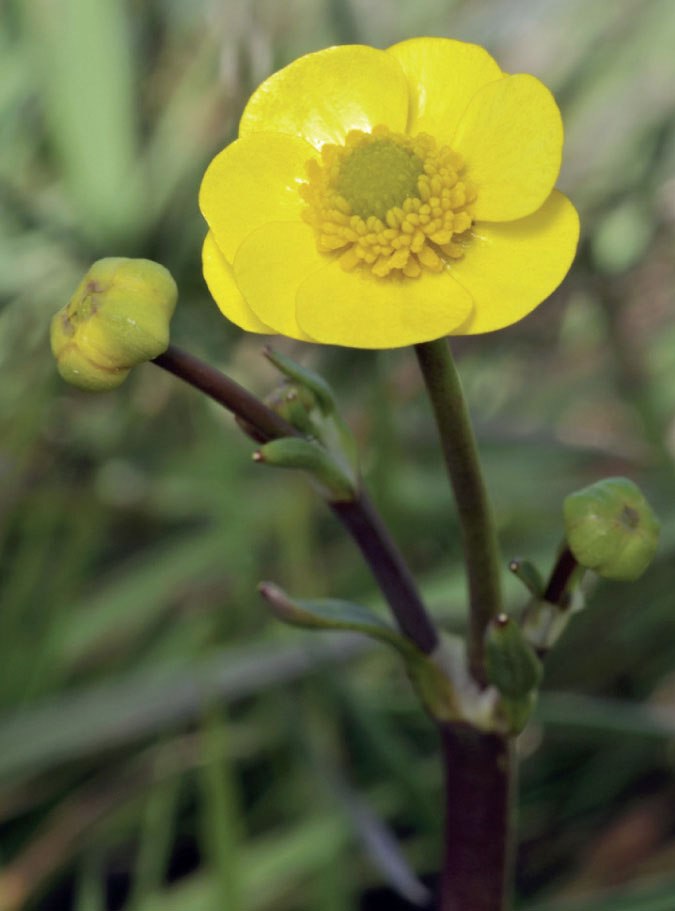
Water Crowfoots Ranunculus subgenus Batrachium
There are about a dozen species of this very variable, floating, aquatic buttercup, some of still water, some of fast-flowing. They often bear a mat of floating leaves plus a tangle of thread-like submerged ones; those on the surface become studded with a mass of white, five-petalled flowers. The leaves are eaten by Mallards and Moorhens, and pond creatures hide and lay eggs among the underwater leaves.
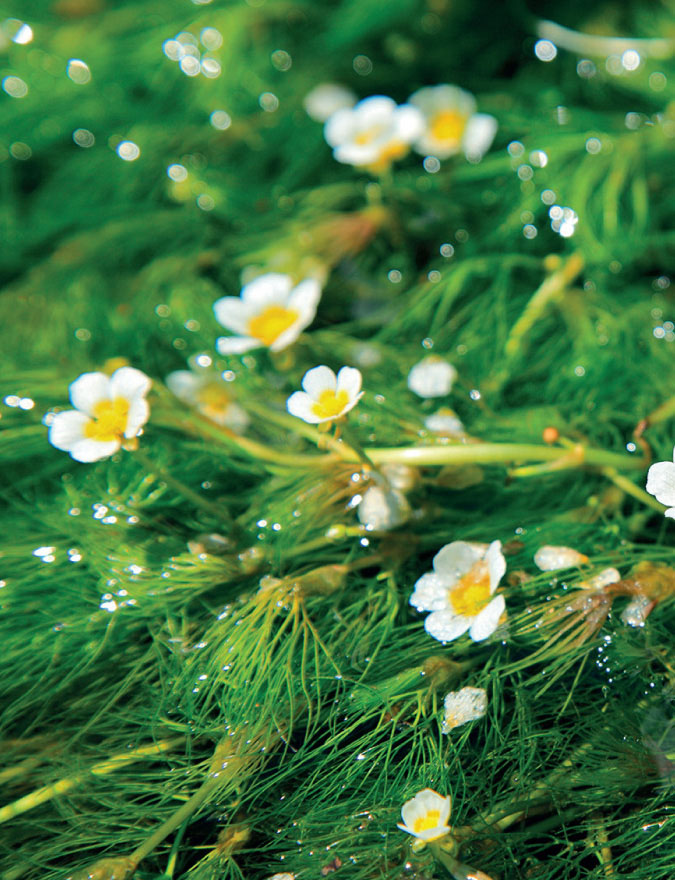
Water-lilies Nymphoides/Nymphaea
Choosing the right water-lily for the size of your pond is crucial. If you have a very large pond (one that most of us might call a small lake!), then try White Water-lily Nymphaea alba or Yellow Water-lily Nymphaea lutea, both probably native across much of the British Isles in large pools, lakes and slow rivers. Both are vigorous perennials, each large lily pad up to 25cm across offering wonderful vantage points for damselflies, while pond snails lay their eggs on the undersides of the leaves. The rootstock is huge. For smaller ponds (those still maybe 4m or more across), try Fringed Water-lily Nymphoides peltata, a native perennial to parts of the East Anglian fens and the Thames Valley but widely planted elsewhere. The leaves are 8cm across at most; the flowers up to 3cm, the whole plant spreading no more than 2.5m. For small garden ponds, you will need to choose carefully, selecting something like Pygmy Water-lily Nymphaea pygmaea from Europe and its hybrids, which are not known to be invasive.
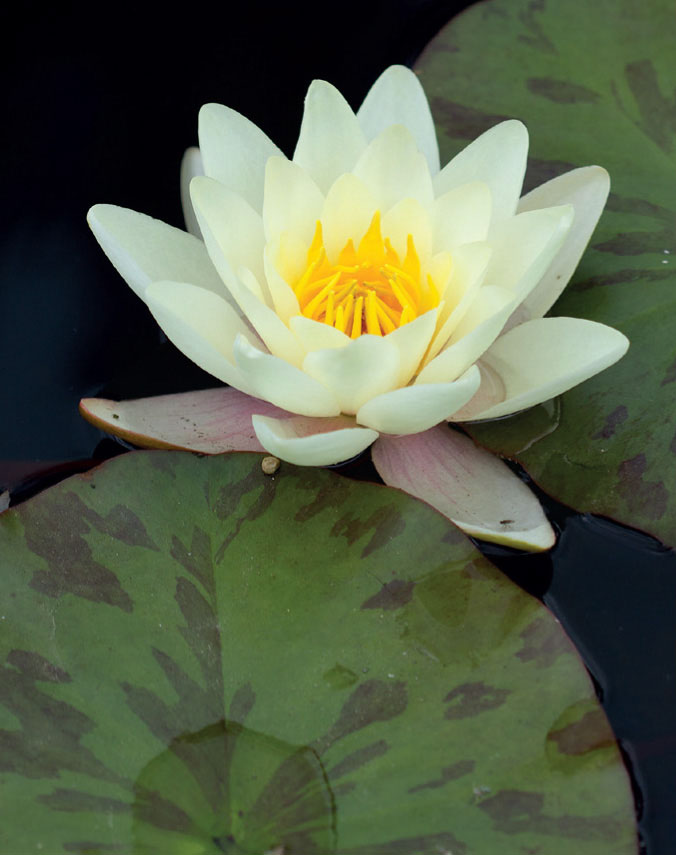
Water-milfoils Myriophyllum
These are perennial waterweeds, more feathery than the hornworts, with long stems up to 1m and fine-cut leaves in distinct whorls. In summer, the tiniest of reddish flowers poke above the surface. There are two widespread species native to the British Isles – Spiked Water-milfoil M. spicatum from lowland and eastern areas and Alternate Water-milfoil M. alterniflorum from more upland, western and acidic waters. They have some semi-aquatic weevils associated with them, but arguably their greater wildlife value is for all the pond creatures that hide among their fronds. In my pond, it tends to be where the Emperor dragonflies lay their eggs. Both are fine for small ponds.

Water-plantain Alisma plantago-aquatica
Native throughout much of the British Isles except the far north, this perennial likes growing with its feet in the mud beneath a few centimetres of water. It has immaculate, broad, pointed leaves held clear of the surface, and then flowers on an incredible, slender candelabra, up to 90cm tall, each branch ending in a small, three-petalled, pale pink flower. OK, so the leaf-mining beetles, flies and the micro-moth that use the plant aren’t going to set your wildlife world alight, but it is a nice native pond plant to have, and is dainty enough for small ponds.

Water Plaintain, Lesser Baldellia ranunculoides
I include this separately from Water Plantain as it is in a separate family and looks very different. Instead of the erect leaves and wiry candelabra of its cousin, the Lesser forms a spreading clump of inch-long leaves in shallow water, with a sprinkling of dainty, palest-pink flowers over the top.
It is the kind of plant that can get rather lost in a large pond, but is perfect for a small pond where so many other plants would be thuggish. The cover it offers, rather than its palatability or nectar, is what makes it a useful addition for wildlife.

Water Soldier Stratiotes aloides
This plant is something of a curiosity, which many gardeners love to grow in their ponds. It is perhaps best described as a floating crown, for each plant is a whorl of spiky, saw-edged leaves. In autumn, each ‘crown’ sinks under the surface, then rises again in late spring, its stiff leaves emerging like synchronised swimmers sticking their legs in the air.
In the UK, it may be native only to East Anglia, but can be grown in most sheltered, mild areas. Interestingly, there are no male Water Soldiers in Britain; our all-female population can have simple three-petalled flowers in summer. Its value for wildlife is in the cover, shade and damselfly perches it offers.

Water Speedwells Veronica
There are three main species to try, all attractive and all found in pond margins and sunny ditches, sprawling to about 50cm, with typical four-petalled speedwell flowers. Few large insects are associated with them, and their value is more for the cover and microhabitat they bring to the water’s edge. Brooklime V. beccabunga is native throughout most of the British Isles, with rich blue flowers, fleshy purplish stems and rounded leaves. Blue Water Speedwell V. anagallis-aquatica and Pink Water Speedwell V. catenata are both annuals, less fleshy and with longer leaves than Brooklime. The Blue is native to much of lowland British Isles, the Pink more restricted to England and Ireland. All look great in a small pond.

Water-starworts Callitriche
It took me a long time to come around to the virtues of this group of understated aquatic plants. Individually, the paired leaves are small and insignificant; as for the flowers, blink and you’ll miss them. But it is when the plants create a dense mass of fresh-green leaves, whether in still water or flowing, that you sense its value as underwater cover for a whole host of pond life. There are seven species native to the British Isles, but you’ll need to find a specialist grower of native pond plants to be able to purchase a clump or two.

Woundwort, Marsh Stachus palustris
This downy perennial is far better behaved and prettier than its cousin, Hedge Woundwort. It is native in damp places throughout the British Isles, rarely grown as a garden plant but a fine addition to bog gardens and damp pond margins. The whorls of pink flowers up a 1m strong stem are excellent for bumblebees, especially Common Carder Bees.
Given enough damp soil or mud to colonise, it should quickly clump up into an attractive stand. However, avoid the hybrid between Marsh and Hedge Woundwort, however, which is a brute. Use alongside medium ponds and larger.

Vegetables and soft fruit
These are some of the crops you can grow that will feed you and your family but at the same time benefit wildlife. I’m not including plants such as cabbages where, if you took a deep breath, you might be able to tolerate a few Large White or Small White caterpillars chomping through your dinner. Nor do I mean those plants that, if sacrificed and allowed to go to seed, are good for wildlife too, although remember that onions, leeks, parsnips and carrots are great for that. No, this is very much about 100 per cent win–win situations.
Bean, Broad Vicia faba
Although they don’t necessarily need insects to pollinate the flowers – they can do that themselves quite happily and still produce pods full of beans – some fascinating research almost 50 years ago showed that if you do encourage pollinators, especially bumblebees, your crop will increase quite dramatically.
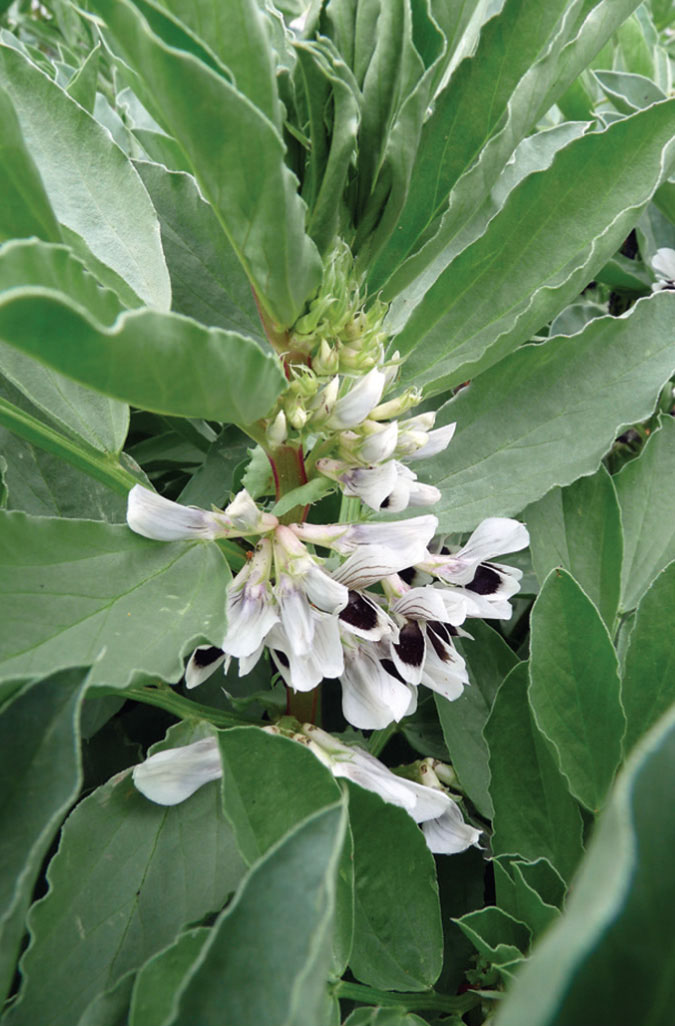
Bean, Runner Phaseolus coccineus
A star plant for bumblebees and Honeybees, the scarlet flowers also look wonderful in the flower border or large pots growing up a wigwam of canes. Grow in sheltered spots, even lightly shaded, give them deep, rich soil, water regularly, and remember they are frost-tender so start them off indoors in spring. A cultivar such as ‘Butler’ has masses of flowers; just pick regularly to keep the flowers coming. Dwarf cultivars can be as little as 40cm tall. Note that French Beans P. vulgaris are self-pollinated – it’s ‘runners’ you want for wildlife.
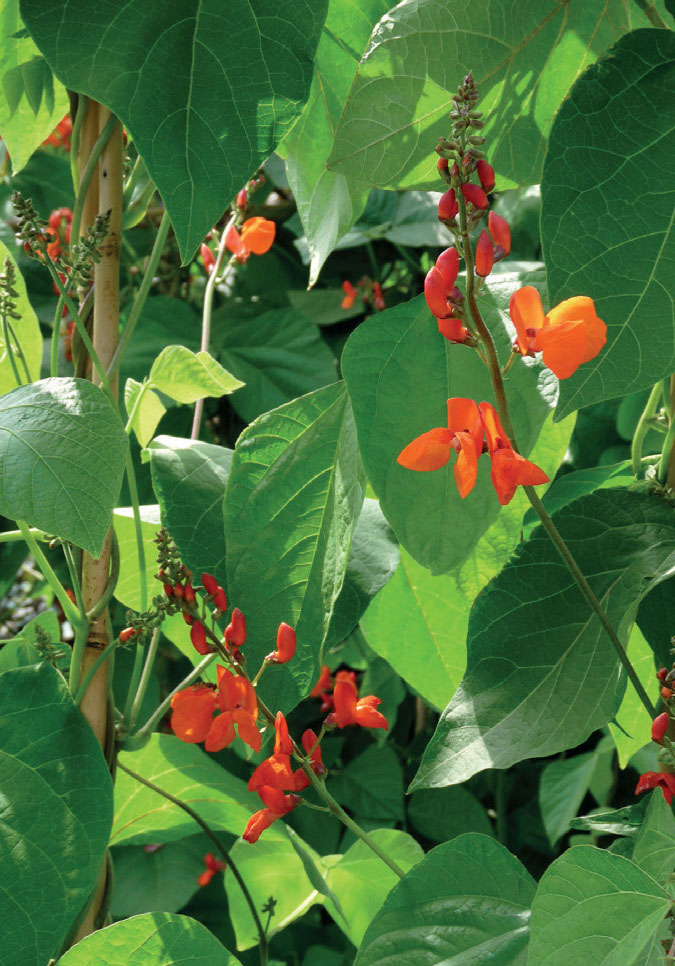
* Currants Ribes
You may not want birds gorging themselves on the berry crop, but there is still a chance for wildlife to enjoy the bushes earlier in the year if you hold off netting until the crucial season. There are three main species, all of which are widely naturalised in the British Isles: Redcurrant R. spicatum (which may actually be native), Blackcurrant R. nigrum (which has aromatic leaves) and Gooseberry R. uvacrispa. The latter two are both thought to be European in origin. All grow to about 1.5–2m tall, enjoying light shade and rather moist ground. Their small flowers look insignificant, but bumblebees love them and research has shown that you will get a better crop if you allow bees access to them. The foliage is also eaten by caterpillars of the Phoenix, the Spinach, Currant Pug and the V moths.

* Raspberry Rubus idaeus
A native of woodlands and scrubby areas throughout almost the entire British Isles, it has since been cultivated to produce summer- and autumn-fruiting varieties offering bigger fruit and a heavier crop. The list of insects, from sawflies to moths, that feed on the foliage is huge, and although Raspberries can be self-fertile, the number of berries produced is higher if there are good numbers of bumblebees and other bees to pollinate them.
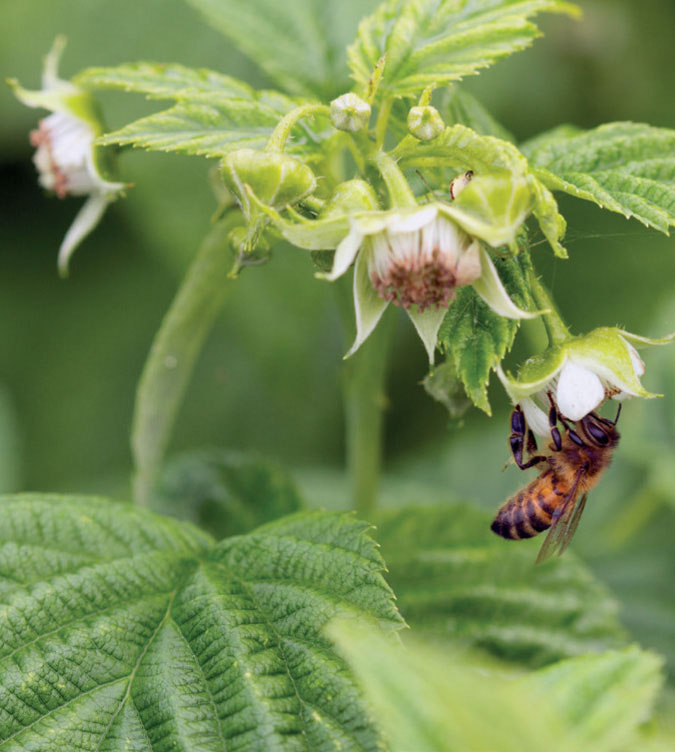
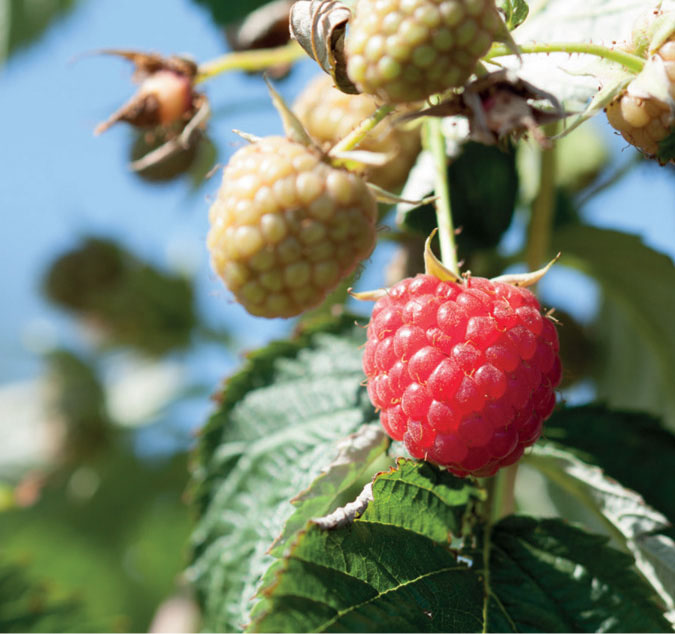
Weeds
There are some native plants that are so unruly or bland or coarse that I think I’d struggle to convince all but the most dedicated gardeners to plant them on purpose, but which are likely to pop up anyway in your garden because they are so successful and ubiquitous. These are your out-and-out, bona fide weeds! However, they have some considerable virtues for wildlife, so if you have a corner where you can just let them be, wildlife will certainly benefit.
* Bramble Rubus fruticosus
Although not compulsory, Bramble is an undeniable wildlife all-rounder of the highest standard, offering tasty foliage for many moth caterpillars including Buff Arches and Peach Blossom, and for Speckled Bush-crickets. They produce ample nectar for many butterflies (see here) and bumblebees, and the berries are eaten by Dormice, mice, Foxes and birds such as Greenfinches, while many autumn moths get merry on the overripe berry juices. In addition, its thorny, thickety nature creates ideal nest sites for birds such as Wrens and hideaways for Hedgehogs. Maybe you can find a space for it in wilder parts of the garden or train it over a log pile?

Charlock Sinapis arvensis
This is one of several widespread species in the very useful wild cabbage family (crucifers). It is a coarse annual, usually growing to 50cm, with four-petalled, bright yellow flowers in any month April–November. An archaeophyte across most of the British Isles in arable fields and waysides, it provides valuable seeds for finches, and a fine breeding ground for various leaf beetles, weevils, pollen beetles, thrips and generalist moths, as well as Large and Small White butterflies.
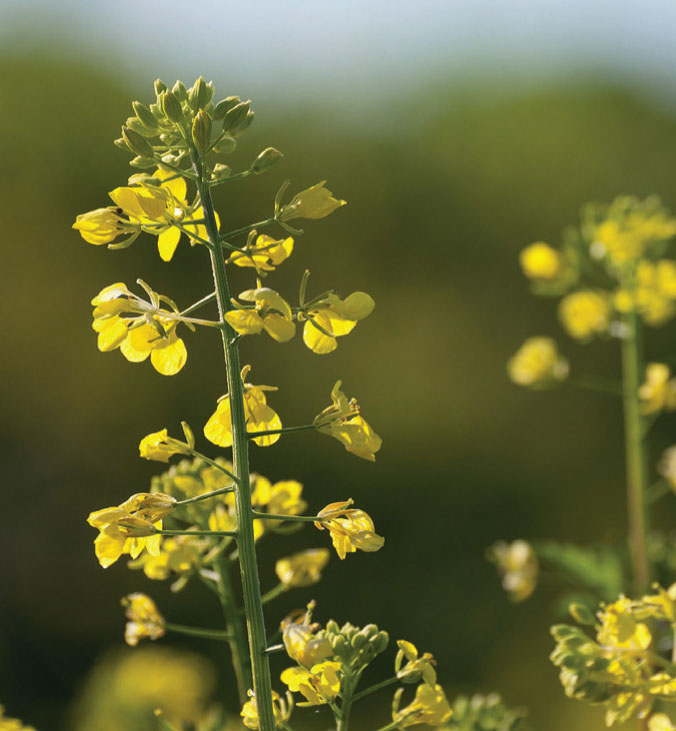
Chickweed Stellaria media
I bet this extremely common but inconspicuous annual weed is probably in flower somewhere in your garden right now. Native almost everywhere in the British Isles, its tiny, starburst, white flowers appear in any month. It can churn out three generations of plants a year, producing lots of seeds for finches and buntings. Its foliage also seems eminently palatable, with caterpillars of dozens of moths munching happily on it. All Chickweed needs to flourish is a bit of disturbed fertile soil. It is easy to weed out, so just leave it be where you can.

Coltsfoot Tussilago farfara
A low, spreading perennial, up to 15cm tall, Coltsfoot has dandelion-like flowers from January onwards that appear before the leaves. It is this early source of seeds that marks it out as an important plant for finches and sparrows just at the point when resources are often low. It also provides food for Triangle Plume and Coltsfoot Bell moth caterpillars.

Dandelions Taraxacum spp.
Surely one of the best-known native wildflowers, there are over 230 microspecies in the British Isles of this perennial, all looking rather similar to all but the few experts. A field full of Dandelions is a joy to behold, such is the intensity of the sunshine-yellow flower colour; strange, then, that we make such an effort to remove them from our lawns. Left in place, they are especially good for solitary bees, some butterflies will visit them, and the leaves that are so beloved of Rabbits are also one of the best for a wide range of moth caterpillars.

* Garlic Mustard (Jack-by-the-hedge) Alliaria petiolata
This biennial may even get a place in your borders for its wonderfully fresh-green, heart-shaped leaves, but it becomes dried and withered by July. It is a key food plant for Orange-tip and Green-veined White caterpillars, and for the Brassica Bug.
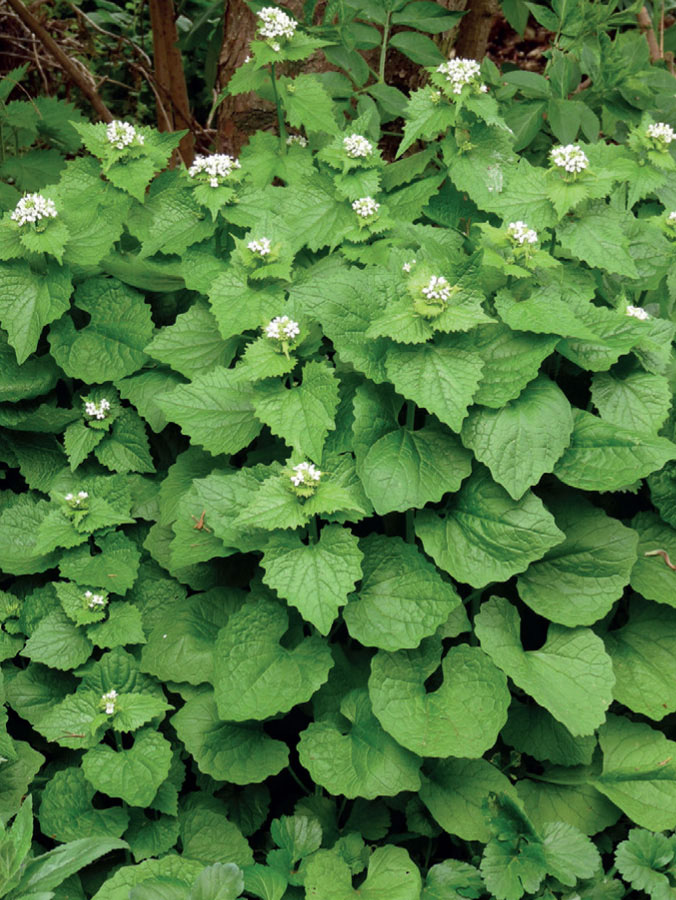
Goosefoots and Oraches Chenopodium/Atriplex
It is hard to claim that these are attractive plants, but they are important for the amount of seeds they produce, which are eaten by finches, sparrows and buntings. Plenty of insects feed on the foliage, too, including caterpillars of Dark Spinach and the Nutmeg moths. Key plants in the group include Fat Hen C. album and Common Orache A. patula, both of which are native throughout the British Isles except in the Scottish Highlands, wherever the soil has been turned. In a garden, let them do their thing in a fallow plot and watch the little birds flock in! They are really easy to weed out with a quick tug if you need to. However, I do rather like the perennial Good-King-Henry (cracking name!) C. bonus-henricus (above), which is an uncommon perennial found on rich soil around farmyards and, in my view, rather stately.
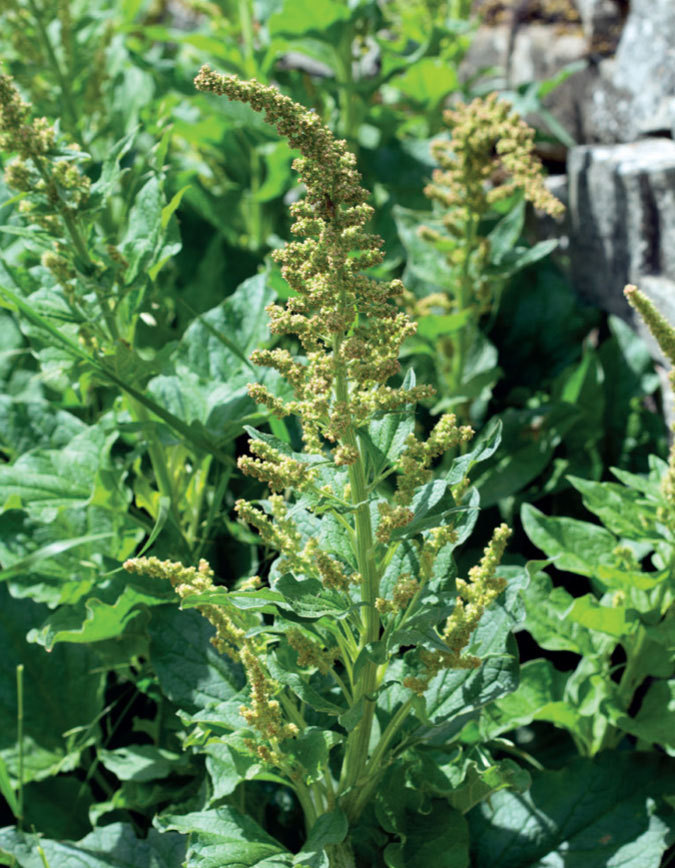
Groundsel Senecio vulgaris
Ubiquitous annual weed wherever the soil is turned, native throughout the British Isles. The stems are reddish, to 30cm max, flowering in any mild spell of weather where the little flower heads are like clenched baby dandelions quickly turning to seed-clocks. Its value for wildlife comes from its commonness, the palatability of all those seeds for finches, and the fact that the leaves are edible to dozens of moth caterpillars and leaf beetles. If you don’t need to yank it up, leave it be.

Hedge Woundwort Stachys sylvatica
Rather coarse weed with unpleasantly scented leaves (I warn you: don’t rub them!), native to most of the British Isles and spreading quickly along hedges and in light shade using rhizomes. It sends up flower spikes to 1m at most, with whorls of sparse, pink-purple, lipped flowers that are fabulous for bumblebees, while the Bronze Shield Bug feeds on the furry foliage. It can be invasive, but in a grassy hedgerow margin it is possible to tolerate it.

Hogweed Heracleum sphondylium
A coarse, hairy, deep-rooted perennial growing up to 2m, with large umbels of white flowers, native to almost the entire British Isles in woodland glades, hedgerows and grassy places. In a sunny position, it can be a magnet for all sorts of hoverflies, solitary wasps, longhorn beetles and flies that you’ll rarely see on other flowers. With all sorts of gall midges, leaf beetles and micro-moths using the foliage too, it is insect paradise. It can be grown in semi-shade, and self-seeds easily.
Knotgrass Polygonum aviculare
Understated little annual, native throughout the British Isles, one that you’d step on and not know it, and yet eaten by dozens of moth caterpillars. It can trail up to 1m across the ground or through sparse grass, with small, simple leaves and minute flowers that are slightly pink (if you get up close!). It flowers June–November, and the prolific seeds are enjoyed by birds such as sparrows and buntings.

* Nettles Urtica
Stinging or Common Nettle U. dioica is a native perennial throughout almost the entire British Isles, forming dense stands on fertile ground. Hairs on the stems and leaves snap at a slight touch, injecting the chemical cocktail that causes the pain. The flowering stems can grow to 2m, with insignificant wind-pollinated flowers but copious seeds eaten by Bullfinches and Dunnocks. The foliage is eaten by brave caterpillars of Burnished Brass, the Spectacle and Dark Spectacle, the Snout, Mother of Pearl, Small Magpie and the very common Nettle-tap moths. Nettle also has its own weevil and ground bug, and many other insects find excellent cover here.
However, it is as a food plant of the caterpillars of Peacock, Small Tortoiseshell, Comma and Red Admiral butterflies that it is perhaps best known. What isn’t so well understood is that they are rather picky about how and where the Nettles are growing. Unless you have large, sunny beds of them, your chances of success are quite slim, but if you have room I’d still say give it a go because a garden filled with those four butterflies is paradise.
Small Nettle U. urens is a rather neat annual archaeophyte of disturbed ground in much of lowland Britain, but rare in Ireland, growing to 60cm and offering some of the same benefits as its big cousin.

Plantains Plantago
If you aim for a perfect lawn, you probably spend hours trying to winkle these fellas out. Native to almost every part of the British Isles, Greater Plantain P. major is particularly adept at coping with being crushed underfoot, throwing out a suffocating low rosette of broad leaves, while Ribwort Plantain P. lanceolata (above) has much more slender leaves and is a common and rather attractive plant of grassy meadows. The foliage of both is eaten by lots of generalist moth caterpillars. Both have hard, plain flower heads with a ruff of shaggy stamens, the result of which is more seeds for more birds such as finches and sparrows. Try Hoary Plantain P. media (below) in wildflower meadows (see here).
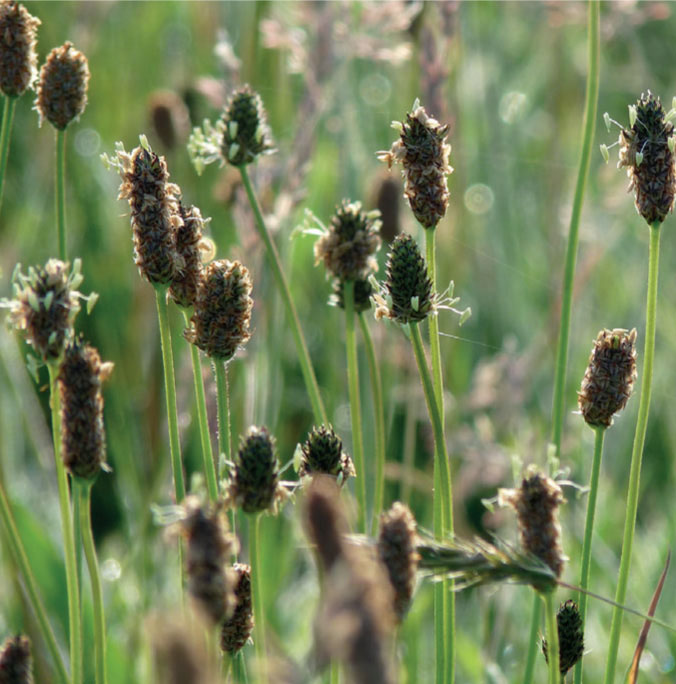
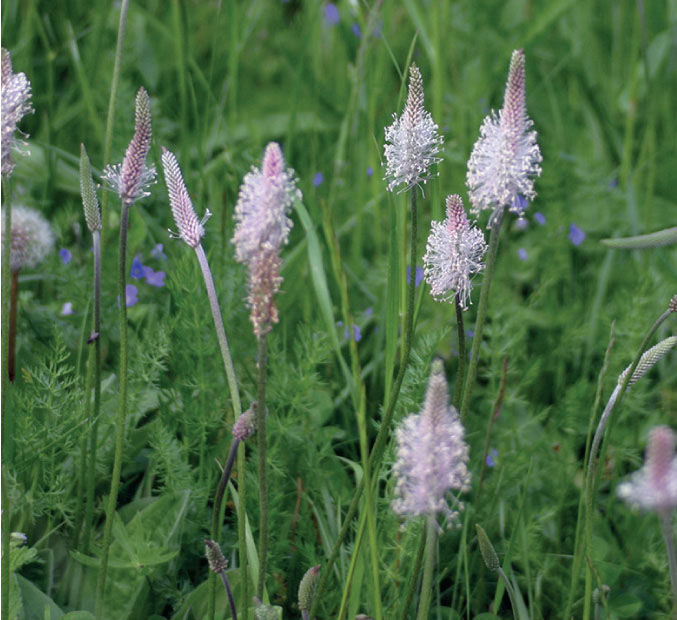
Redshank Persicaria maculosa
Yes, a weed with the name of a bird, this is an annual, with stems up to 80cm or so tall but which usually sprawls across cultivated or damp ground. The lance-shaped leaves are easy to spot, each with a dark smudged ‘V’ across them, and are eaten by various sawflies and weevils. The flowers are borne in a tight, pinkish spike, producing abundant nutty little seeds for birds such as Greenfinches.
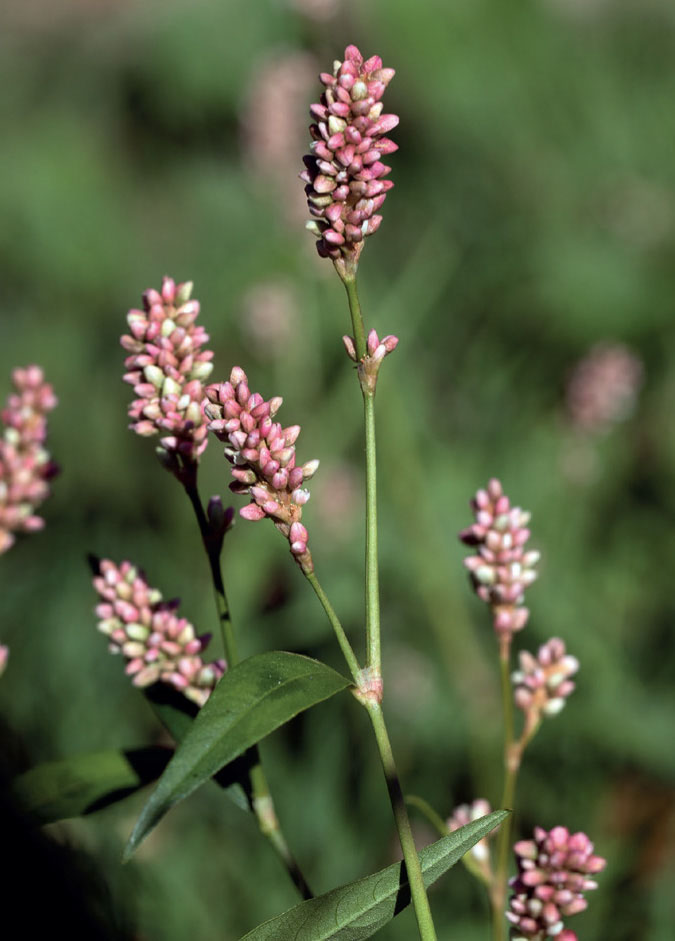
Sorrels Rumex
I stopped short of recommending the rather coarse and vulgar docks, despite how much seed they produce, but the closely related sorrels are just as good as a seed source for birds such as Greenfinches, and they are the food plant of caterpillars of the Small Copper butterfly and Blood-vein moth. Both Common Sorrel R. acetosa (below) and Sheep’s Sorrel R. acetosella are native throughout the British Isles in grassy places, the former growing to 80cm in pastures and downland, the latter only 20cm tall at most and preferring acid soils and short vegetation. The small red flowers are held in dangling clusters. Grow in a meadow area, where they can look beautiful against the light.

Plants to avoid
Considering what not to plant is perhaps more important than all of the species you might like to try.
We grow thousands of garden plants from all corners of the globe, and most of them are wholly benign and ‘behave’ themselves. However, a few have run riot. They are called ‘invasive non-native species’ or INNS. They can have a devastating impact on native wildlife, and can be very expensive to control.
The plants in this section are all on Schedule 9 of the Wildlife and Countryside Act, which means it is illegal to plant them in the wild, and in gardens it is expected that ‘reasonable measures will be taken to confine them to the cultivated area so as to prevent their spreading to the wider environment’. As of 2014, five are also banned from sale in England and Wales, and the Wildlife and Natural Environment (Scotland) Act 2011 brought in new provisions governing the introduction of non-native species in Scotland.
The list of invasive species is unfortunately growing, and more work is being done to ‘horizon scan’ to see whether others are likely to cause a problem in the future: it is far better to nip something in the bud now rather than wait until the horse has bolted. Those identified as being ‘Critical’ for investigation have not been included in the main list of recommended plant species, and include these very familiar species:
 Butterfly Bush Buddleja davidii
Butterfly Bush Buddleja davidii
 Pampas Grass Cortaderia richardii
Pampas Grass Cortaderia richardii
 Bay Laurus nobilis
Bay Laurus nobilis
 Tree-of-heaven Ailanthus altissima
Tree-of-heaven Ailanthus altissima
 False-acacia Robinia pseudoacacia
False-acacia Robinia pseudoacacia
 Portuguese Laurel Prunus lusitanica
Portuguese Laurel Prunus lusitanica
 Firethorn Pyracantha coccinea and P. rogersiana.
Firethorn Pyracantha coccinea and P. rogersiana.
What harm do Invasive Non-native plants cause?
Freed from the natural factors that control them in their homelands, some non-native plants have spread like wildfire into our native habitats. They out-compete native plants, which has a knock-on effect on the wildlife that lives in UK habitats. For example, invasive non-native water plants choke waterways and ponds with dense mats of vegetation. This cuts out light from the water, reducing oxygen levels and increasing the nutrients, meaning far fewer water creatures survive. They can even increase the risk of flooding.
If you have any of the invasive species in this section, do try to control and destroy them, but don’t put them in green waste bins. With some species such as Japanese Knotweed and Giant Hogweed, it is best to seek advice from professionals.
Bluebell, Spanish Hyacinthoides hispanica
This bulbous perennial native to Iberia, grown widely as a garden plant, has ‘escaped’ into the wild where it grows strongly and interbreeds with the English Bluebell H. non-scripta, threatening to dilute our native species. In flower, the ‘bells’, which can be blue, pink or white, are fragrance-free, surround the stem rather than being in a single spike, and don’t ‘nod’ like ours do.

Cotoneasters
Sadly, for a groups of shrubs that were excellent for berry-eating birds, it appears that Holly-berry Cotoneaster C. bullatus, Wall Cotoneaster C. horizontalis, Himalayan Cotoneaster C. simonsii, Entire-leaved Cotoneaster C. integrifolius and Small-leaved Cotoneaster C. microphyllus are becoming invasive shrubs in the countryside, and dozens of other varieties may be following suit. Their seeds are spread by birds, so they are best avoided.

Hogweed, Giant Heracleum mantegazzianum
A giant biennial, up to 4m tall, from the Caucasus and once used as a border plant, it has immense leaves that block out native vegetation. Take great care if you come across it as the sap can cause a violent skin reaction lasting years, and removal of the plants needs to be done with full protective equipment. With one plant capable of producing 100,000 seeds, control is proving difficult.

Himalayan Balsam/Indian Balsam Impatiens glandulifera
A waterside annual introduced to Britain for its attractive pink-purple flowers. These are enjoyed by bumblebees, but don’t let that lessen your resolve! They grow to 3m in one season, and form explosive seedpods that catapult seeds up to 7m. Pull it up before it seeds to stop it spreading.

Hottentot Fig Carpobrotus edulis
A fleshy trailing species from South Africa with showy flowers, a single plant can be 50m across. Mainly found on southern cliffs, it smothers native vegetation, and when it is removed it leaves the exposed soil vulnerable to erosion.

Knotweed, Japanese Fallopia japonica
Introduced from Japan in the 19th century for its creamy-white flowers, this is a brute that can grow through tarmac and floorboards, and can regenerate from a fragment of root. Removal involves a horribly costly process of chemicals and burial of contaminated soil.

Parrot’s Feather (Brazilian Water-milfoil)
Myriophyllum aquaticum (M. brasiliense) Widely available, with delicate fresh-green feathery leaves in whorls of four to six, the 2m stems swamp ponds. Control is by chemicals or repeated pulling.

Pennywort, Floating Hydrocotyle ranunculoides
From North America, with attractive lobed leaves on top of the water, it can grow at a rate of up to 20cm a day. It is causing huge problems, all the more alarming as it was first found in the wild in Britain only in 1990. Control is very difficult, best done by repeated and careful hand-pulling.

Pondweed, Canadian Elodea canadensis and
Nuttall’s Pondweed Elodea nuttallii
From North America, these submerged pondweeds, similar to native Hornwort, can fill the water column with long stems lined with whorls of leaves. Control by hand-pulling.
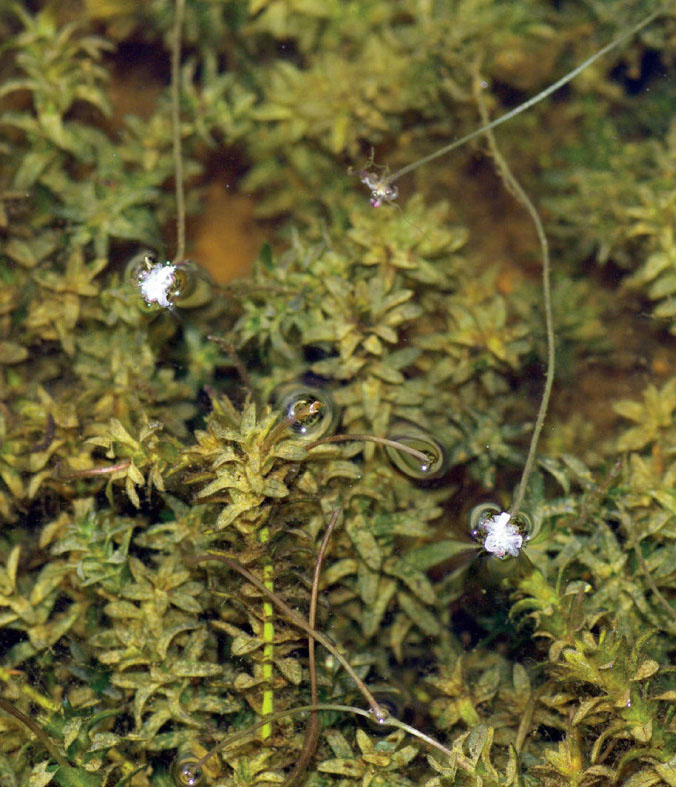
Pygmyweed, New Zealand (Australian Swamp Stonecrop) Crassula helmsii
An innocuous-looking bruiser first grown in English gardens in the early 20th century, and now found in more than 2,000 wild locations. It is a low-growing, rather fleshy plant with whorls of little pointed leaves on pinkish stems and small white flowers with four triangular petals. Control is very difficult, and often requires chemicals.
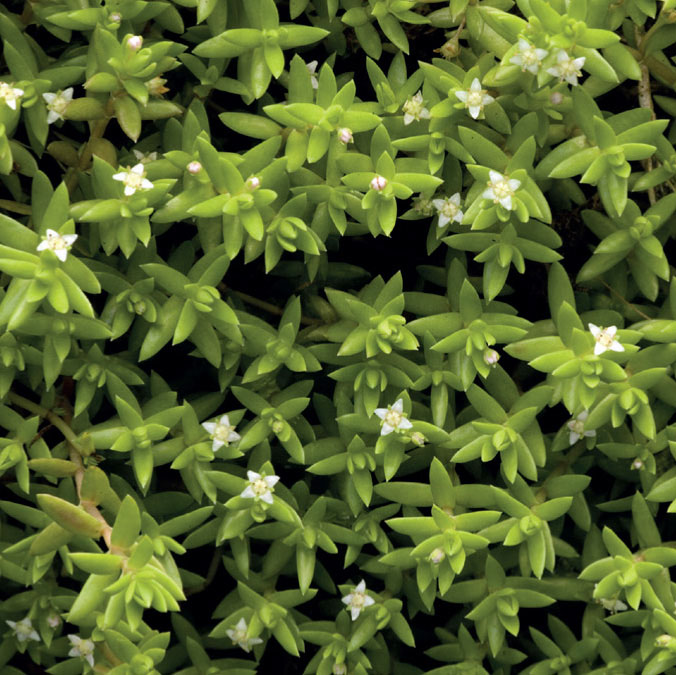
Rhododendron Rhododendron ponticum
Oh dear, this one particular type of rhododendron is such a problem plant, despite such beautiful flowers. It shades out native plants, changes the chemical composition of the soil making it difficult for other plants to germinate, spreads quickly and is host to the tree-killing disease Phytophthora. Fortunately, if you love rhododendrons there are plenty of types other than R. ponticum to grow.

Rhubarbs, Chilean
Gunnera tinctoria and G. manicata The huge leaves are magnificent – unless you’re another native plant shaded out by them. They produce thousands of seeds, which are spread by birds.

Rose, Japanese Rosa rugosa
I’ve seen this widely grown shrub with its large pink flowers marching out of control across sand dunes and sea cliffs. No matter that birds like Greenfinches enjoy the hips and bees visit the flowers – the damage it does to other wildlife outweighs this.

Virginia Creeper Parthenocissus quinquefolia
Yes, even familiar species like this are now on Schedule 9 of the worst offenders, so although the autumn colour as it cloaks walls is delightful, go for something like Boston Ivy which has the same visual effect but without known invasive tendencies.
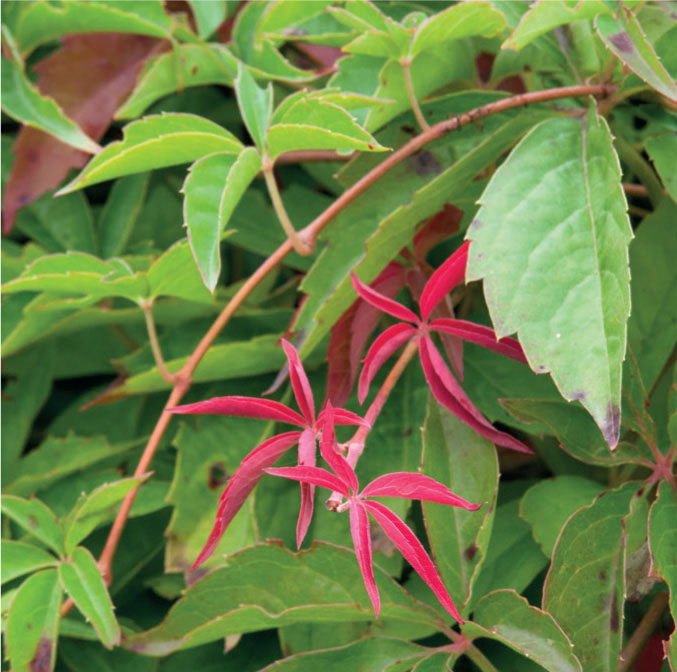
Water-fern Azolla filiculoides and A. caroliniana
Creating a reddish mat of floating, tiny, lobed leaves that block the light from ponds, control requires painstaking removal with a net.

Waterweed, Curly Lagarosiphon major/Elodea crispa
This submerged pondweed from southern Africa with long stems is similar to Hornwort but the whorled leaves curl tightly around the stems. Control by hand-pulling.
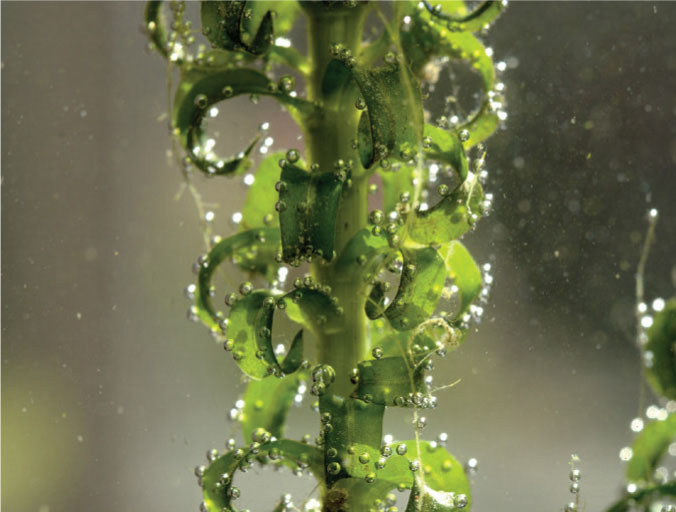
Water-hyacinth Eichhornia crassipes
From tropical America, this free-floating plant has violet flowers plus fleshy leaves that act like sails. It is one of the most invasive water plants in the world but has yet to establish itself in the wild in the British Isles – the situation needs to stay that way!

